-
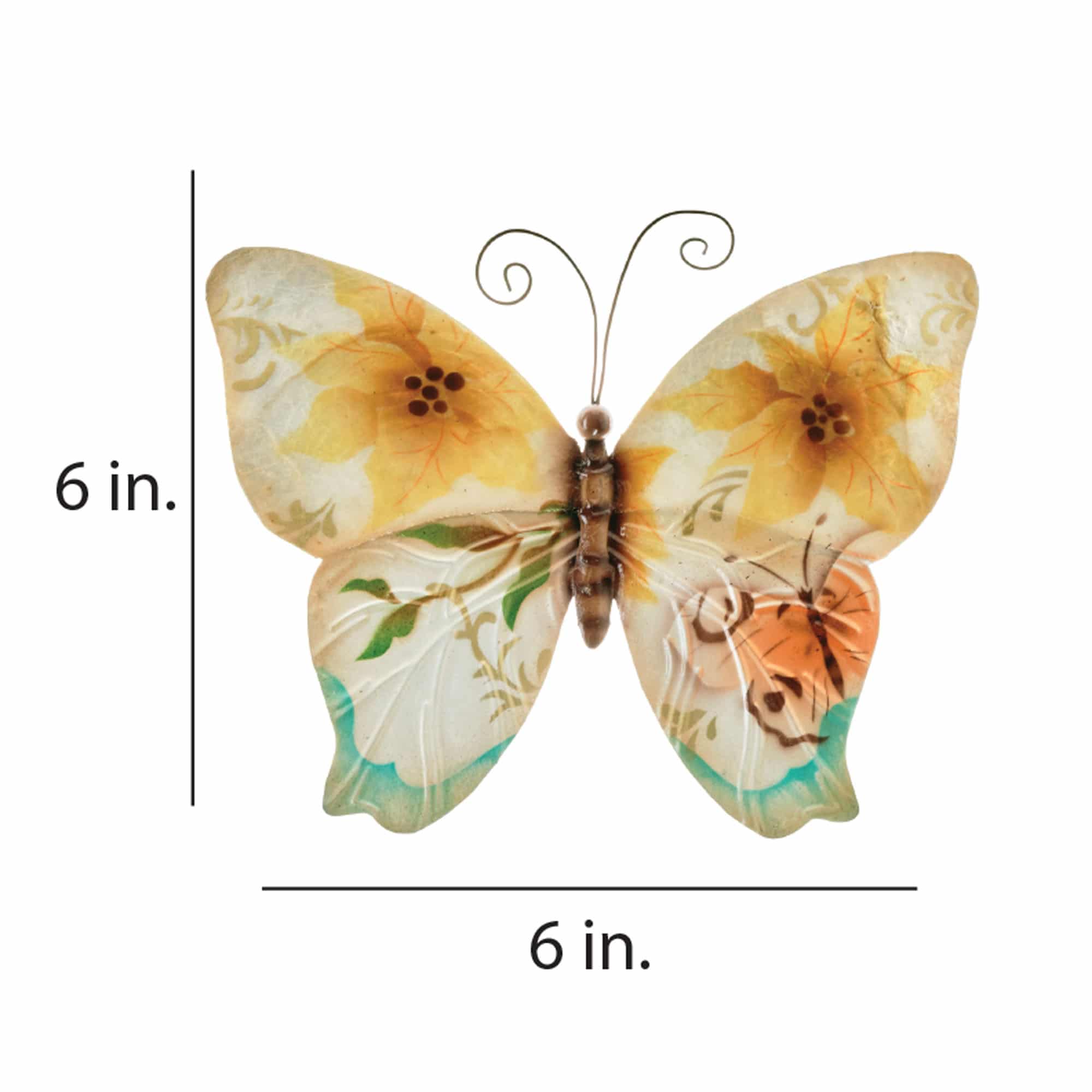
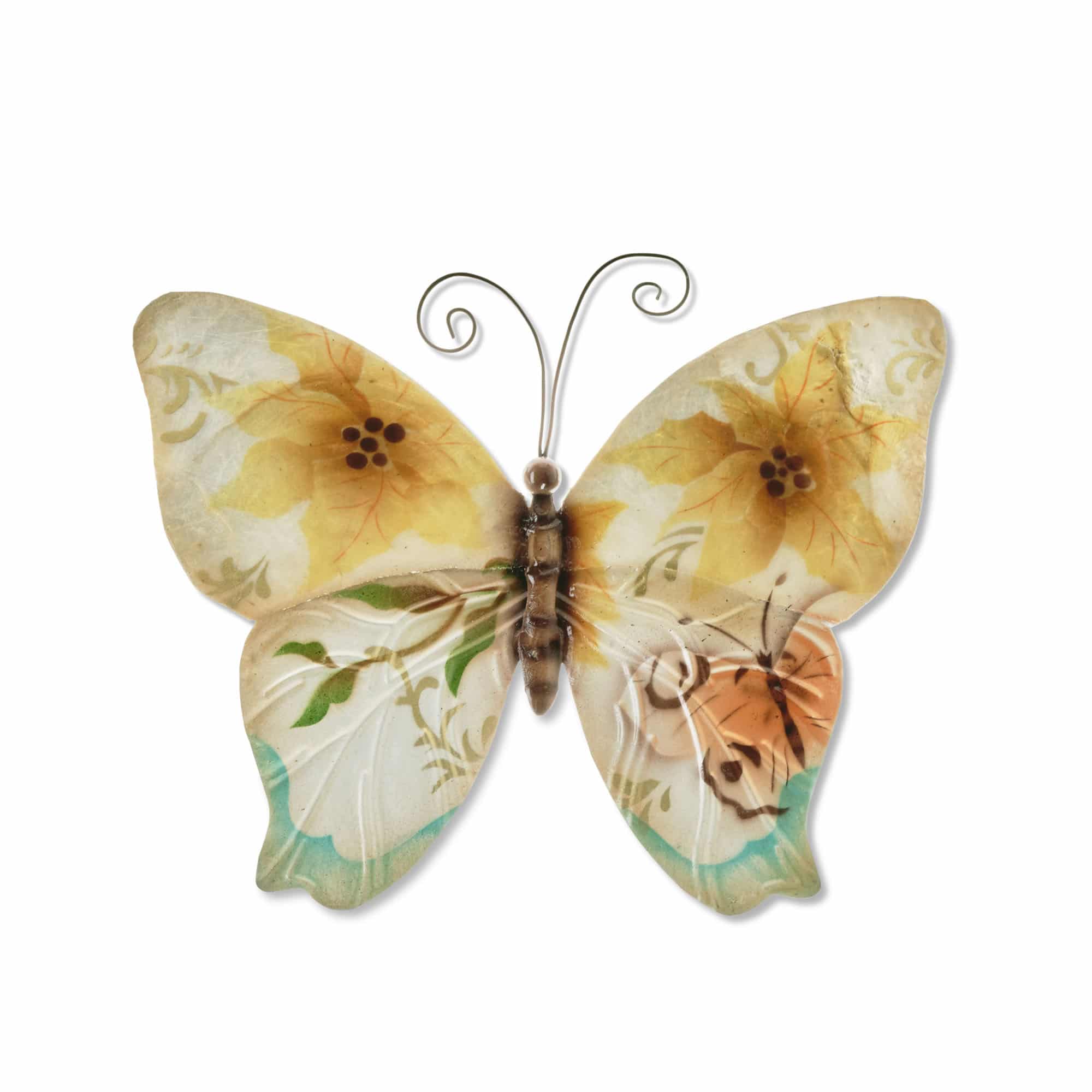 Small and graceful, the sunflower butterfly features soft colors with a mix of flower and leaf patterns to create warmth. A mix of metal and capiz shell, this perfectly crafted butterfly is meant as an extra touch of color and visual interest in a small space. The basic frame of the butterfly is created using tin, which is powder-coated with a black finish and makes this piece safe to use outdoors. The edges of the frame are reinforced using thicker tin wire. The front of this piece is adorned in areas with capiz shell, an oyster native to the Philippines, before being hand-painted and sealed with a water-based sealant. The primary purpose of this oyster to provide a source of food, however, the shell is a sustainable by-product that can be used for decoration. The capiz shell subtly replicates the reflective qualities of butterflies in nature. The entire piece is lightweight and has an eyelet in the back allowing it to be hung using a finishing nail, command strip, or a push pin. Due to it being a natural material, the organic colors of capiz come through as tans and browns underneath the paint.
Small and graceful, the sunflower butterfly features soft colors with a mix of flower and leaf patterns to create warmth. A mix of metal and capiz shell, this perfectly crafted butterfly is meant as an extra touch of color and visual interest in a small space. The basic frame of the butterfly is created using tin, which is powder-coated with a black finish and makes this piece safe to use outdoors. The edges of the frame are reinforced using thicker tin wire. The front of this piece is adorned in areas with capiz shell, an oyster native to the Philippines, before being hand-painted and sealed with a water-based sealant. The primary purpose of this oyster to provide a source of food, however, the shell is a sustainable by-product that can be used for decoration. The capiz shell subtly replicates the reflective qualities of butterflies in nature. The entire piece is lightweight and has an eyelet in the back allowing it to be hung using a finishing nail, command strip, or a push pin. Due to it being a natural material, the organic colors of capiz come through as tans and browns underneath the paint. -
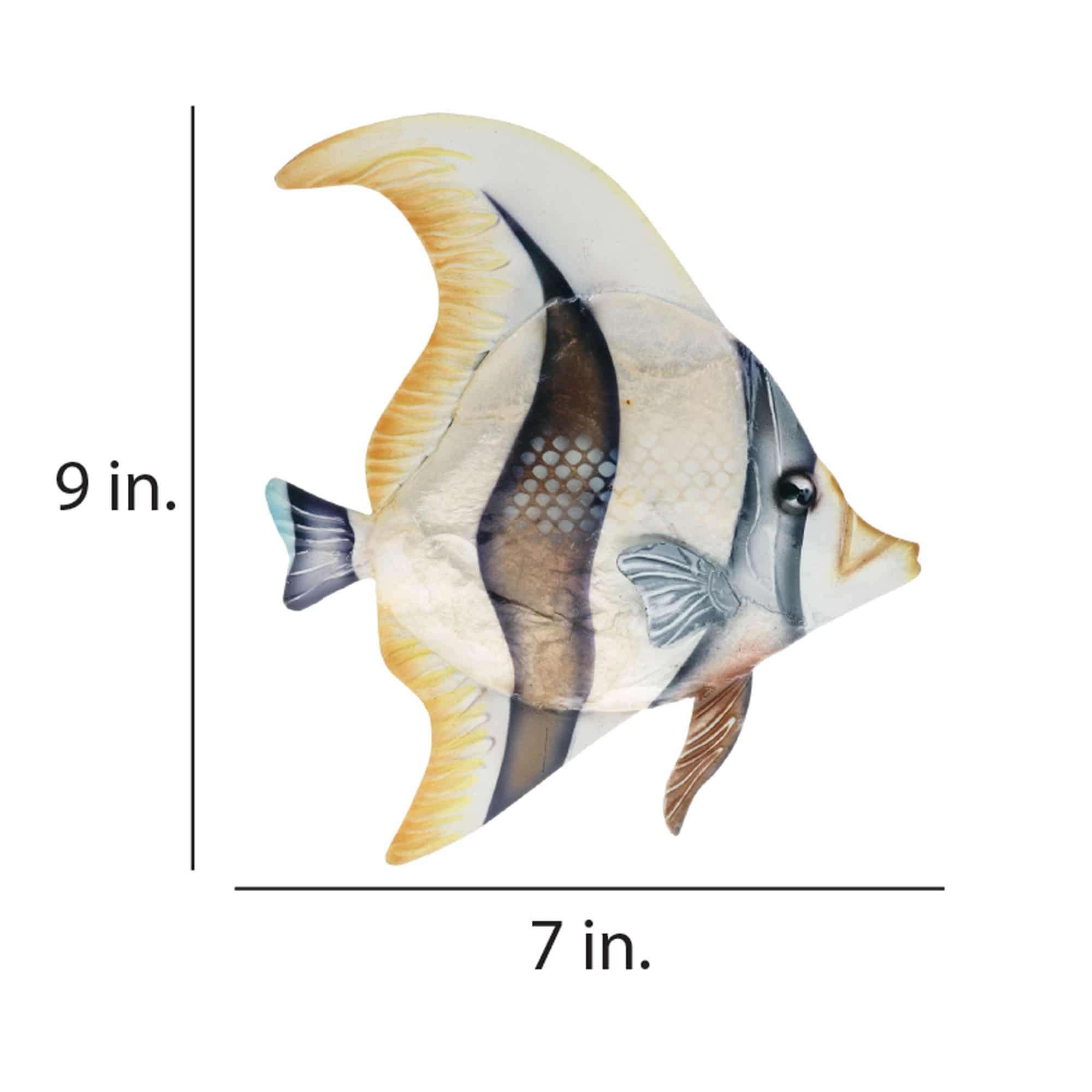
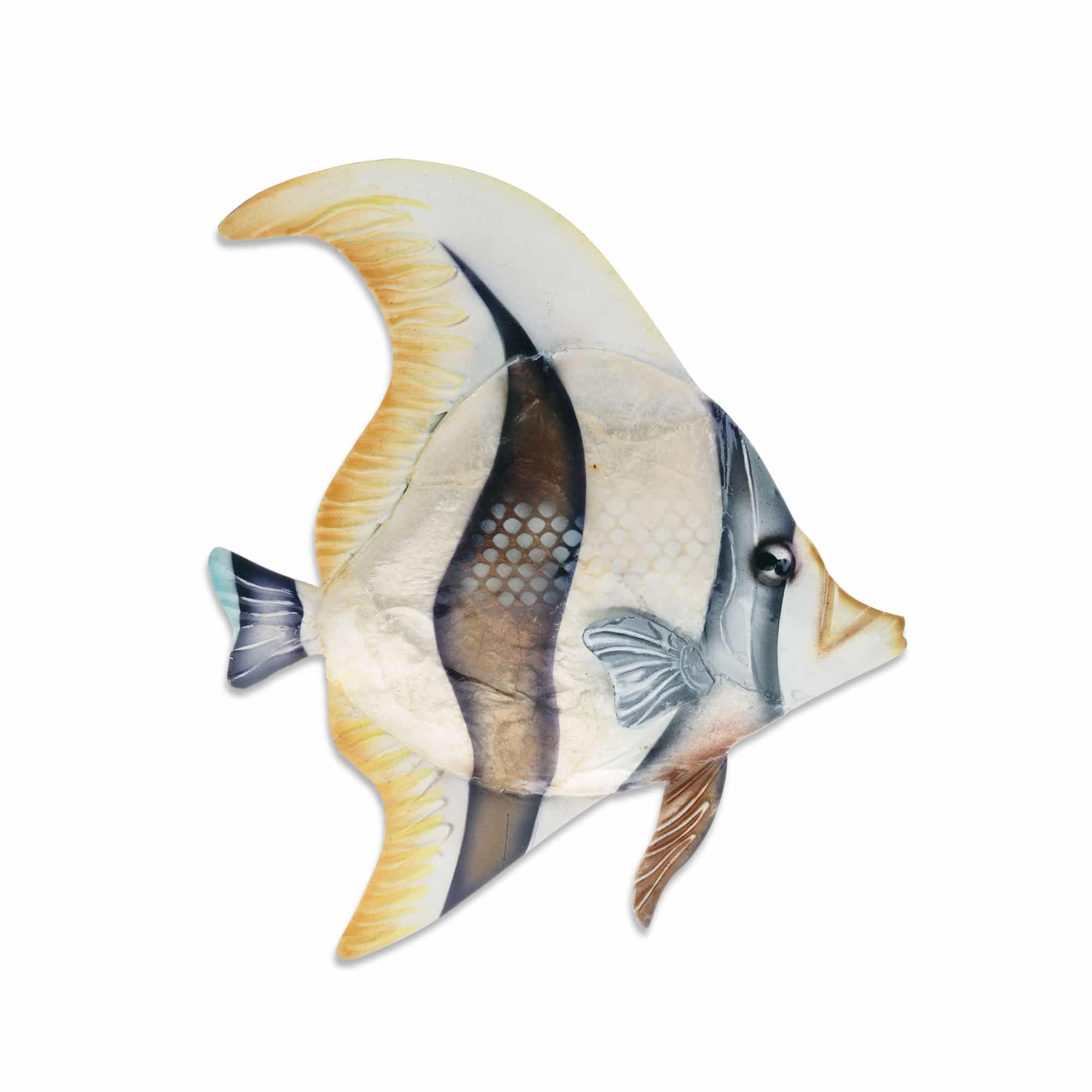 With its contrast of black and yellow and long iconic dorsal fin, the Moorish Idol Angle is well recognized by aquatic hobbyist and novices alike. This moderately peaceful fish is found throughout the southern hemisphere. The artist took great care on showing the big details common to the fish, but on closer examination one will see some color variations and shading in the paint itself. The scales of the Angelfish is pronounced using capiz shell throughout the body of the fish, so when one hangs this fish up it will reflect and bounce the light in different ways. The basic frame of the Moorish Idol Angelfish Wall Decor is created using tin, which is powder coated as a black finish. The frame is reinforced using wrought iron wire along the inner edge. Capiz is an oyster shell and the primary purpose of the oyster is as a source of food. However, the by-product, the shell, can be used for decoration. Due to it being a natural material, the natural colors of the capiz can come through as tans and browns underneath the paint.
With its contrast of black and yellow and long iconic dorsal fin, the Moorish Idol Angle is well recognized by aquatic hobbyist and novices alike. This moderately peaceful fish is found throughout the southern hemisphere. The artist took great care on showing the big details common to the fish, but on closer examination one will see some color variations and shading in the paint itself. The scales of the Angelfish is pronounced using capiz shell throughout the body of the fish, so when one hangs this fish up it will reflect and bounce the light in different ways. The basic frame of the Moorish Idol Angelfish Wall Decor is created using tin, which is powder coated as a black finish. The frame is reinforced using wrought iron wire along the inner edge. Capiz is an oyster shell and the primary purpose of the oyster is as a source of food. However, the by-product, the shell, can be used for decoration. Due to it being a natural material, the natural colors of the capiz can come through as tans and browns underneath the paint. -

 The clown fish is one of the most iconic saltwater fish in the world. The artist wanted to make sure to capture this fish and all of what makes him stand out; therefore, instead of just a solid orange, the orange portrayed in varying shades to signify the variation one would see when up close to the fish. The scales of the Clown fish is enhanced by using capiz shell throughout the body of the fish, so when one hangs this fish up it will reflect and bounce the light in different ways. The basic frame of the wall fish is created using tin, which is powder coated as a black finish. The frame is reinforced using wrought iron wire along the inner edge. Capiz is an oyster shell and the primary purpose of the oyster is as a source of food. However, the by-product, the shell, can be used for decoration. Due to it being a natural material, the natural colors of the capiz can come through as tans and browns underneath the paint.
The clown fish is one of the most iconic saltwater fish in the world. The artist wanted to make sure to capture this fish and all of what makes him stand out; therefore, instead of just a solid orange, the orange portrayed in varying shades to signify the variation one would see when up close to the fish. The scales of the Clown fish is enhanced by using capiz shell throughout the body of the fish, so when one hangs this fish up it will reflect and bounce the light in different ways. The basic frame of the wall fish is created using tin, which is powder coated as a black finish. The frame is reinforced using wrought iron wire along the inner edge. Capiz is an oyster shell and the primary purpose of the oyster is as a source of food. However, the by-product, the shell, can be used for decoration. Due to it being a natural material, the natural colors of the capiz can come through as tans and browns underneath the paint. -
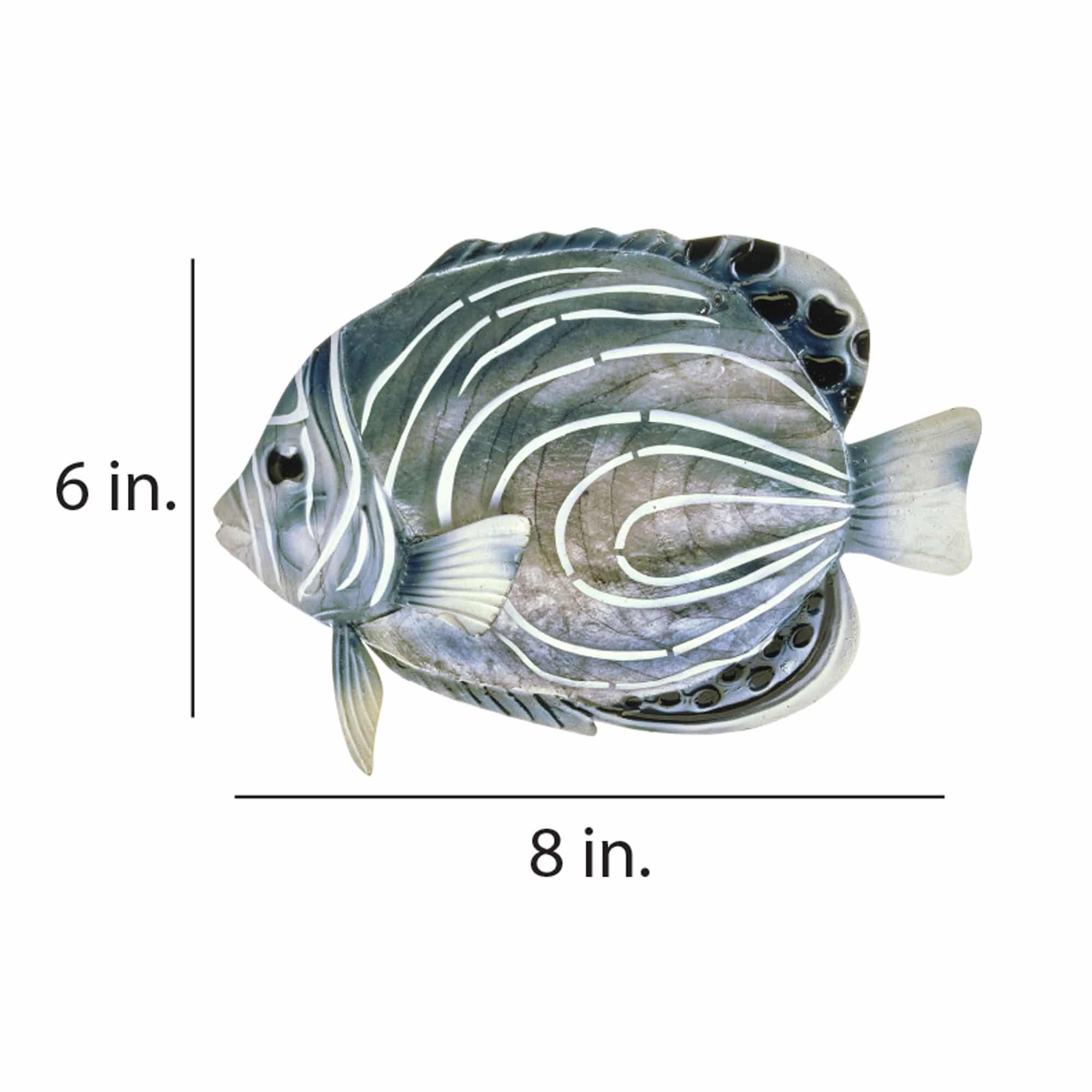
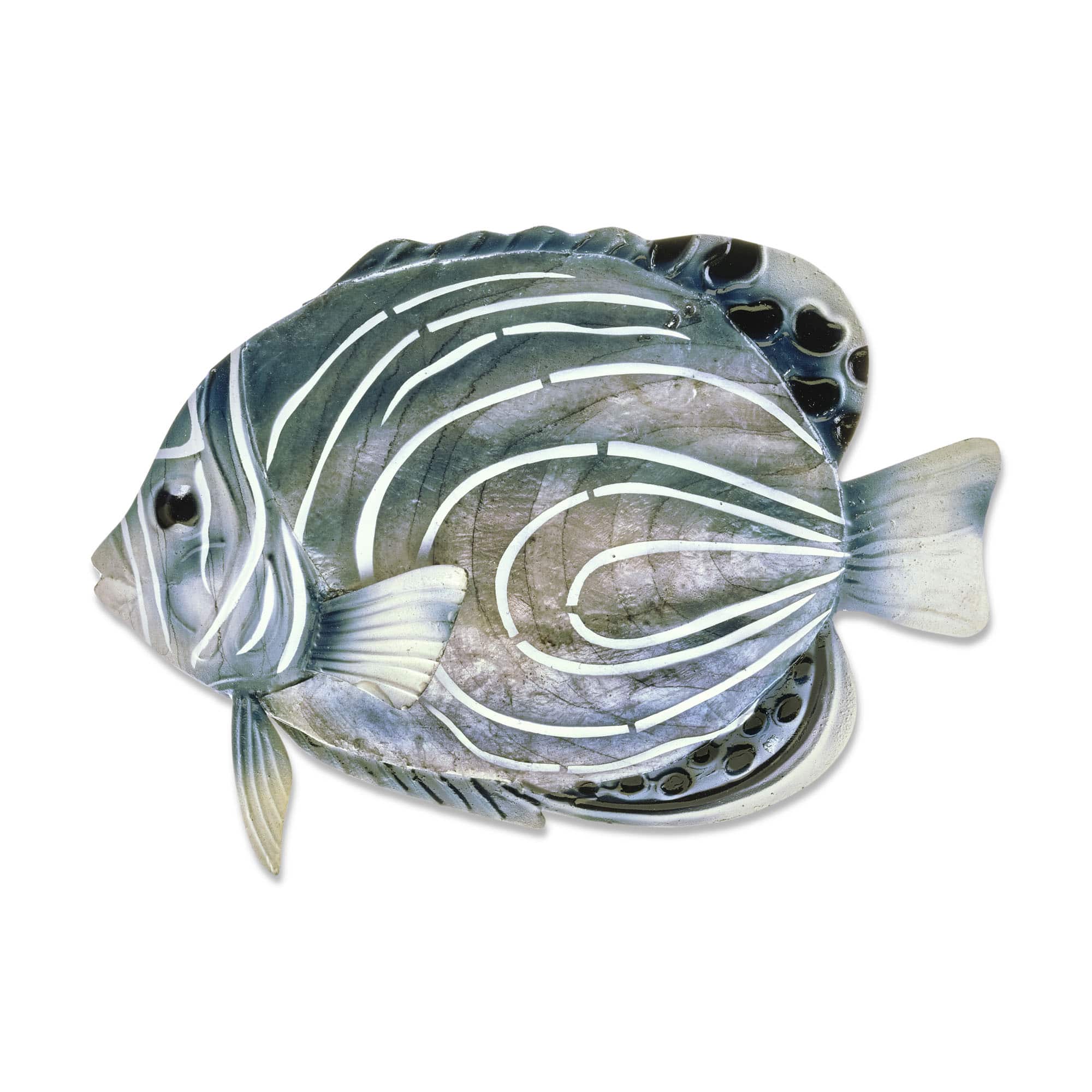 As many things in nature, the Koran Angelfish changes as it matures. As a juvenile, it is known to have white semi-circle lines on a striking blue body. But few things in nature are a solid color, and the artist recognized that as well. Using different techniques, up close, one can see the different shades of blue. The scales of the Angelfish are enhanced by using capiz shell throughout the body of the fish, so when one hangs this fish up it will reflect and bounce the light in different ways. The basic frame of the wall fish is created using tin, which is powder coated as a black finish. The frame is reinforced using wrought iron wire along the inner edge. Capiz is an oyster shell and the primary purpose of the oyster is as a source of food. However, the by-product, the shell, can be used for decoration. Due to it being a natural material, the natural colors of the capiz can come through as tans and browns underneath the paint.
As many things in nature, the Koran Angelfish changes as it matures. As a juvenile, it is known to have white semi-circle lines on a striking blue body. But few things in nature are a solid color, and the artist recognized that as well. Using different techniques, up close, one can see the different shades of blue. The scales of the Angelfish are enhanced by using capiz shell throughout the body of the fish, so when one hangs this fish up it will reflect and bounce the light in different ways. The basic frame of the wall fish is created using tin, which is powder coated as a black finish. The frame is reinforced using wrought iron wire along the inner edge. Capiz is an oyster shell and the primary purpose of the oyster is as a source of food. However, the by-product, the shell, can be used for decoration. Due to it being a natural material, the natural colors of the capiz can come through as tans and browns underneath the paint. -
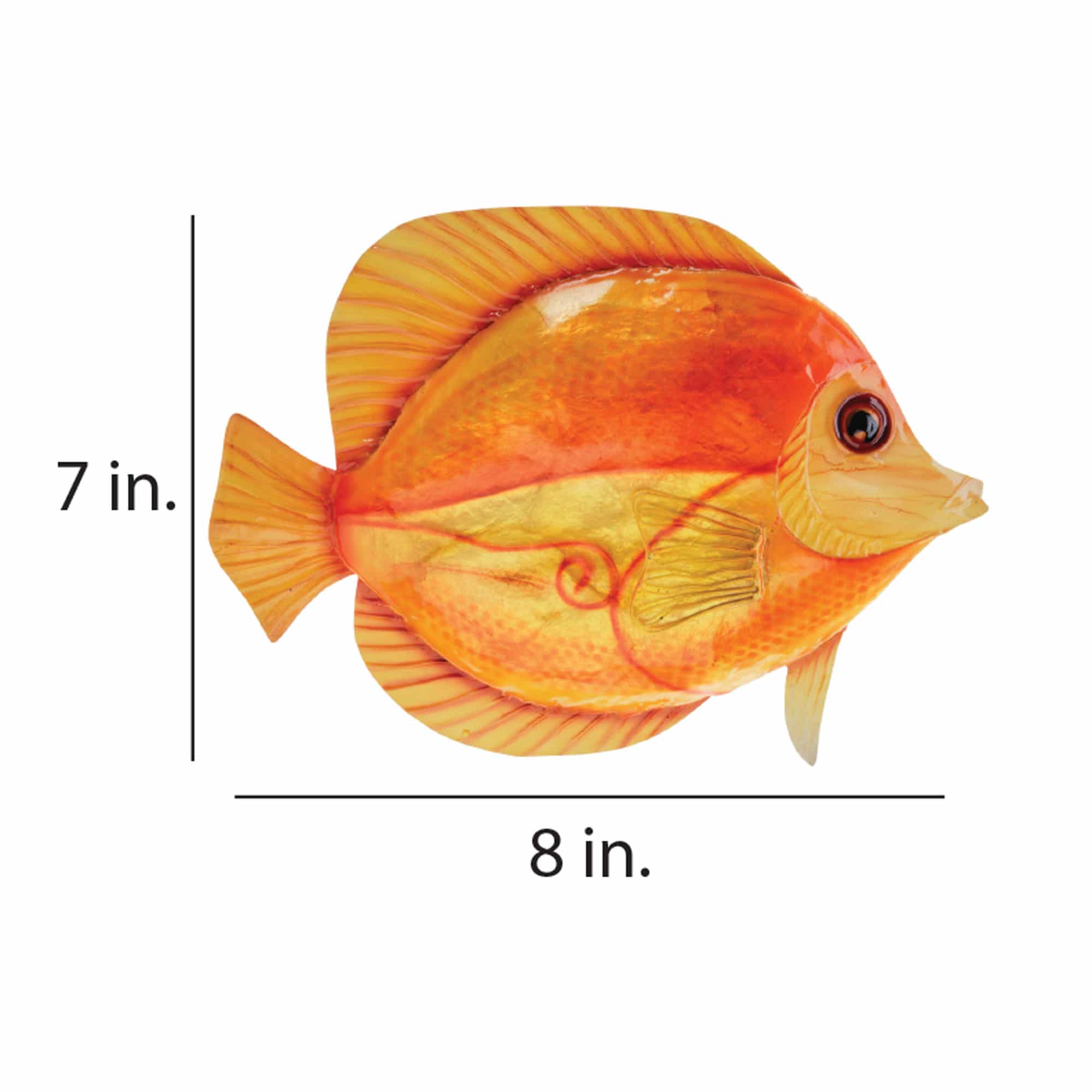
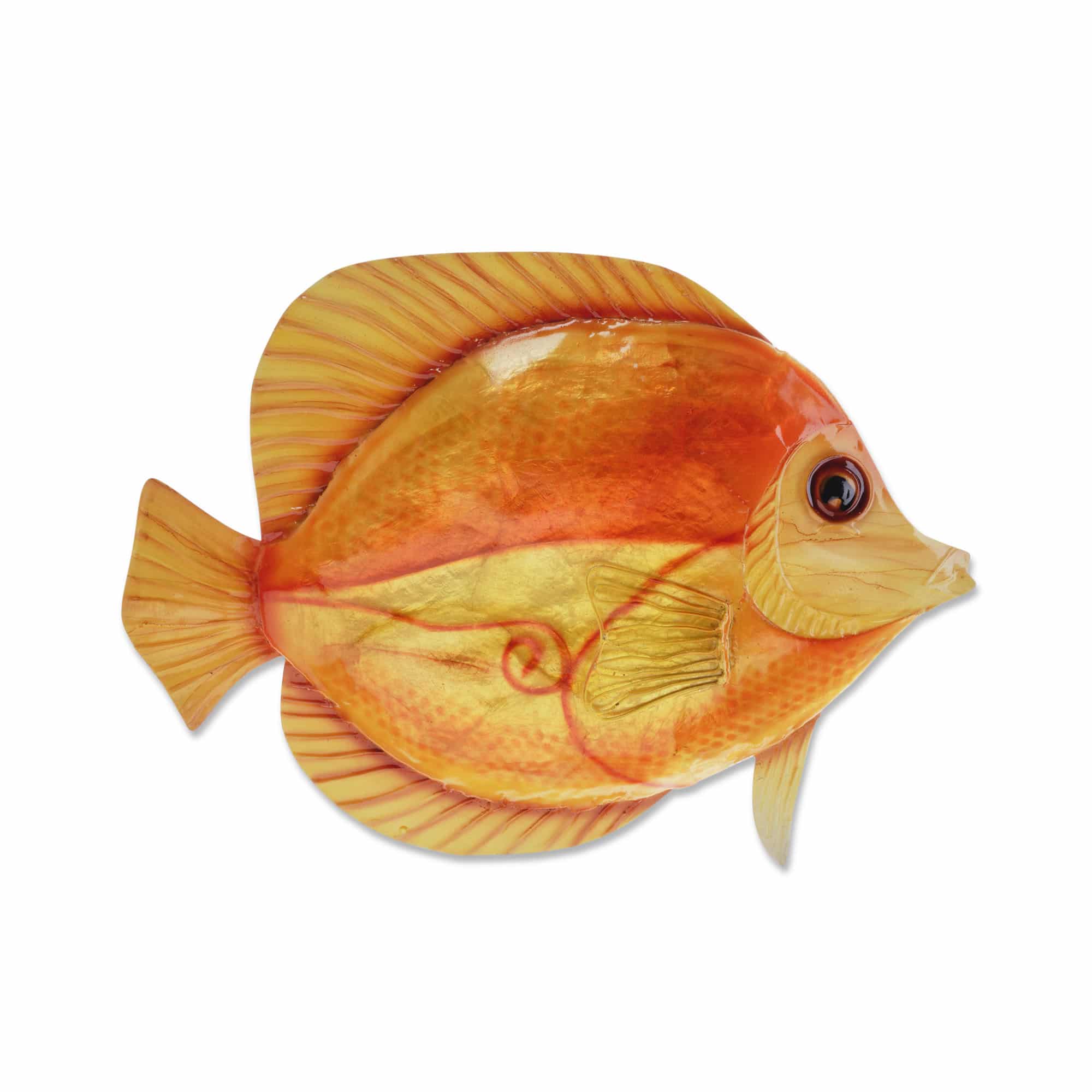 The discus fish is native to the Amazon river basin. These fish are known for their distinctive shape, bright colors, and unique patterns. The artist who painted this fish paid attention to the interacting color patterns. Using capiz shell, he emulated the natural scales of this fish. The basic frame of the wall fish is created using tin, which is powder coated as a black finish. The frame is reinforced using wrought iron wire along the inner edge. Capiz is an oyster shell and the primary purpose of the oyster is as a source of food. However, the by-product, the shell, can be used for decoration. Due to it being a natural material, the natural colors of the capiz can come through as tans and browns underneath the paint.
The discus fish is native to the Amazon river basin. These fish are known for their distinctive shape, bright colors, and unique patterns. The artist who painted this fish paid attention to the interacting color patterns. Using capiz shell, he emulated the natural scales of this fish. The basic frame of the wall fish is created using tin, which is powder coated as a black finish. The frame is reinforced using wrought iron wire along the inner edge. Capiz is an oyster shell and the primary purpose of the oyster is as a source of food. However, the by-product, the shell, can be used for decoration. Due to it being a natural material, the natural colors of the capiz can come through as tans and browns underneath the paint. -
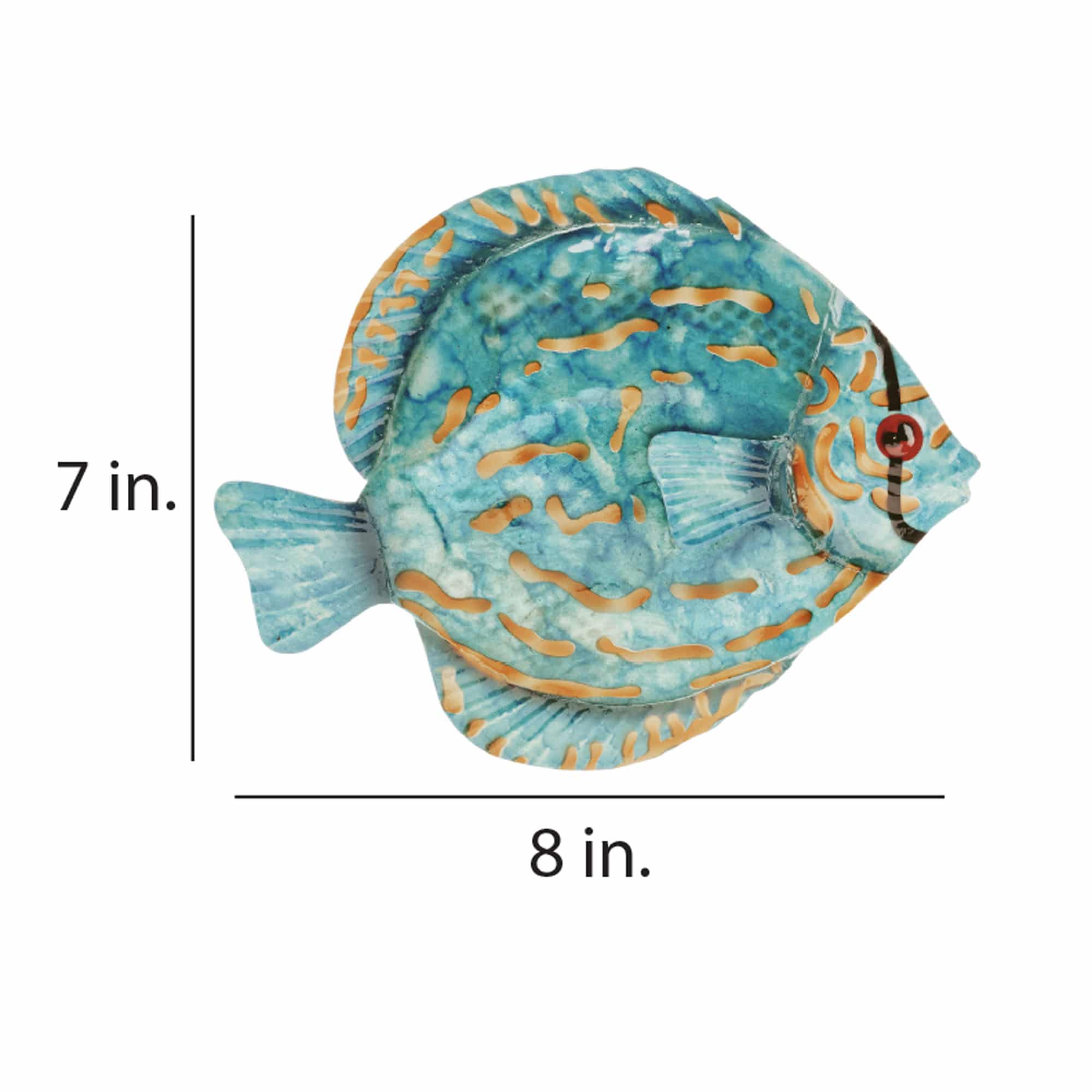
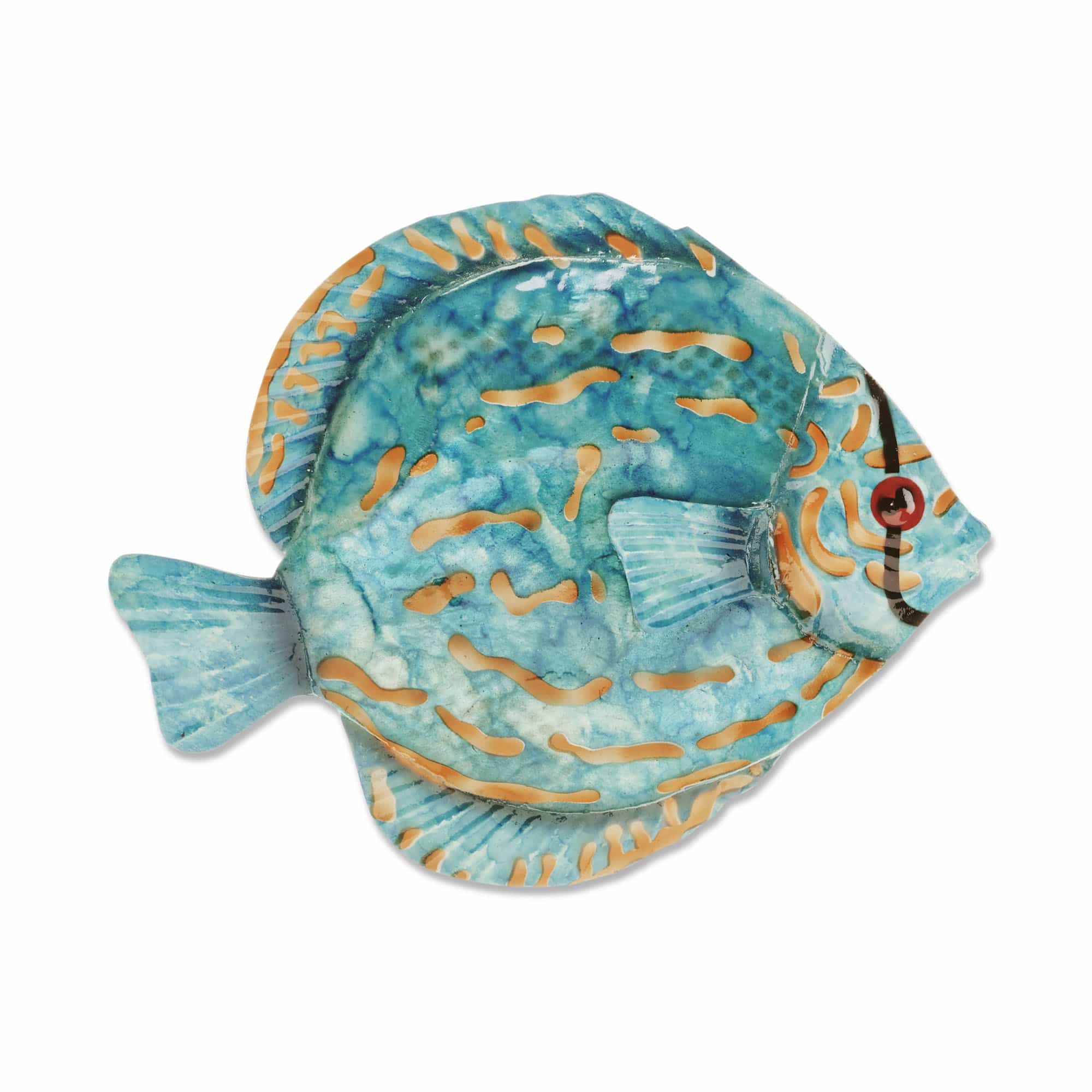 The discus fish is native to the Amazon river basin. These fish are known for their distinctive shape, bright colors, and unique patterns. The artist who painted this fish paid attention to the interact color patterns. Using capiz shell, he emulated the natural scales of this fish. The basic frame of the wall fish is created using tin, which is powder coated as a black finish. The frame is reinforced using wrought iron wire along the inner edge. Capiz is an oyster shell and the primary purpose of the oyster is as a source of food. However, the by-product, the shell, can be used for decoration. Due to it being a natural material, the natural colors of the capiz can come through as tans and browns underneath the paint.
The discus fish is native to the Amazon river basin. These fish are known for their distinctive shape, bright colors, and unique patterns. The artist who painted this fish paid attention to the interact color patterns. Using capiz shell, he emulated the natural scales of this fish. The basic frame of the wall fish is created using tin, which is powder coated as a black finish. The frame is reinforced using wrought iron wire along the inner edge. Capiz is an oyster shell and the primary purpose of the oyster is as a source of food. However, the by-product, the shell, can be used for decoration. Due to it being a natural material, the natural colors of the capiz can come through as tans and browns underneath the paint. -
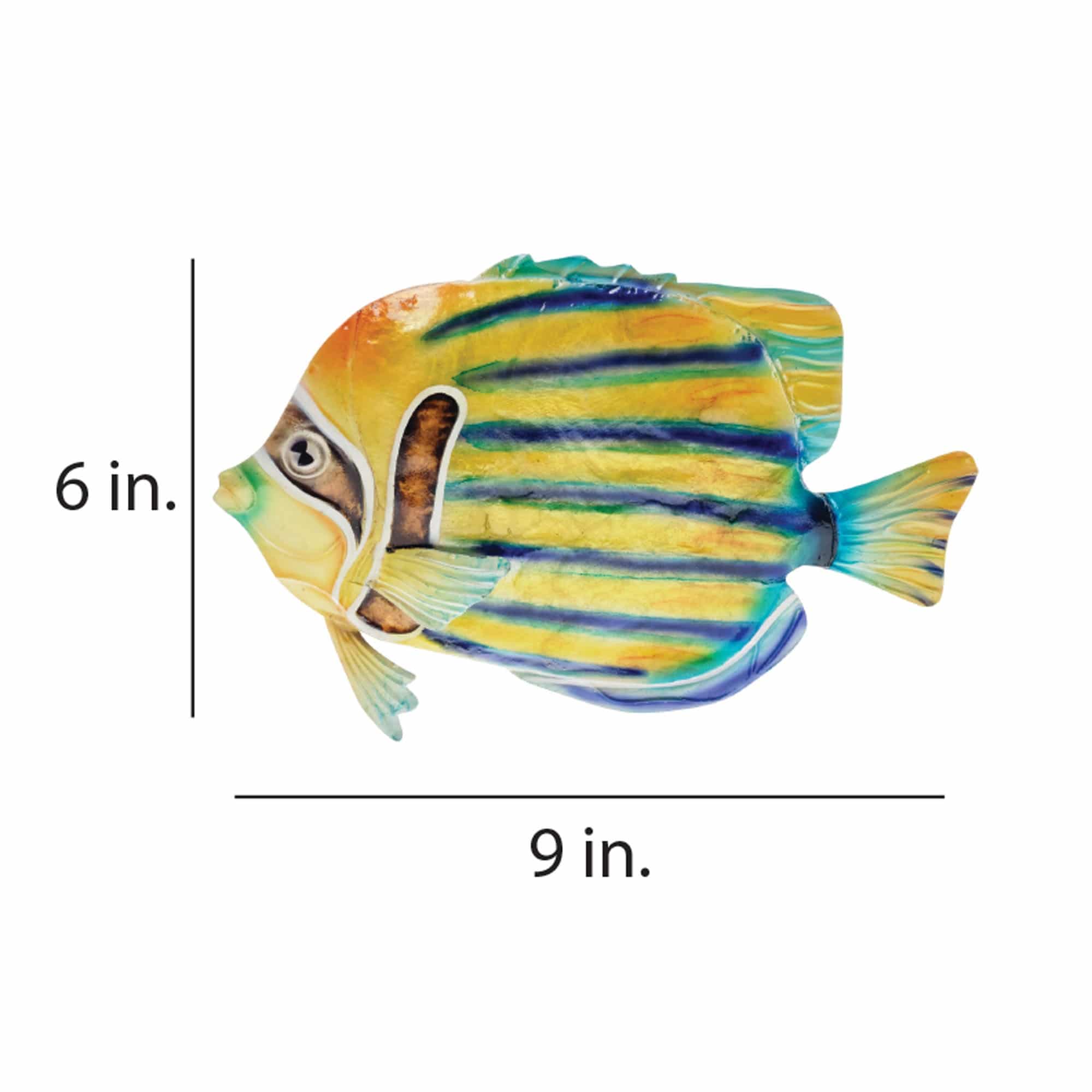
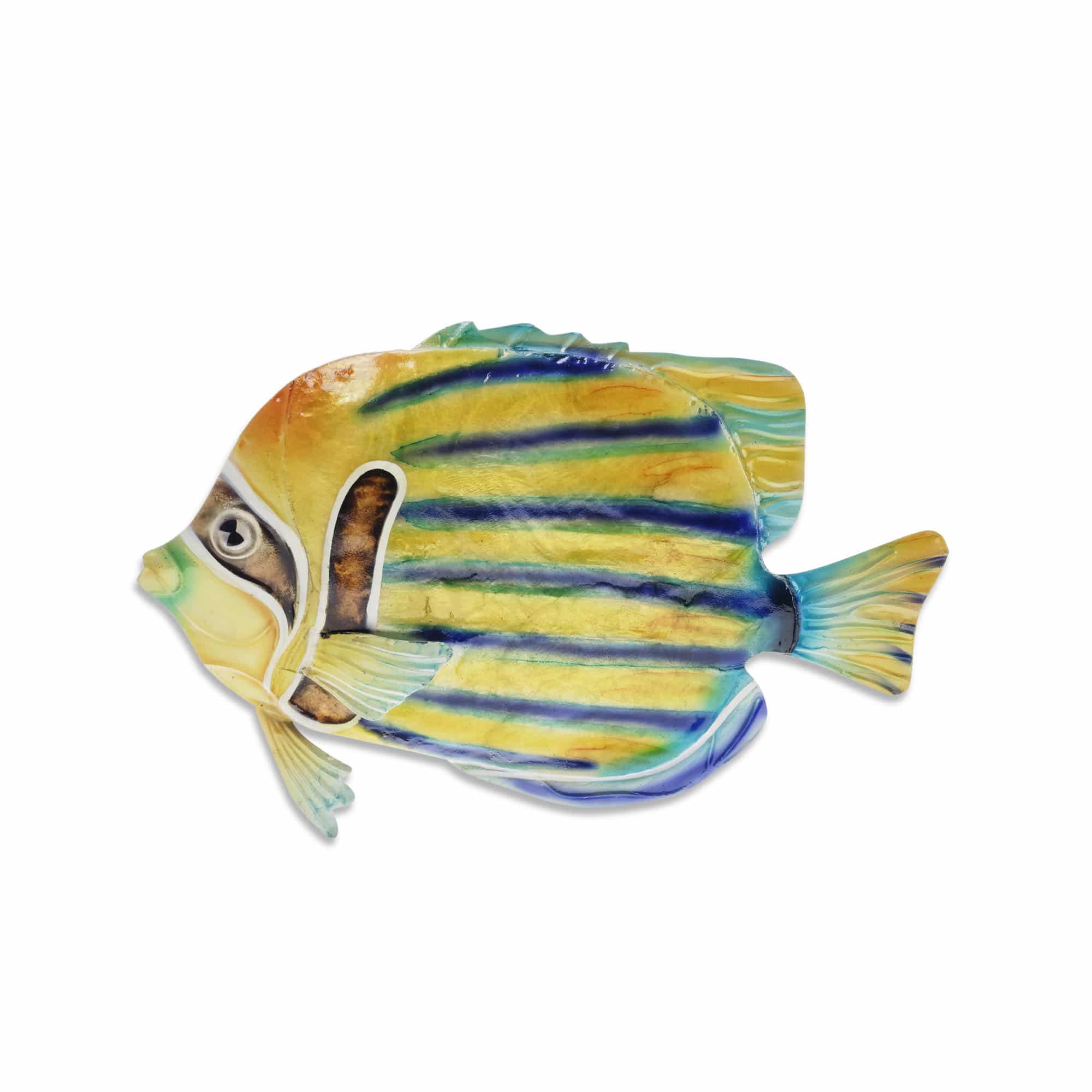 As many things in nature, the Striped Angelfish changes as it matures. This is due to alterations in its multiple dermis layers. But few things in nature are a solid color, and the artist recognized that as well. Using different techniques, up close, one can see the different shades of blue. The scales of the Angelfish are enhanced by using capiz shell throughout the body of the fish, so when one hangs this fish up it will reflect and bounce the light in different ways. The basic frame of the wall fish is created using tin, which is powder coated as a black finish. The frame is reinforced using wrought iron wire along the inner edge. Capiz is an oyster shell and the primary purpose of the oyster is as a source of food. However, the by-product, the shell, can be used for decoration. Due to it being a natural material, the natural colors of the capiz can come through as tans and browns underneath the paint.
As many things in nature, the Striped Angelfish changes as it matures. This is due to alterations in its multiple dermis layers. But few things in nature are a solid color, and the artist recognized that as well. Using different techniques, up close, one can see the different shades of blue. The scales of the Angelfish are enhanced by using capiz shell throughout the body of the fish, so when one hangs this fish up it will reflect and bounce the light in different ways. The basic frame of the wall fish is created using tin, which is powder coated as a black finish. The frame is reinforced using wrought iron wire along the inner edge. Capiz is an oyster shell and the primary purpose of the oyster is as a source of food. However, the by-product, the shell, can be used for decoration. Due to it being a natural material, the natural colors of the capiz can come through as tans and browns underneath the paint. -
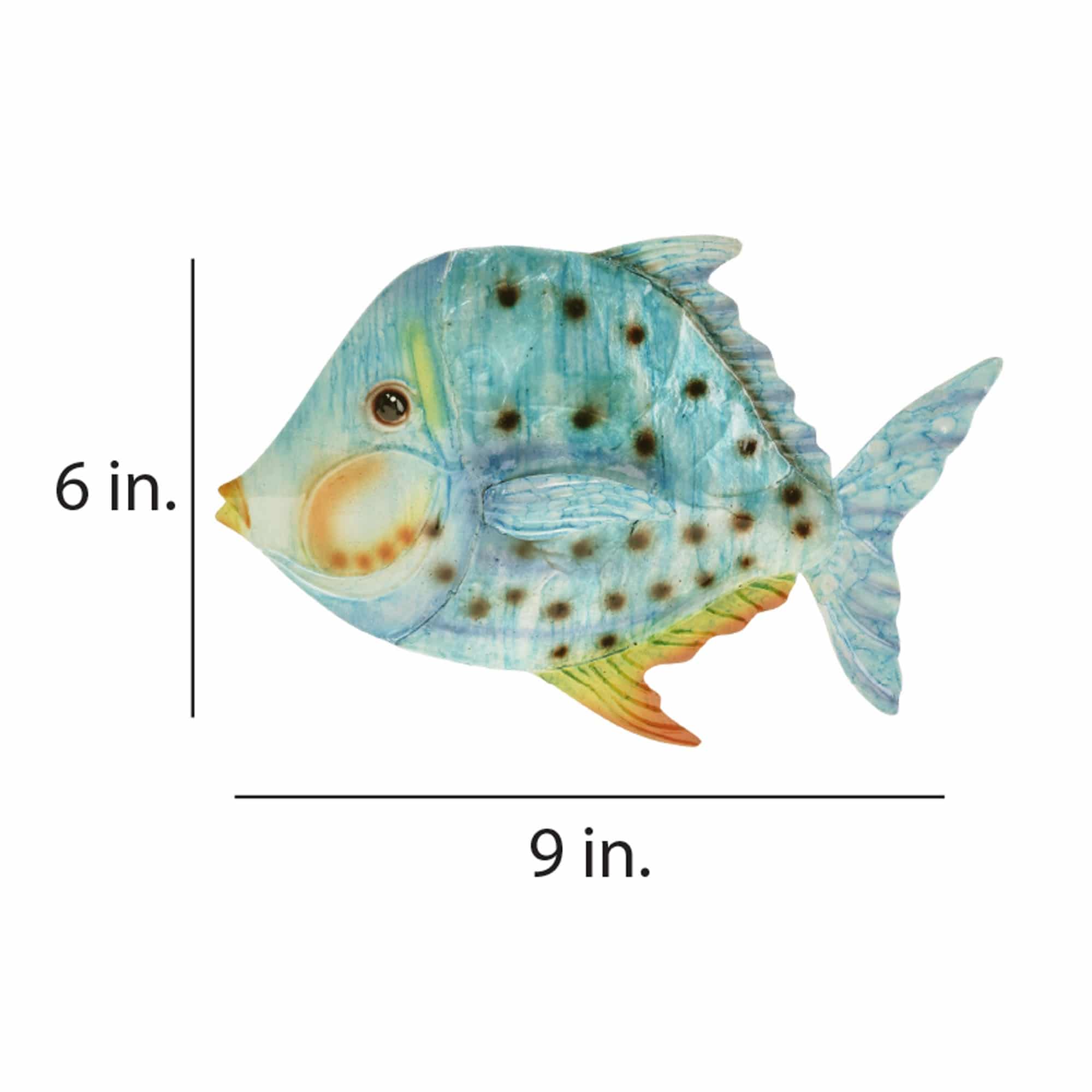
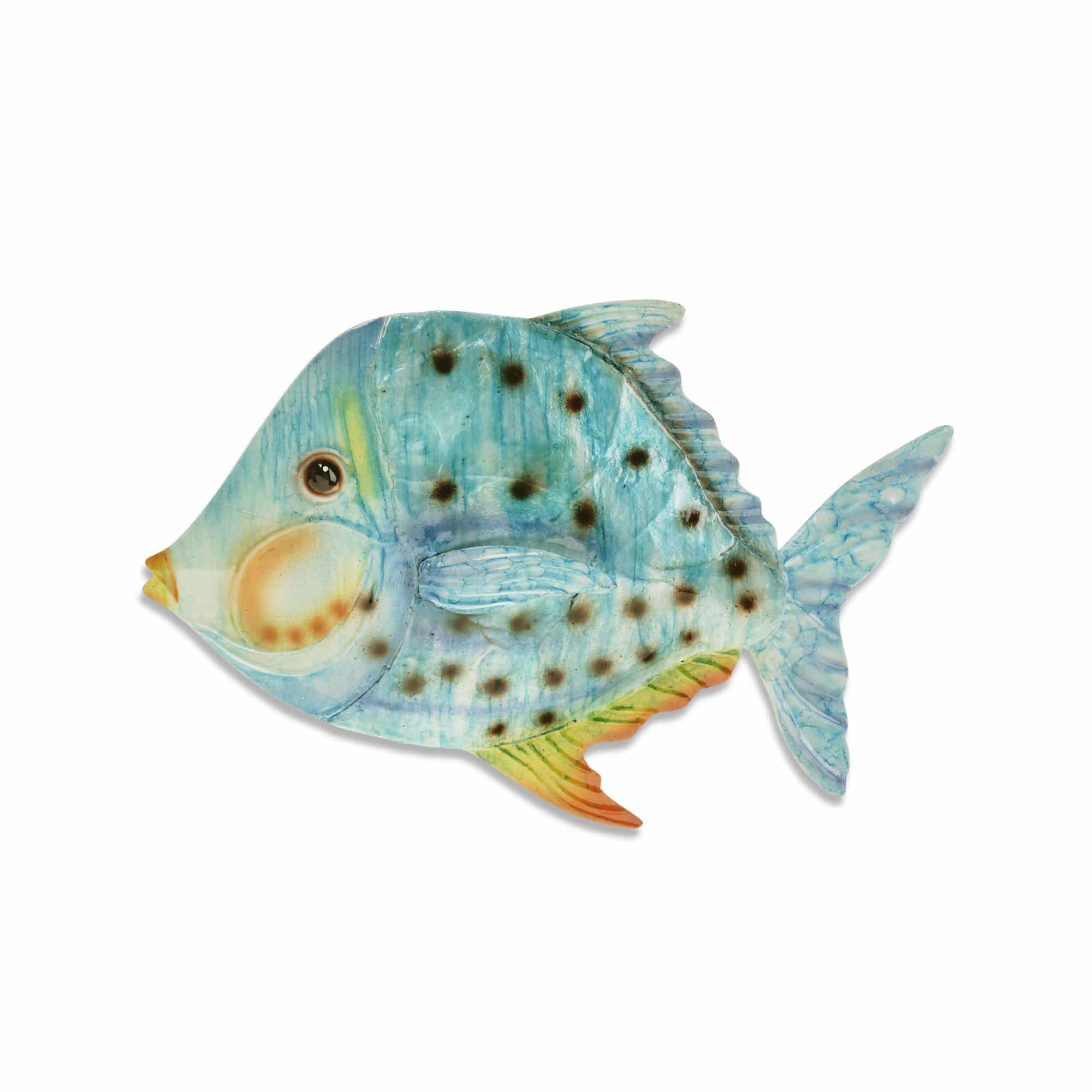 The Caribbean is known for its brightly colored fish. However, the Caribbean silver fish, with its tall forhead and flashy finish can be even more captivating. Found in large schools, this quck fish can change directions in a heartbeat. The artist using capiz shell to capture the shimmer generated as filtered light bounces off its shiny body. The basic frame of the wall fish is created using tin, which is powder coated as a black finish. The frame is reinforced using wrought iron wire along the inner edge. Capiz is an oyster shell and the primary purpose of the oyster is as a source of food. However, the by-product, the shell, can be used for decoration.
The Caribbean is known for its brightly colored fish. However, the Caribbean silver fish, with its tall forhead and flashy finish can be even more captivating. Found in large schools, this quck fish can change directions in a heartbeat. The artist using capiz shell to capture the shimmer generated as filtered light bounces off its shiny body. The basic frame of the wall fish is created using tin, which is powder coated as a black finish. The frame is reinforced using wrought iron wire along the inner edge. Capiz is an oyster shell and the primary purpose of the oyster is as a source of food. However, the by-product, the shell, can be used for decoration. -
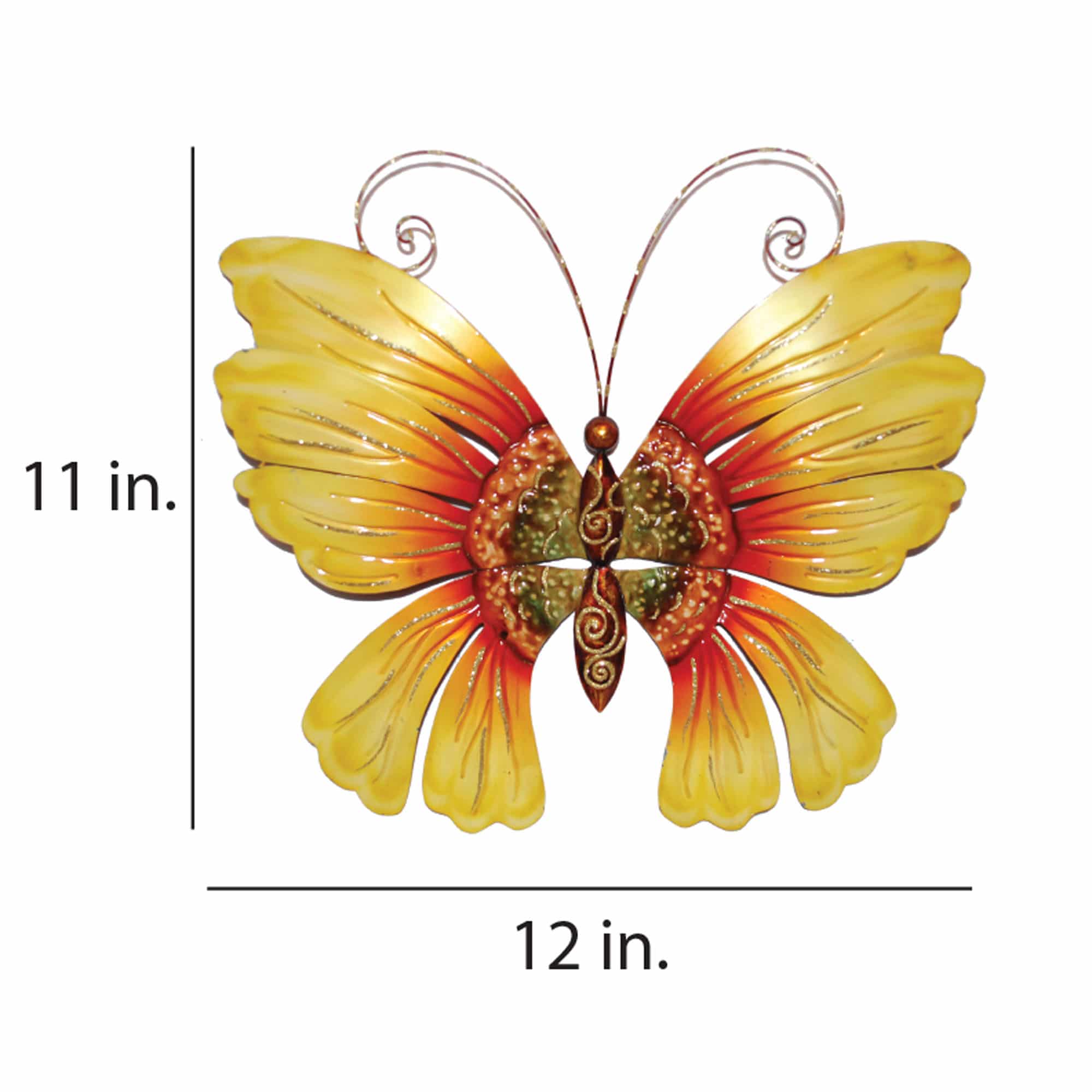
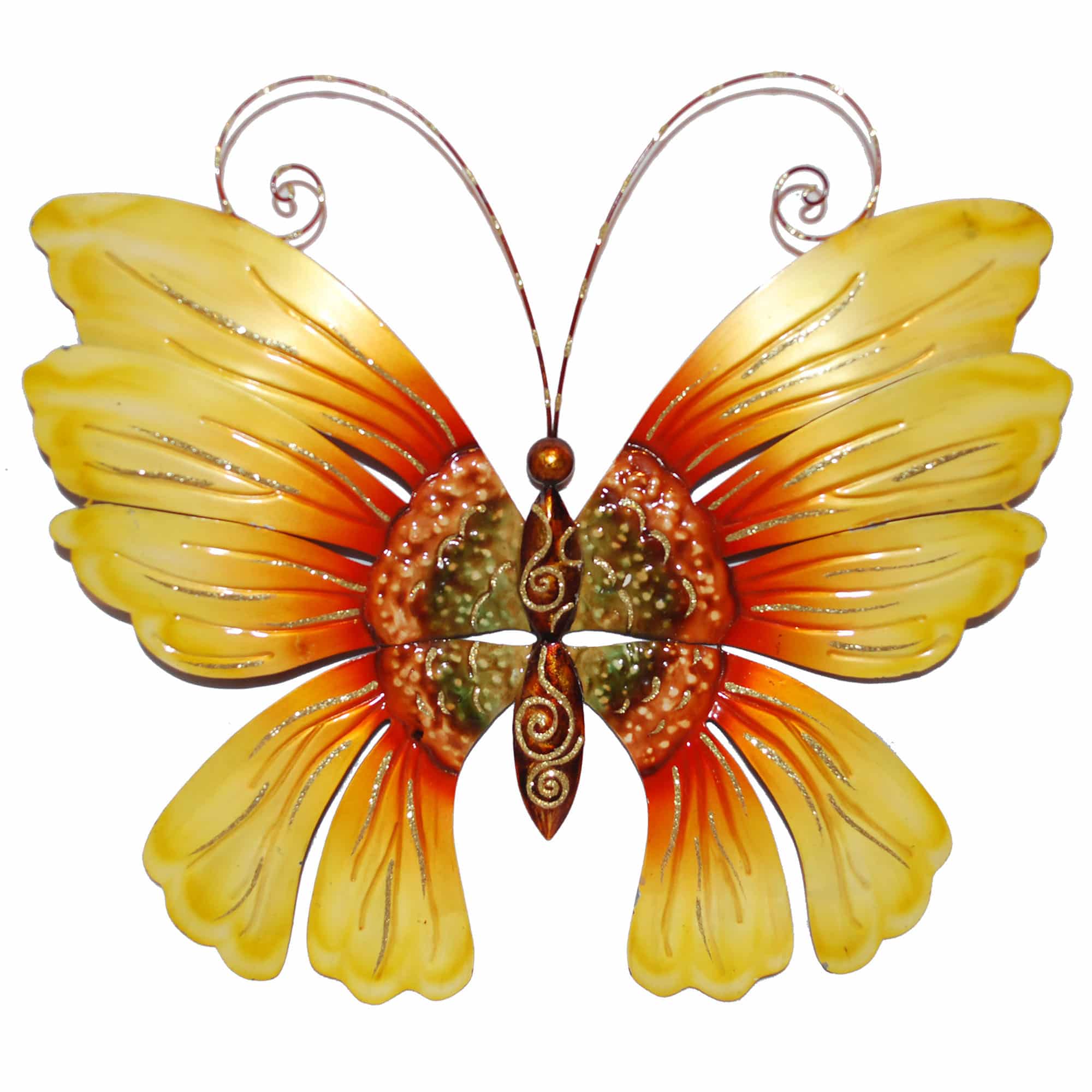
This butterfly echoes the leafy face of a sunflower. The serrated edges of the wings add emphasize the petals while the center of the butterfly mirrors the blossom of a sunflower. No details weren't overlooked, from the center of the butterfly being textured like sunflower seeds, to the gold glitter simulating the reflection of sunlight.
The basic frame of the butterfly is created using tin, which is powder-coated with a black finish and makes this piece safe to use outdoors. The edges of the frame are reinforced using thicker tin wire. The front of this piece is hand-painted and sealed with a water-based sealant. The entire piece is lightweight and has an eyelet in the back allowing it to be hung using a finishing nail, command strip, or a push pin. Due to it being a natural material, the organic colors of capiz come through as tans and browns underneath the paint.
-
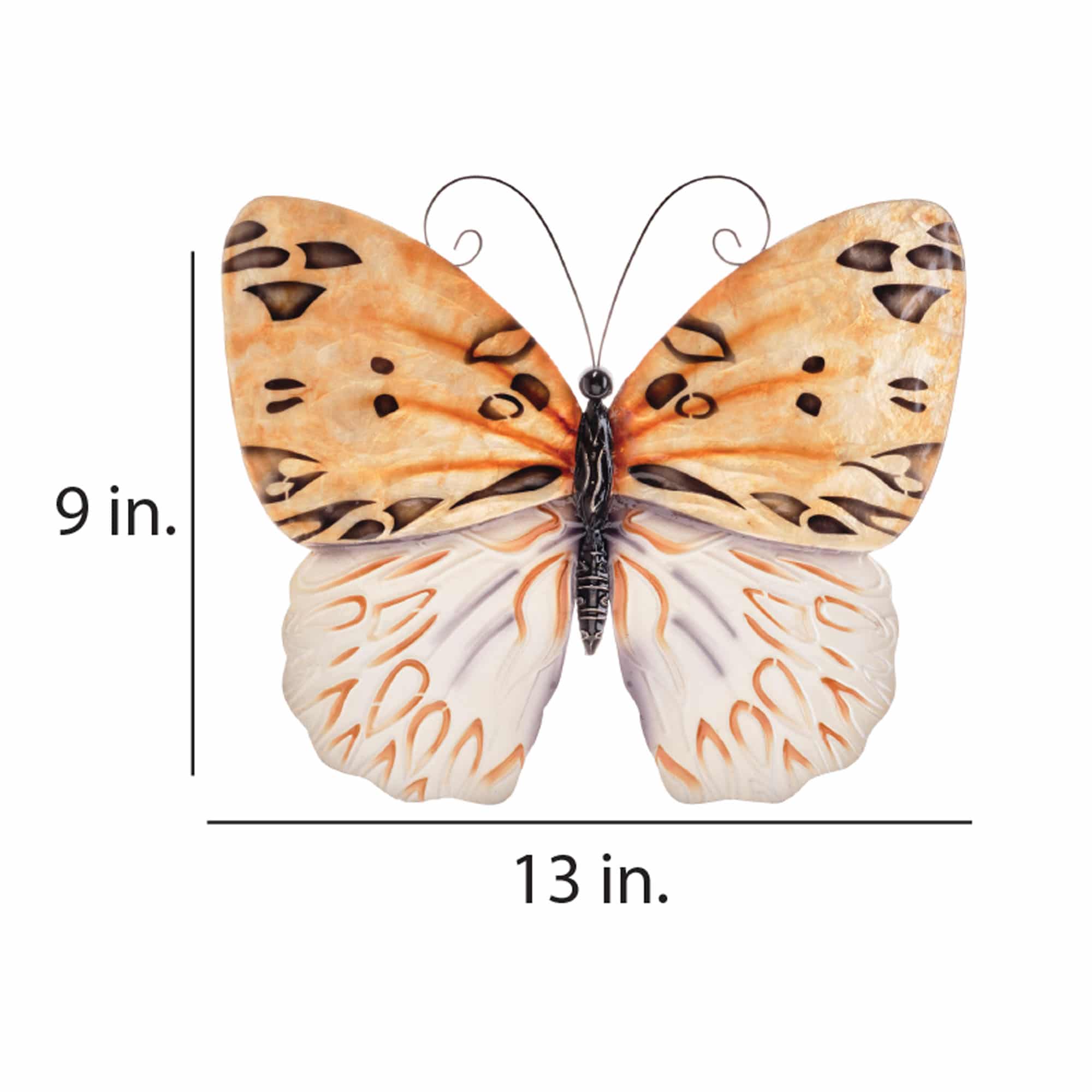
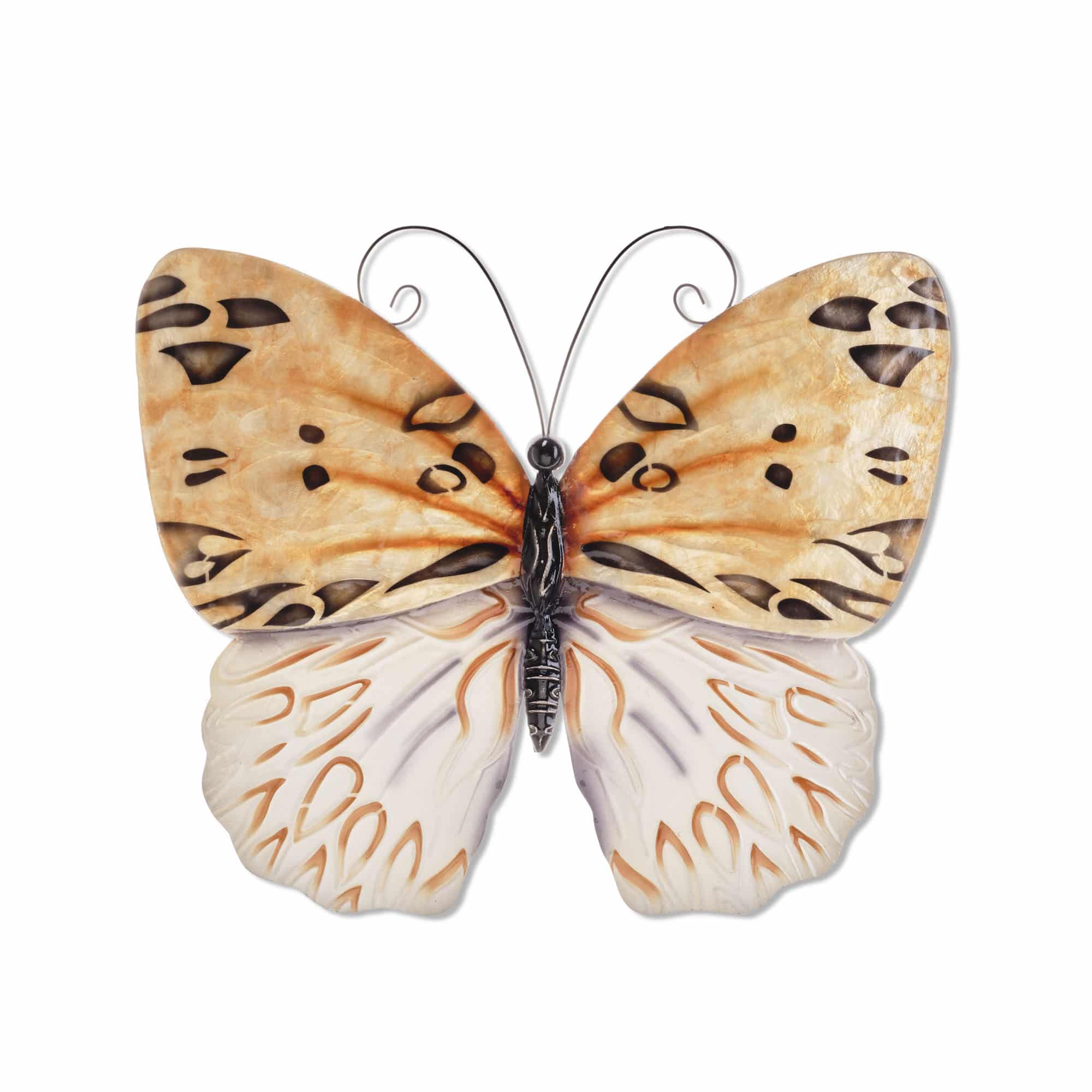
Using paints of various shades and different hues of yellow, this graceful butterfly features an appearance of flowing honey on its upper wings. The lower wings diverge from the honey and are textured in a base white color with highlights of yellow. Stylish and elegant, this piece adds sophistication to the finish of any room, contemporary or traditional.
The basic frame of the butterfly is created using tin, which is powder-coated with a black finish and makes this piece safe to use outdoors. The edges of the frame are reinforced using thicker tin wire. The front of this piece is adorned in areas with capiz shell, an oyster native to the Philippines, before being hand-painted and sealed with a water-based sealant. The primary purpose of this oyster to provide a source of food, however, the shell is a sustainable by-product that can be used for decoration. The capiz shell subtly replicates the reflective qualities of butterflies in nature. The entire piece is lightweight and has an eyelet in the back allowing it to be hung using a finishing nail, command strip, or a push pin. Due to it being a natural material, the organic colors of capiz come through as tans and browns underneath the paint.
-
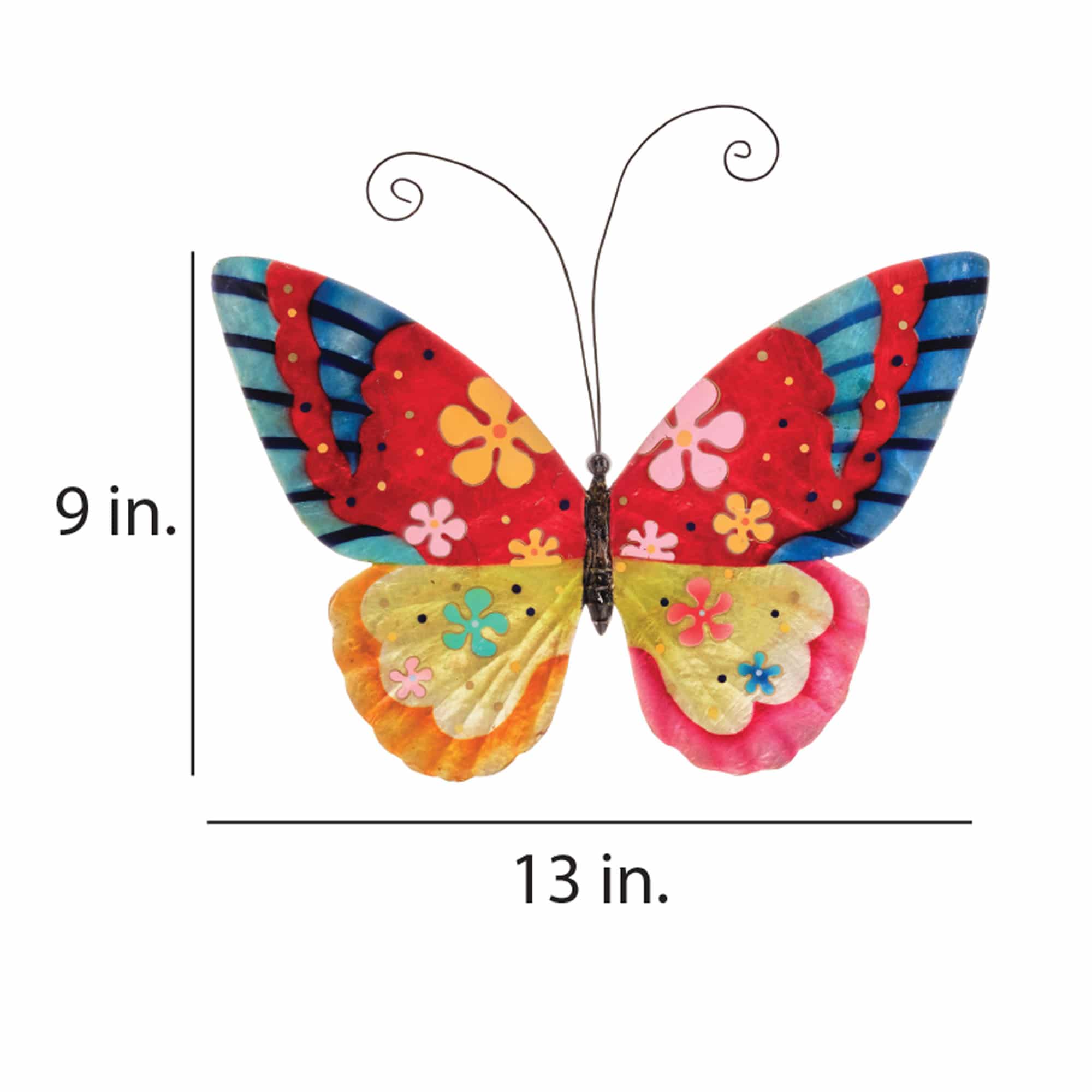
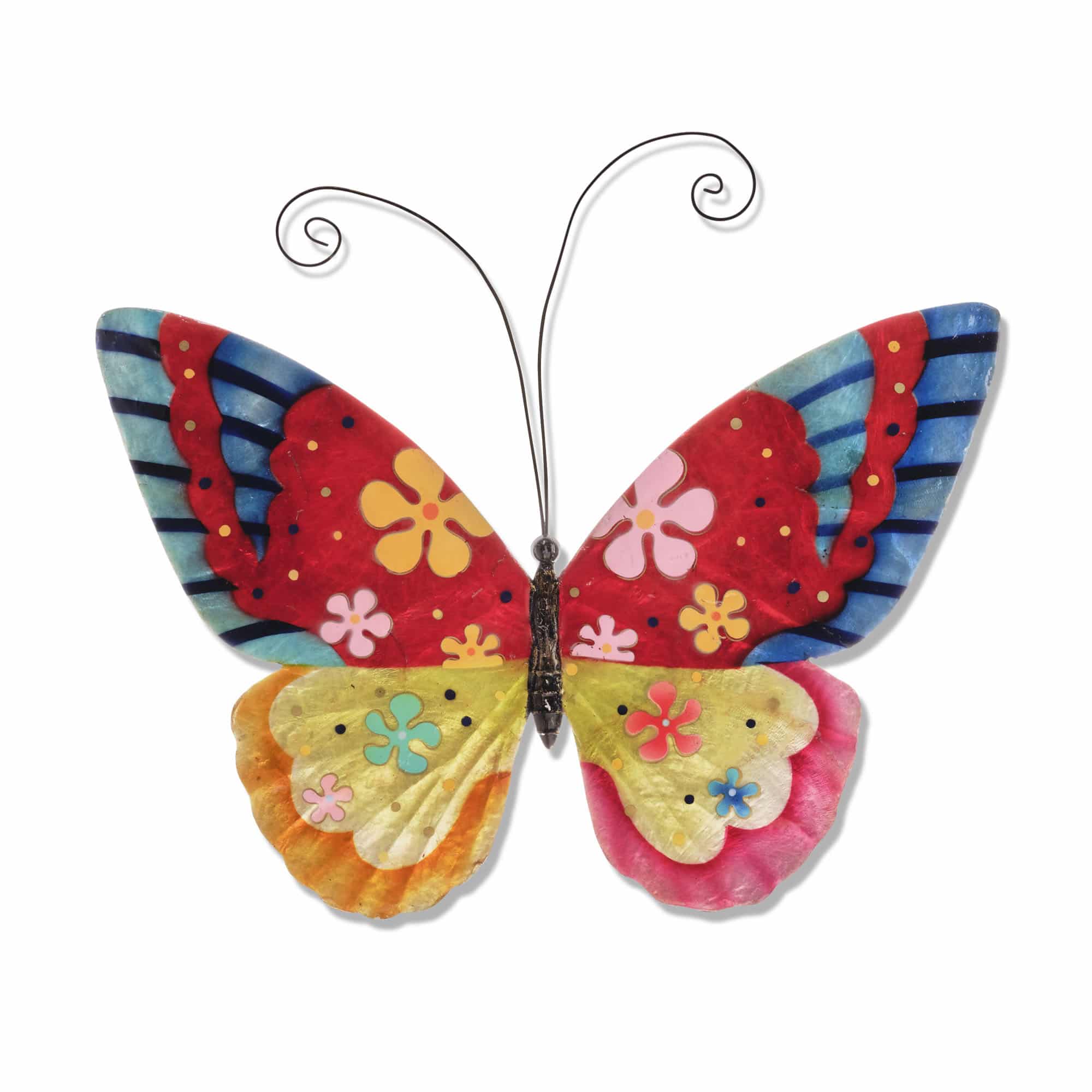
Colorful, fun, and full of cheer, this butterfly gets its influence from the flower power movement of years past. Designed to stand out, this piece adds a powerful pop of color and pizzazz to any space.
The basic frame of the butterfly is created using tin, which is powder-coated with a black finish and makes this piece safe to use outdoors. The edges of the frame are reinforced using thicker tin wire. The front of this piece is adorned in areas with capiz shell, an oyster native to the Philippines, before being hand-painted and sealed with a water-based sealant. The primary purpose of this oyster to provide a source of food, however, the shell is a sustainable by-product that can be used for decoration. The capiz shell subtly replicates the reflective qualities of butterflies in nature. The entire piece is lightweight and has an eyelet in the back allowing it to be hung using a finishing nail, command strip, or a push pin. Due to it being a natural material, the organic colors of capiz come through as tans and browns underneath the paint.
-
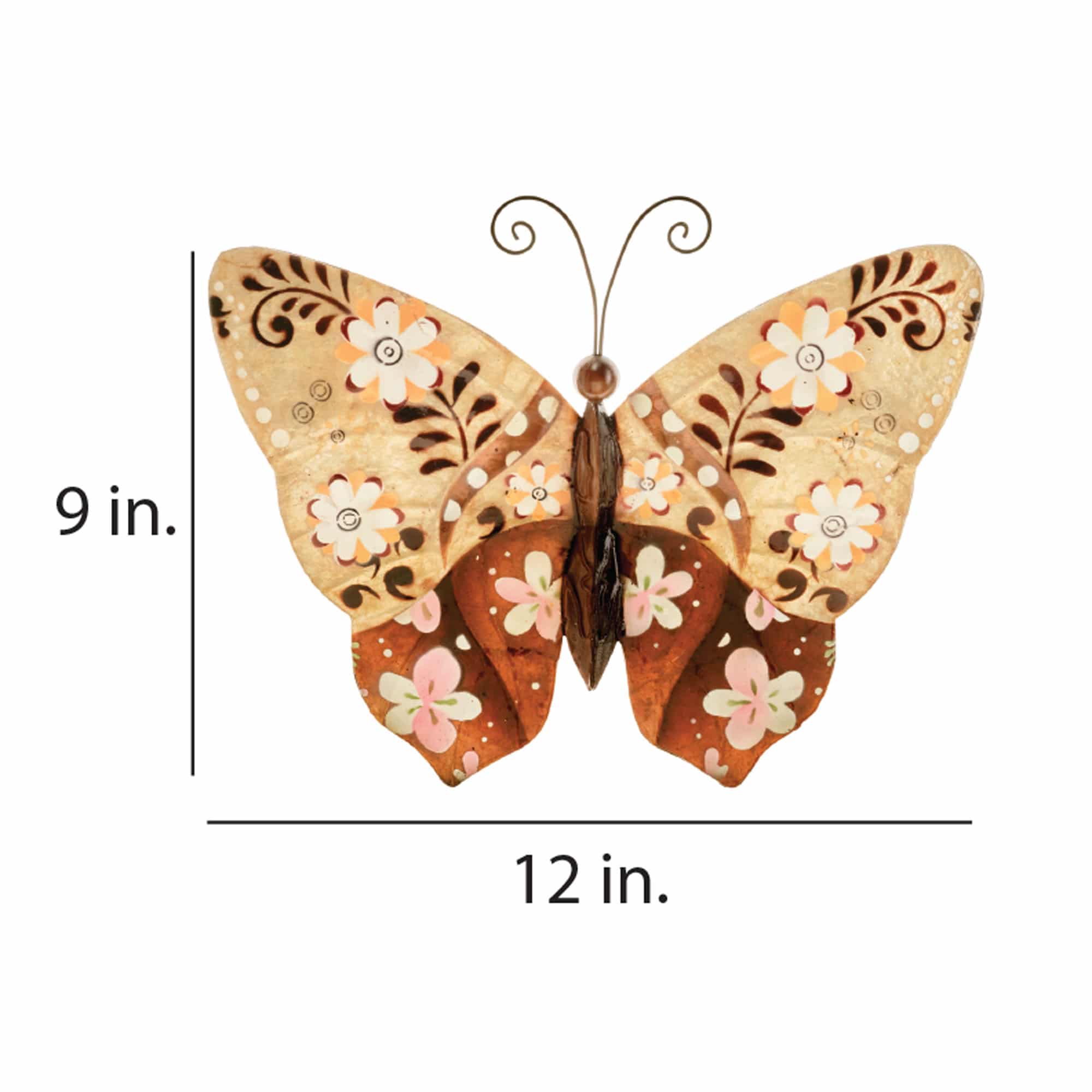
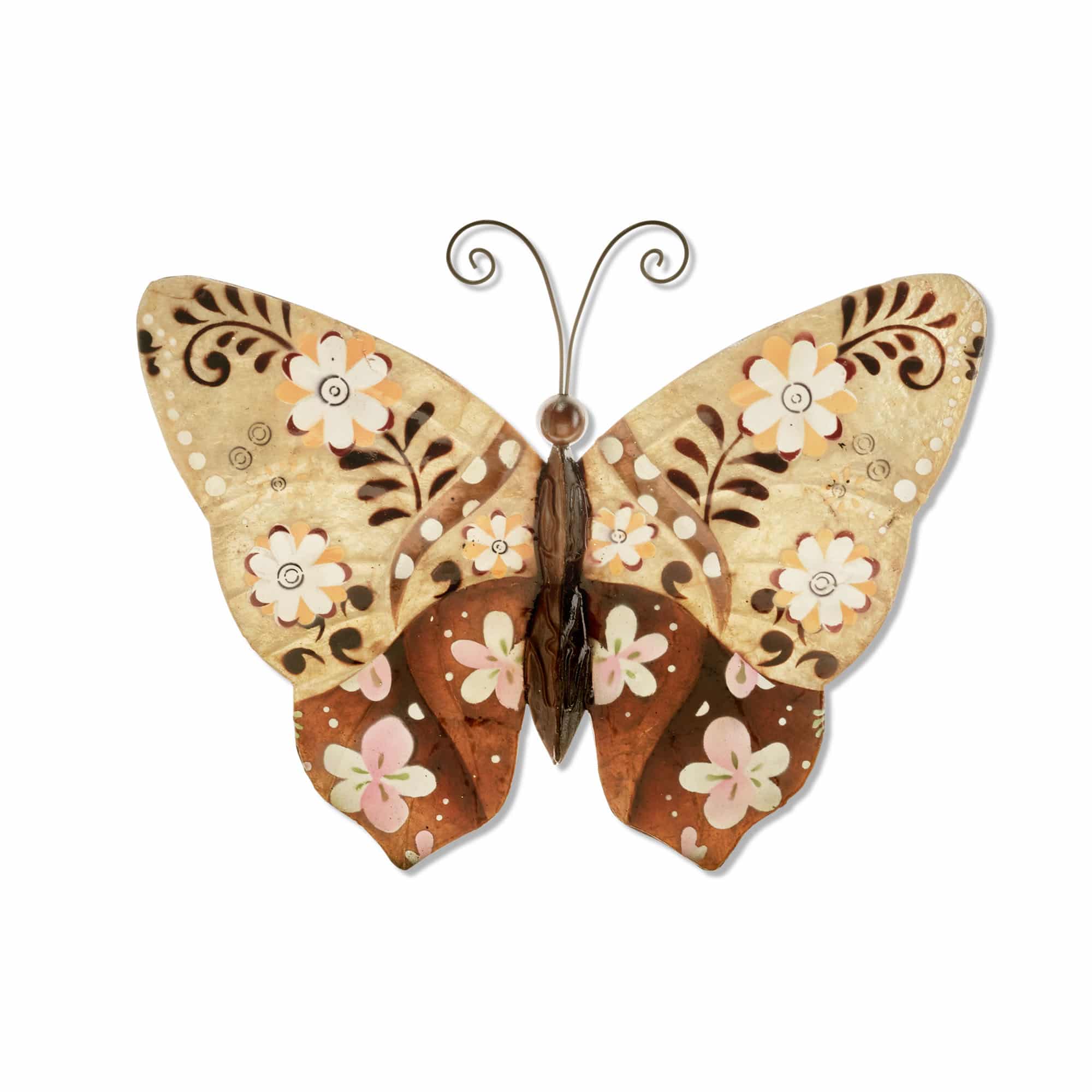
With its warm earth and cream tones, this butterfly features whimsical flowers with sophisticated patterns. Calming and soothing, the understated elegance enhances its surroundings with the beauty of pattern and texture.
The basic frame of the butterfly is created using tin, which is powder-coated with a black finish and makes this piece safe to use outdoors. The edges of the frame are reinforced using thicker tin wire. The front of this piece is adorned in areas with capiz shell, an oyster native to the Philippines, before being hand-painted and sealed with a water-based sealant. The primary purpose of this oyster to provide a source of food, however, the shell is a sustainable by-product that can be used for decoration. The capiz shell subtly replicates the reflective qualities of butterflies in nature. The entire piece is lightweight and has an eyelet in the back allowing it to be hung using a finishing nail, command strip, or a push pin. Due to it being a natural material, the organic colors of capiz come through as tans and browns underneath the paint.
-
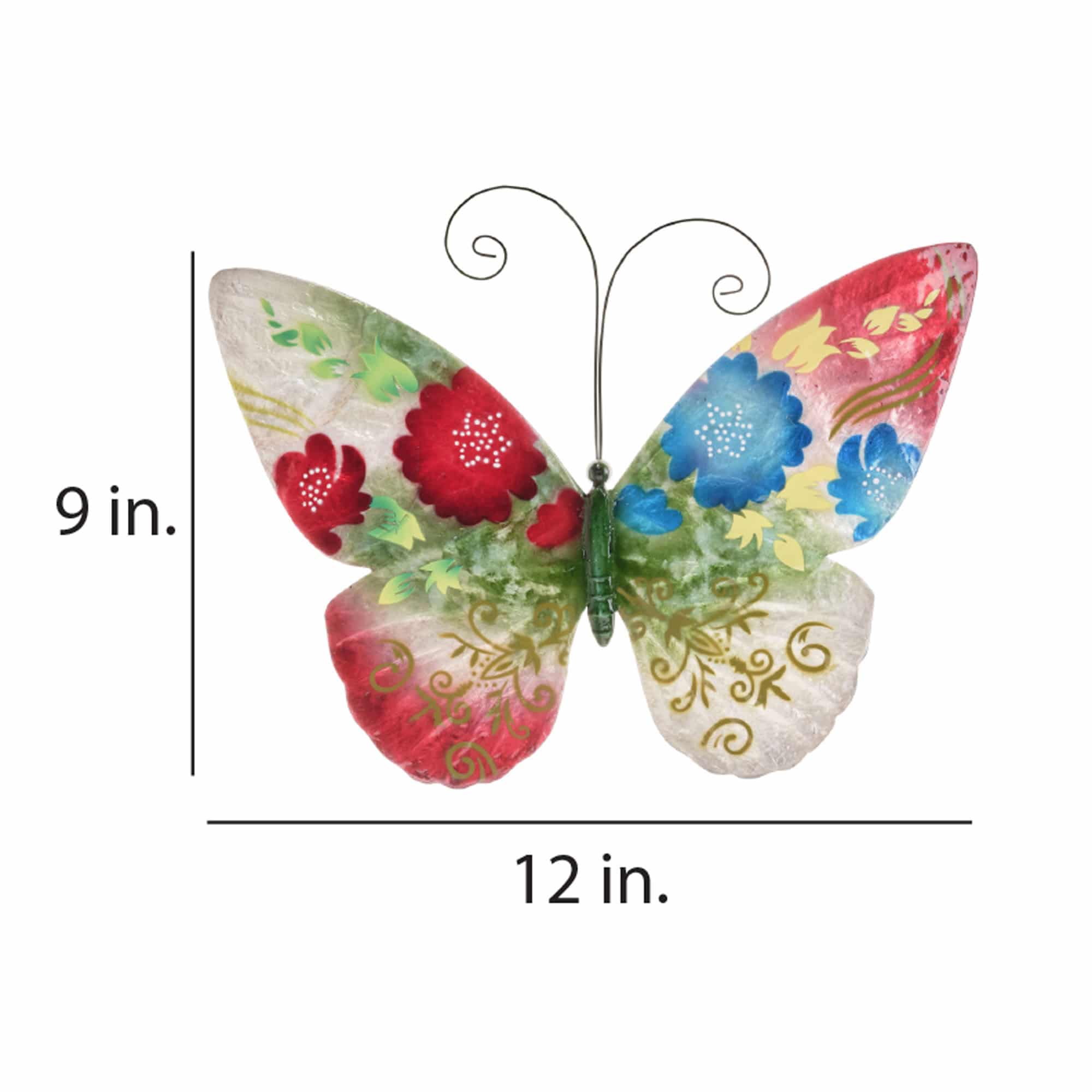
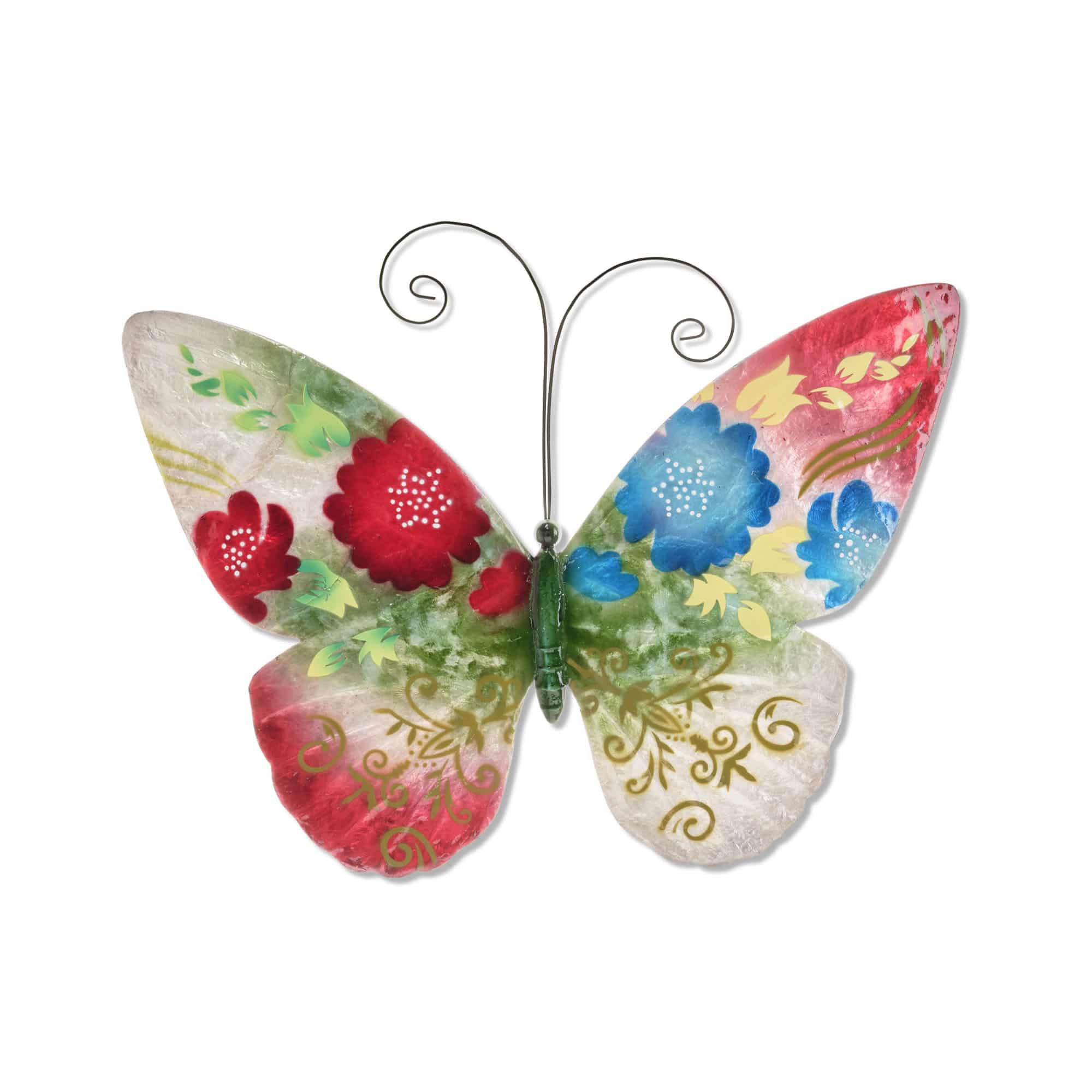
With colorful rising flowers, this butterfly represents spring rising to overtake winter's cold. The bold tones will provide strong accent to any space. A mix of color and designs painted on the wings add depth and dimension.
The basic frame of the butterfly is created using tin, which is powder-coated with a black finish and makes this piece safe to use outdoors. The edges of the frame are reinforced using thicker tin wire. The front of this piece is adorned in areas with capiz shell, an oyster native to the Philippines, before being hand-painted and sealed with a water-based sealant. The primary purpose of this oyster to provide a source of food, however, the shell is a sustainable by-product that can be used for decoration. The capiz shell subtly replicates the reflective qualities of butterflies in nature. The entire piece is lightweight and has an eyelet in the back allowing it to be hung using a finishing nail, command strip, or a push pin. Due to it being a natural material, the organic colors of capiz come through as tans and browns underneath the paint.
-
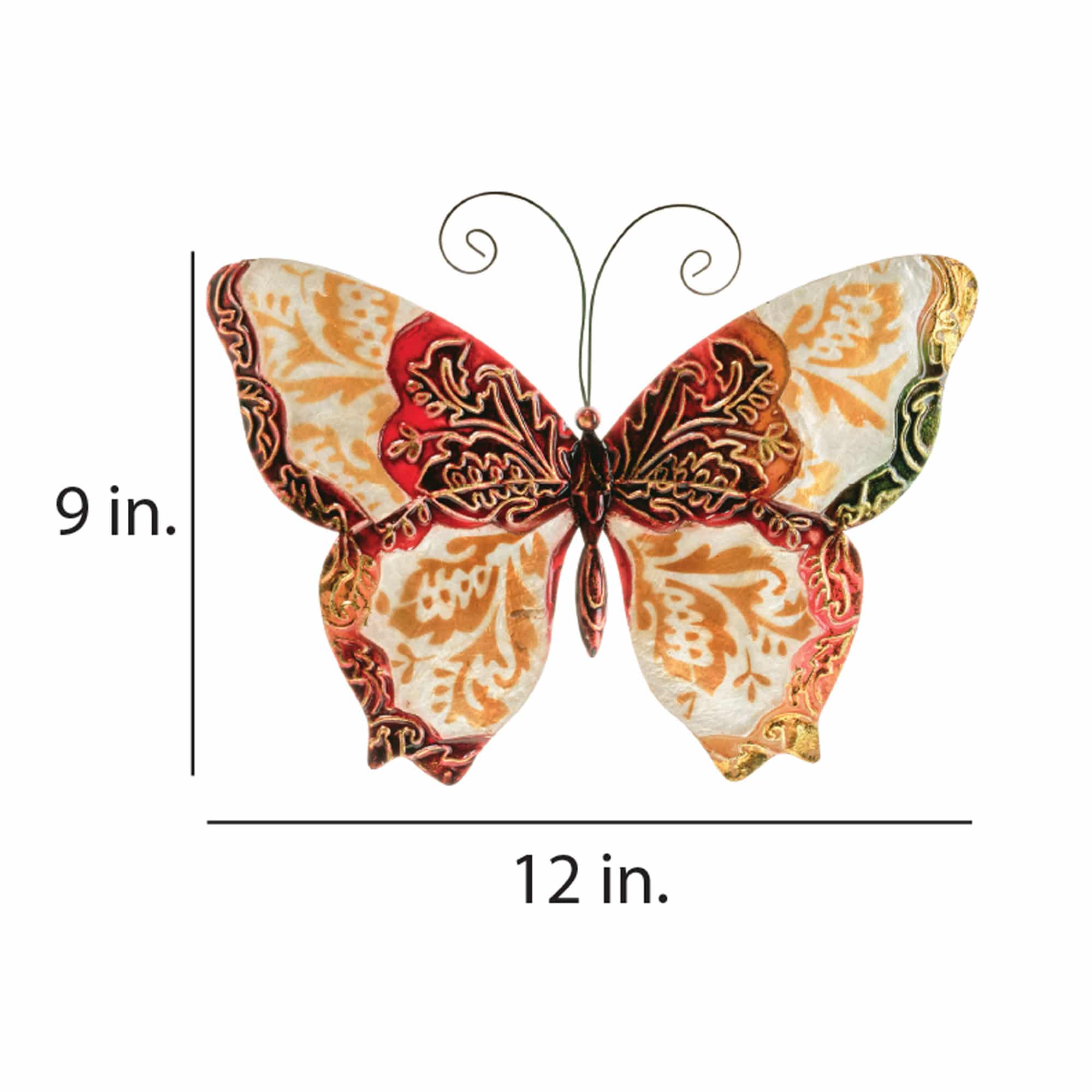
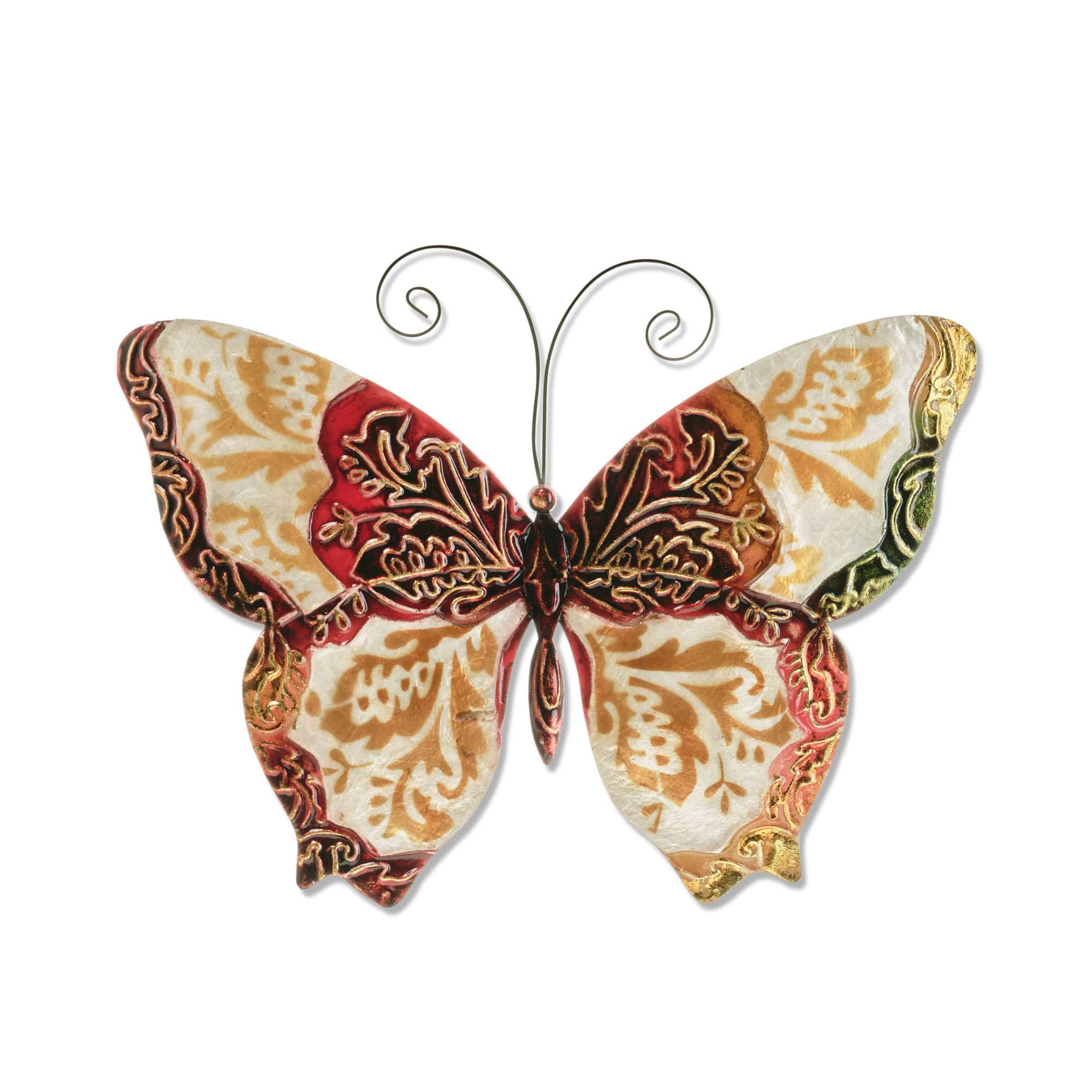 This butterfly can be described as stately, due the artist combination of the color pallet, patterns edged into the tin, and the mix of natural and handcrafted materials. The center of the butterfly is defined with a metallic red, accentuated with a raised pattern painted in gold. The center portion of the wings are crafted using capiz oyster shell, mirroring the patterns of the gold accents. The basic frame of the butterfly is created using tin, which is powder-coated with a black finish and makes this piece safe to use outdoors. The edges of the frame are reinforced using thicker tin wire. The front of this piece is adorned in areas with capiz shell, an oyster native to the Philippines, before being hand-painted and sealed with a water-based sealant. The primary purpose of this oyster to provide a source of food, however, the shell is a sustainable by-product that can be used for decoration. The capiz shell subtly replicates the reflective qualities of butterflies in nature. The entire piece is lightweight and has an eyelet in the back allowing it to be hung using a finishing nail, command strip, or a push pin. Due to it being a natural material, the organic colors of capiz come through as tans and browns underneath the paint.
This butterfly can be described as stately, due the artist combination of the color pallet, patterns edged into the tin, and the mix of natural and handcrafted materials. The center of the butterfly is defined with a metallic red, accentuated with a raised pattern painted in gold. The center portion of the wings are crafted using capiz oyster shell, mirroring the patterns of the gold accents. The basic frame of the butterfly is created using tin, which is powder-coated with a black finish and makes this piece safe to use outdoors. The edges of the frame are reinforced using thicker tin wire. The front of this piece is adorned in areas with capiz shell, an oyster native to the Philippines, before being hand-painted and sealed with a water-based sealant. The primary purpose of this oyster to provide a source of food, however, the shell is a sustainable by-product that can be used for decoration. The capiz shell subtly replicates the reflective qualities of butterflies in nature. The entire piece is lightweight and has an eyelet in the back allowing it to be hung using a finishing nail, command strip, or a push pin. Due to it being a natural material, the organic colors of capiz come through as tans and browns underneath the paint. -
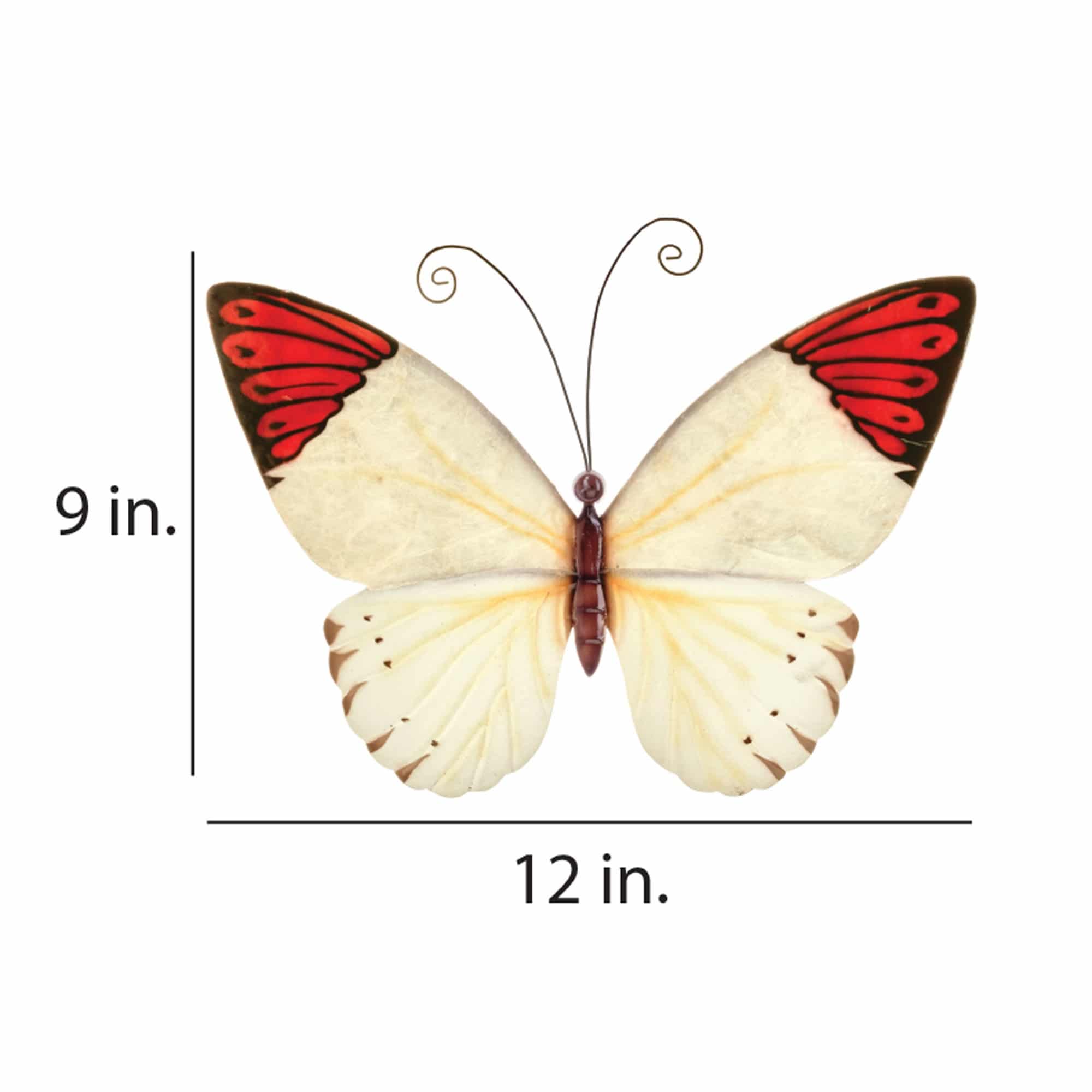
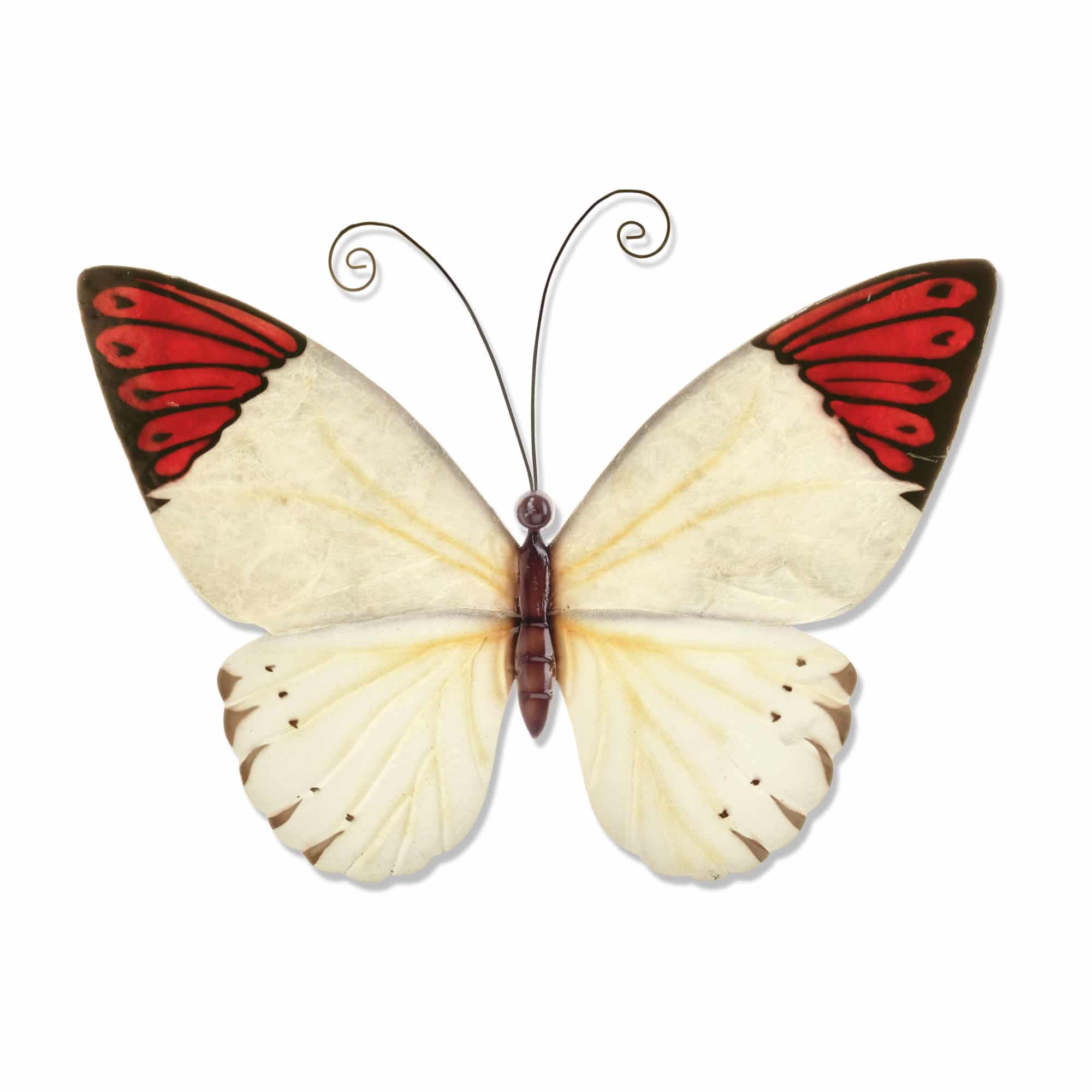 Starting with a base color of pearl white, the artist uses different techniques and splashes of color to craft a distinctive piece. The upper wings are created using capiz oyster shell, left natural to bring in different natural hues. The red base color is accented using brown feathering patterns. The lower portion of the wing is made of tin, textured to highlight the lines that stem from the body of the butterfly. The basic frame of the butterfly is created using tin, which is powder-coated with a black finish and makes this piece safe to use outdoors. The edges of the frame are reinforced using thicker tin wire. The front of this piece is adorned in areas with capiz shell, an oyster native to the Philippines, before being hand-painted and sealed with a water-based sealant. The primary purpose of this oyster to provide a source of food, however, the shell is a sustainable by-product that can be used for decoration. The capiz shell subtly replicates the reflective qualities of butterflies in nature. The entire piece is lightweight and has an eyelet in the back allowing it to be hung using a finishing nail, command strip, or a push pin. Due to it being a natural material, the organic colors of capiz come through as tans and browns underneath the paint.
Starting with a base color of pearl white, the artist uses different techniques and splashes of color to craft a distinctive piece. The upper wings are created using capiz oyster shell, left natural to bring in different natural hues. The red base color is accented using brown feathering patterns. The lower portion of the wing is made of tin, textured to highlight the lines that stem from the body of the butterfly. The basic frame of the butterfly is created using tin, which is powder-coated with a black finish and makes this piece safe to use outdoors. The edges of the frame are reinforced using thicker tin wire. The front of this piece is adorned in areas with capiz shell, an oyster native to the Philippines, before being hand-painted and sealed with a water-based sealant. The primary purpose of this oyster to provide a source of food, however, the shell is a sustainable by-product that can be used for decoration. The capiz shell subtly replicates the reflective qualities of butterflies in nature. The entire piece is lightweight and has an eyelet in the back allowing it to be hung using a finishing nail, command strip, or a push pin. Due to it being a natural material, the organic colors of capiz come through as tans and browns underneath the paint. -

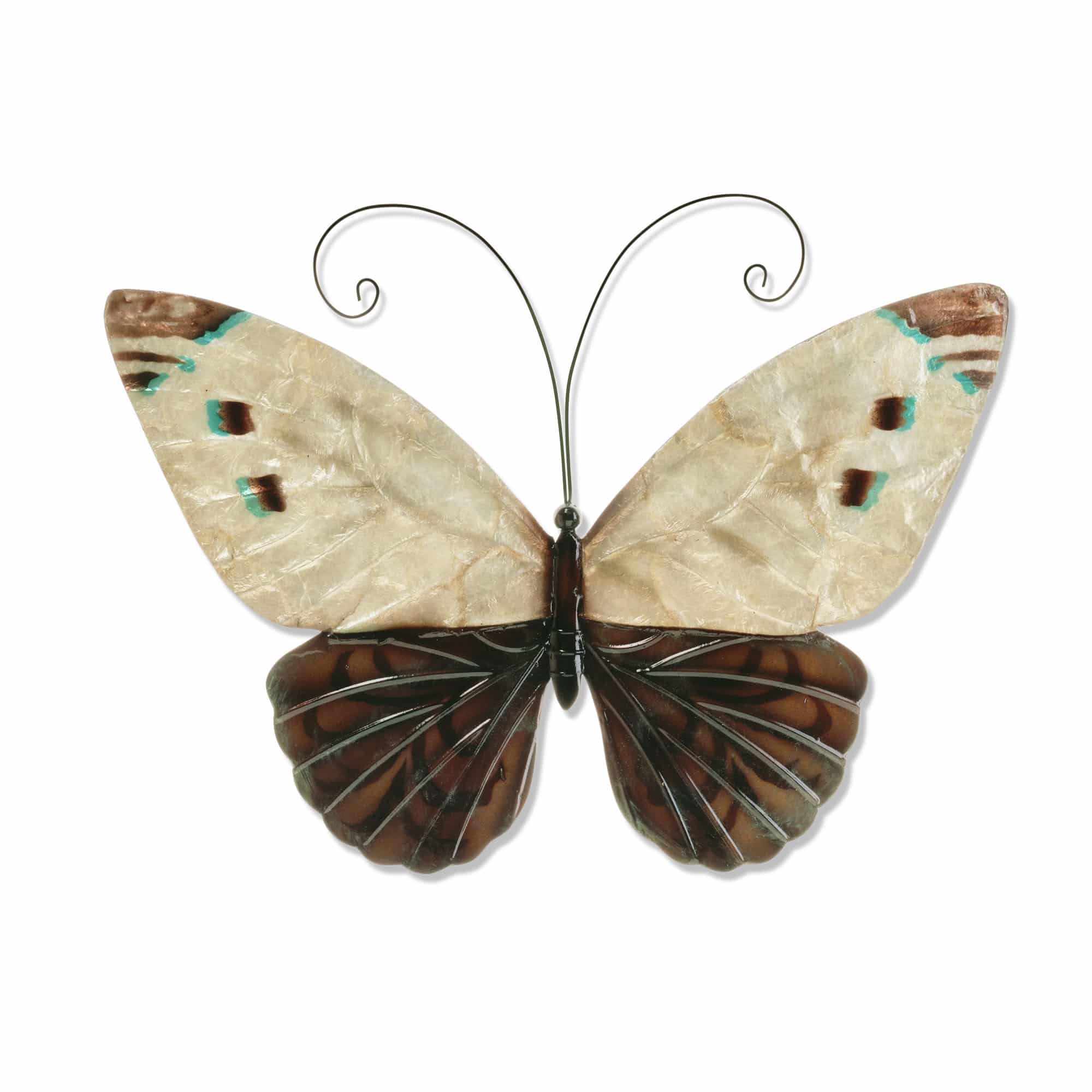
The wings of this butterfly are divided into two parts. Soft muted organic colors are hand-painted onto mother of pearl oyster shells on the upper portion of the wings. The lower portion of the wings contrast with bold lines etched into the tin base. That is then hand-painted using a dark brown with a gloss finish reflecting different shades of color changing with the light.
The basic frame of the butterfly is created using tin, which is powder-coated with a black finish and makes this piece safe to use outdoors. The edges of the frame are reinforced using thicker tin wire. The front of this piece is adorned in areas with capiz shell, an oyster native to the Philippines, before being hand-painted and sealed with a water-based sealant. The primary purpose of this oyster to provide a source of food, however, the shell is a sustainable by-product that can be used for decoration. The capiz shell subtly replicates the reflective qualities of butterflies in nature. The entire piece is lightweight and has an eyelet in the back allowing it to be hung using a finishing nail, command strip, or a push pin. Due to it being a natural material, the organic colors of capiz come through as tans and browns underneath the paint.
-
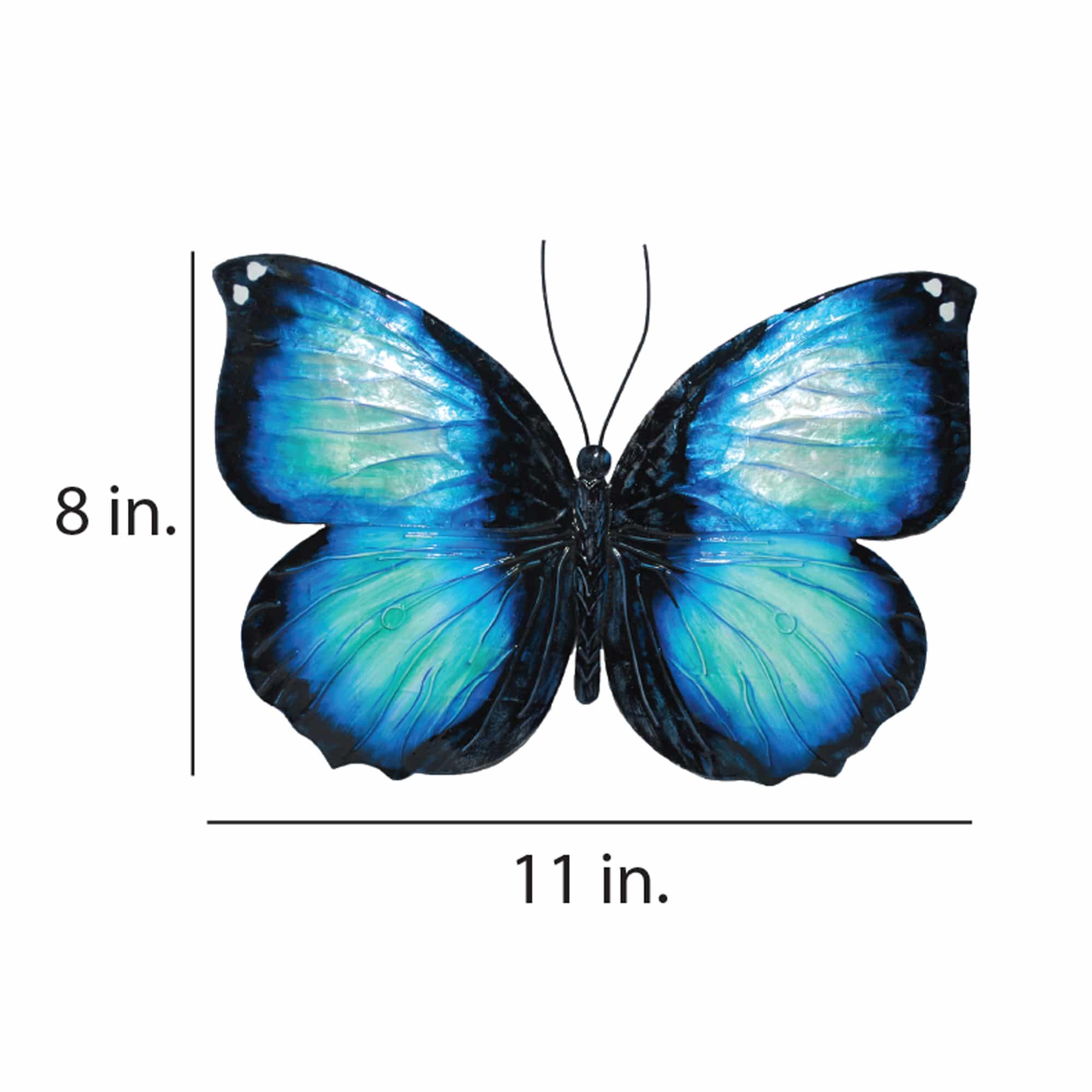
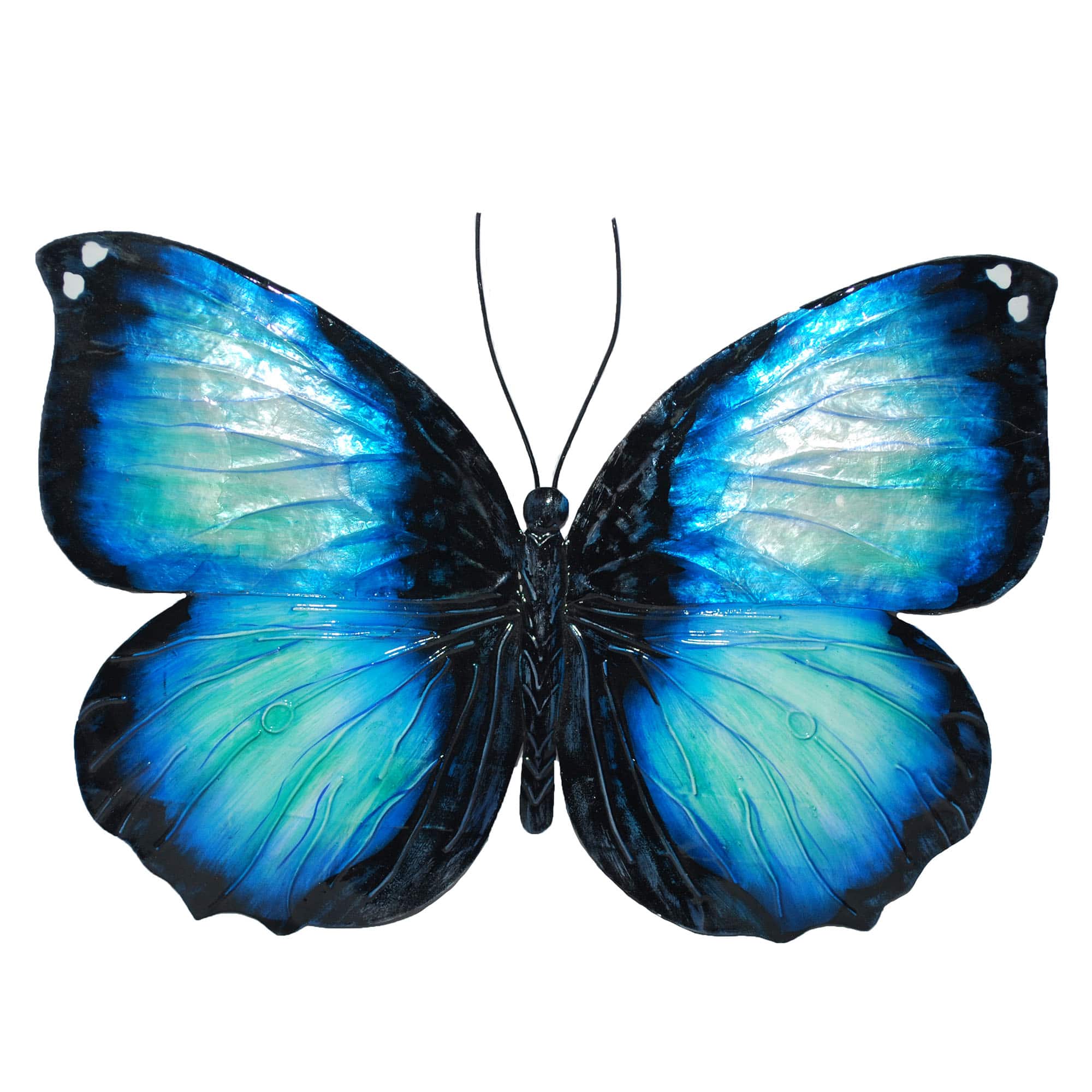
This butterfly is influenced by the Pipevine Swallowtail, which is common in the middle to eastern parts of the US. These swift fliers fly low to the ground and do not stay on a wall very long. The artist captured their cobalt blue color which is truly striking. Accent your wall with a color that has been given a stamp of approval by nature.
The basic frame of the butterfly is created using tin, which is powder-coated with a black finish and makes this piece safe to use outdoors. The edges of the frame are reinforced using thicker tin wire. The front of this piece is adorned in areas with capiz shell, an oyster native to the Philippines, before being hand-painted and sealed with a water-based sealant. The primary purpose of this oyster to provide a source of food, however, the shell is a sustainable by-product that can be used for decoration. The capiz shell subtly replicates the reflective qualities of butterflies in nature. The entire piece is lightweight and has an eyelet in the back allowing it to be hung using a finishing nail, command strip, or a push pin. Due to it being a natural material, the organic colors of capiz come through as tans and browns underneath the paint.
-
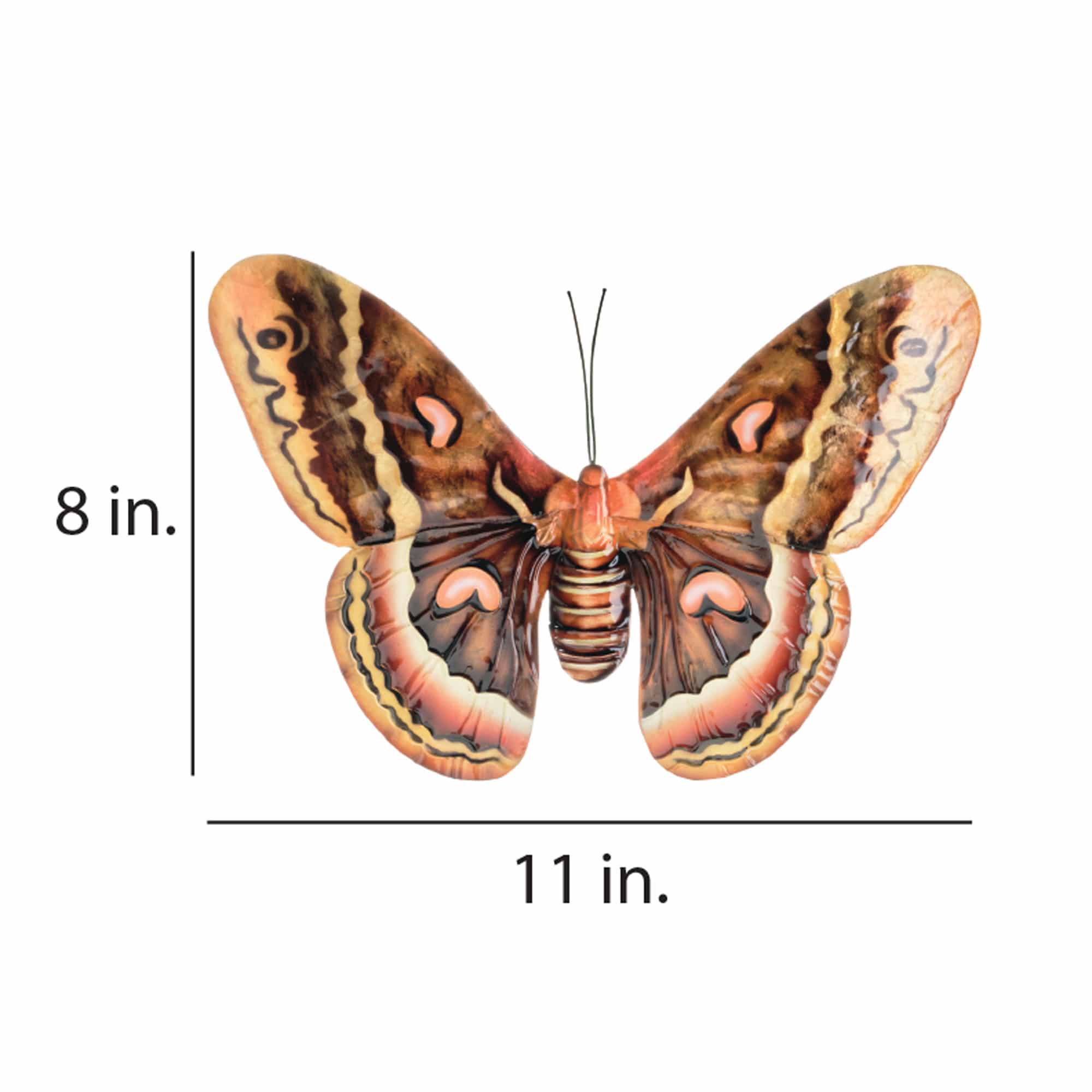
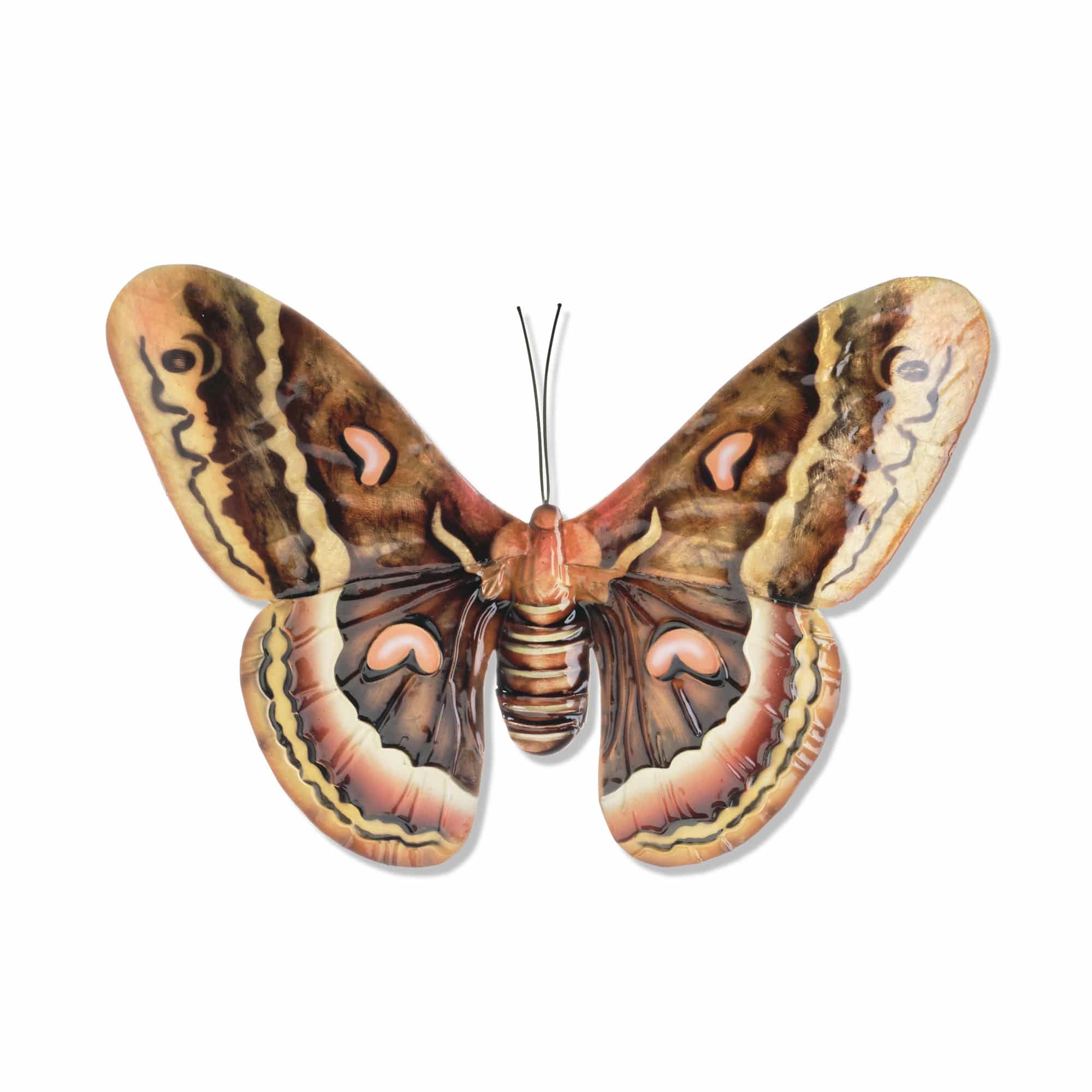
Moths play a vital role in telling us the health of our natural environments. They can be just as colorful as butterflies and many other insects. The artist brings out the earth tones with a hint of the reds in this moth. The mix of color and design is intricately painted on the frontside of the wings and body. The artist brings out the reflective nature of the wings using capiz shell.
The basic frame of the butterfly is created using tin, which is powder-coated with a black finish and makes this piece safe to use outdoors. The edges of the frame are reinforced using thicker tin wire. The front of this piece is adorned in areas with capiz shell, an oyster native to the Philippines, before being hand-painted and sealed with a water-based sealant. The primary purpose of this oyster to provide a source of food, however, the shell is a sustainable by-product that can be used for decoration. The capiz shell subtly replicates the reflective qualities of butterflies in nature. The entire piece is lightweight and has an eyelet in the back allowing it to be hung using a finishing nail, command strip, or a push pin. Due to it being a natural material, the organic colors of capiz come through as tans and browns underneath the paint.
-
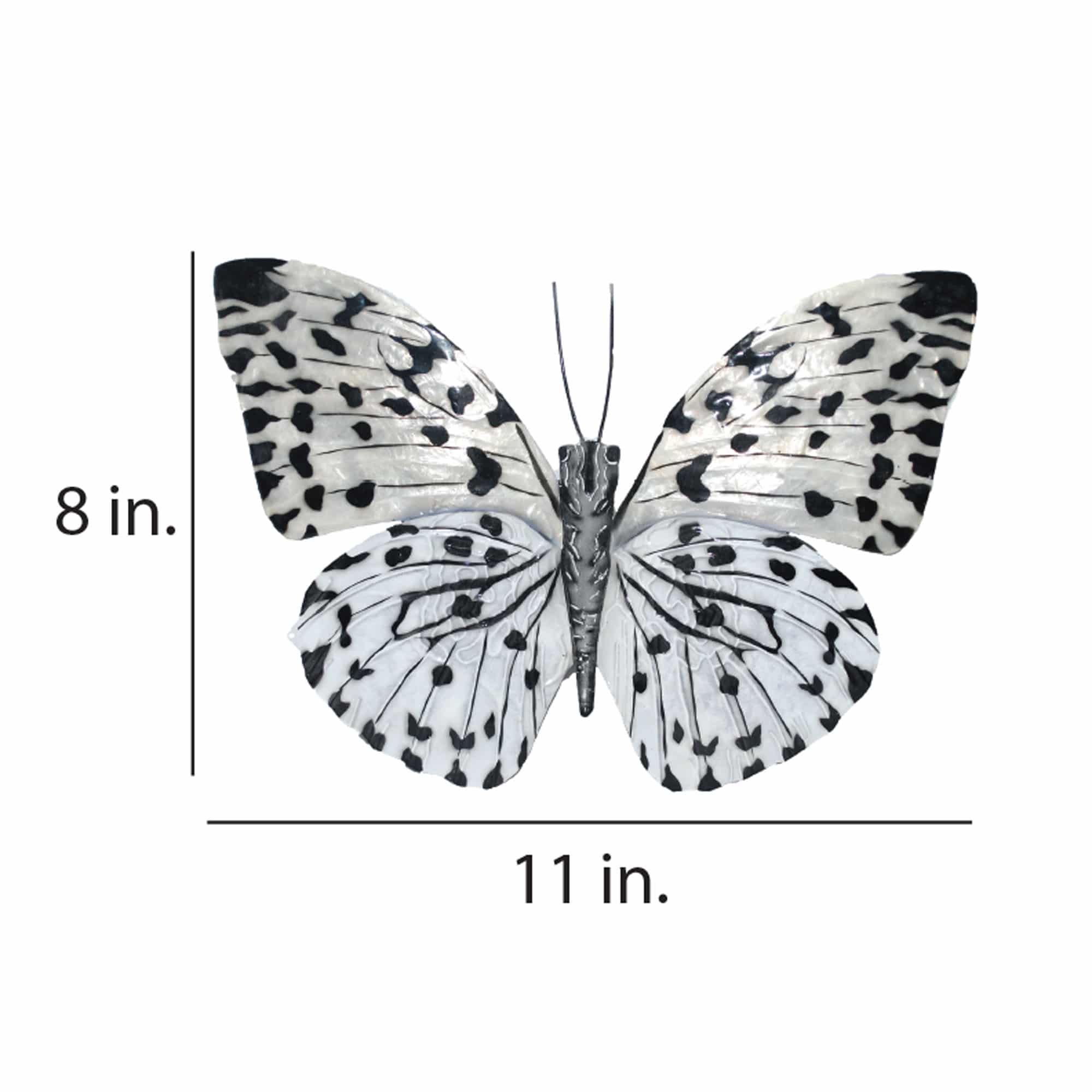
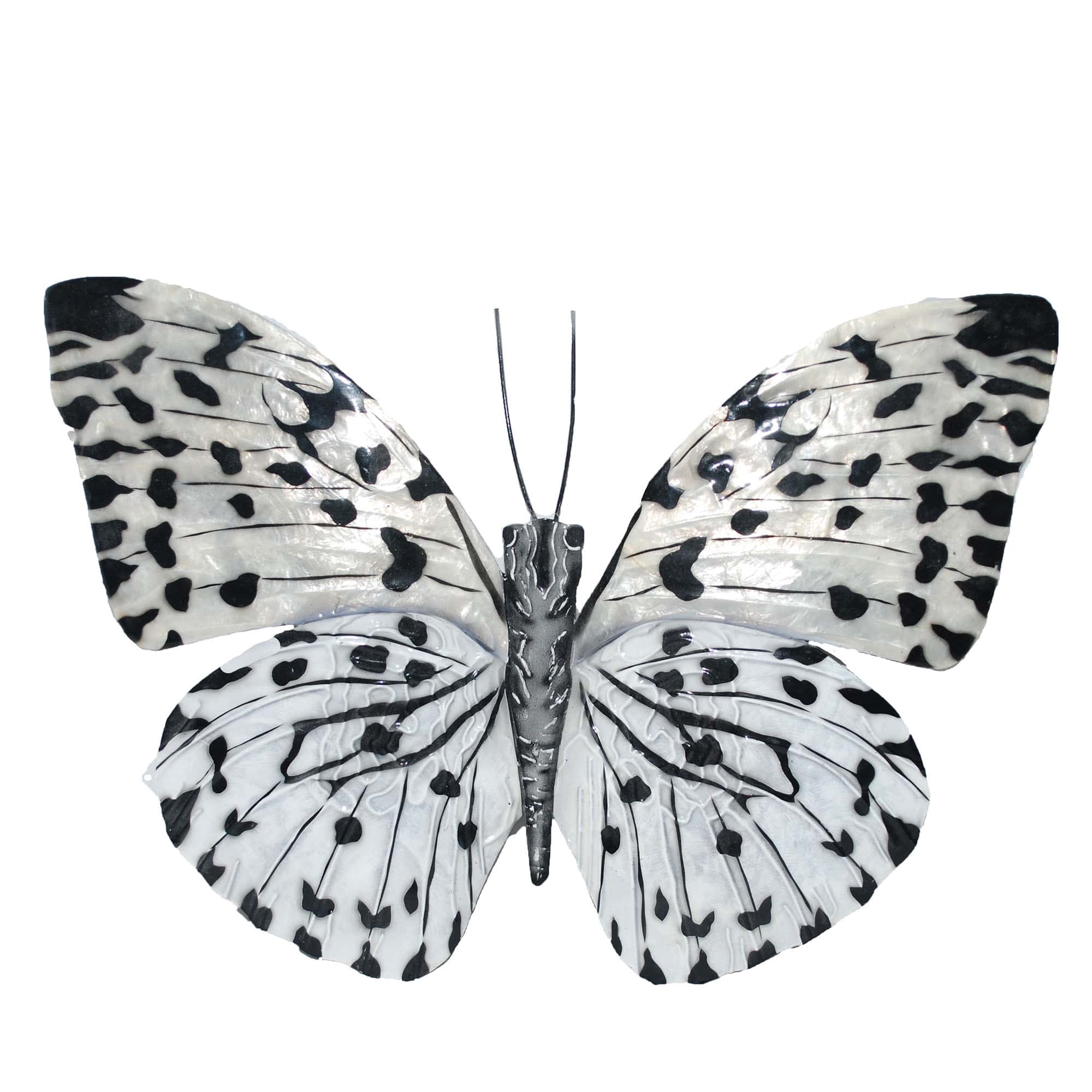
Angelic and graceful, the White Morpho butterfly is distinctive and regal. The wings of this butterfly are rather large and stately, particularly when this beauty flies on the breeze from flower to flower. The artist brings this to life by crafting the body smaller compared to the wings. The upper wings are adorned with capiz shell, giving it the translucent color seen in the natural butterfly. The lower wings are constructed from tin and the colors help accentuate the vein structures. The combination of the two will add both color and structure to your wall and your room.
The basic frame of the butterfly is created using tin, which is powder-coated with a black finish and makes this piece safe to use outdoors. The edges of the frame are reinforced using thicker tin wire. The front of this piece is adorned in areas with capiz shell, an oyster native to the Philippines, before being hand-painted and sealed with a water-based sealant. The primary purpose of this oyster to provide a source of food, however, the shell is a sustainable by-product that can be used for decoration. The capiz shell subtly replicates the reflective qualities of butterflies in nature. The entire piece is lightweight and has an eyelet in the back allowing it to be hung using a finishing nail, command strip, or a push pin. Due to it being a natural material, the organic colors of capiz come through as tans and browns underneath the paint.
-
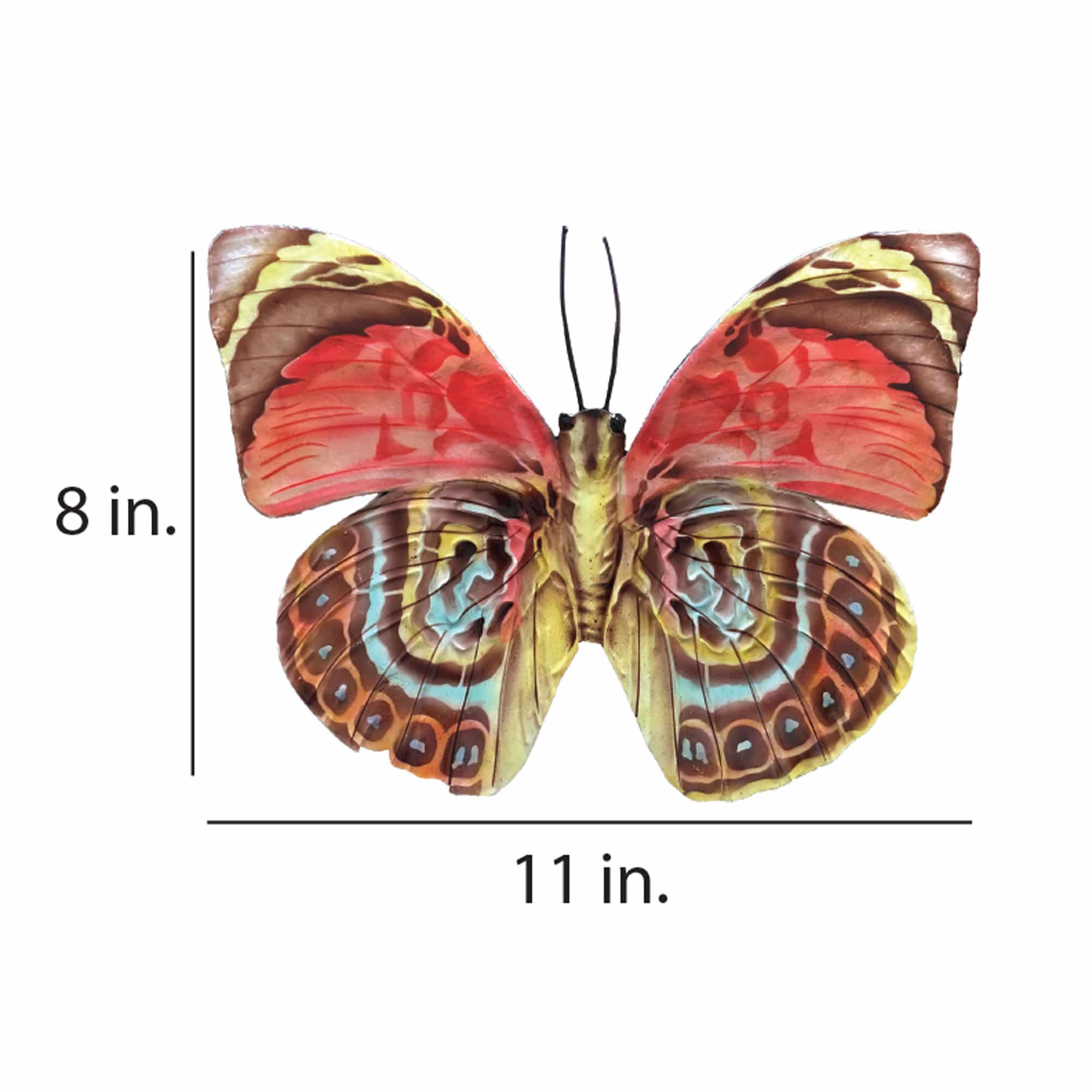
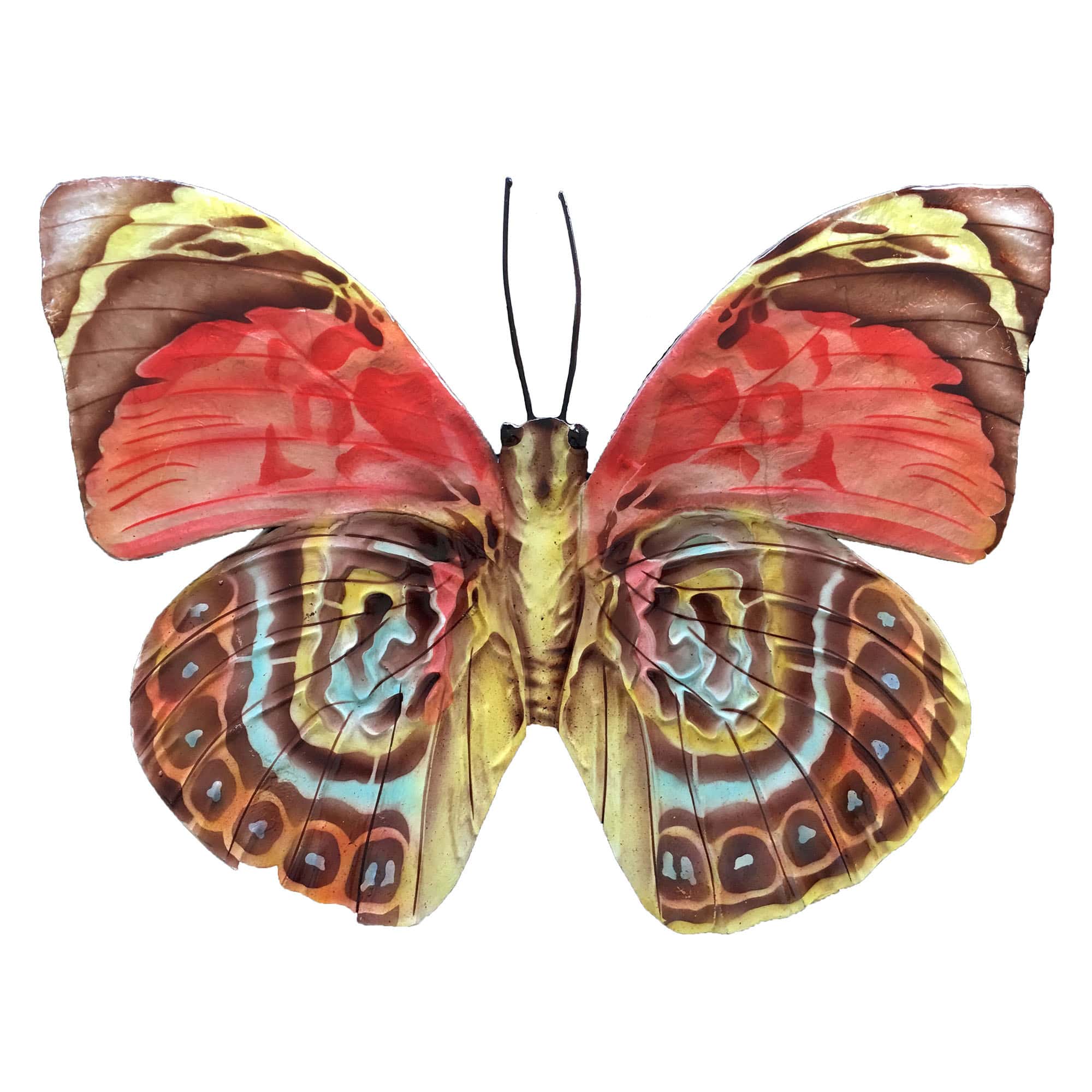
Butterflies are known for their vibrant patterns. The striking contrast of this piece reflects the ability of these insects to hide in plane site through foliage and flowers. The artist uses bright bands of colors to bring this butterfly to life.
The basic frame of the butterfly is created using tin, which is powder-coated with a black finish and makes this piece safe to use outdoors. The edges of the frame are reinforced using thicker tin wire. The front of this piece is adorned in areas with capiz shell, an oyster native to the Philippines, before being hand-painted and sealed with a water-based sealant. The primary purpose of this oyster to provide a source of food, however, the shell is a sustainable by-product that can be used for decoration. The capiz shell subtly replicates the reflective qualities of butterflies in nature. The entire piece is lightweight and has an eyelet in the back allowing it to be hung using a finishing nail, command strip, or a push pin. Due to it being a natural material, the organic colors of capiz come through as tans and browns underneath the paint.
-
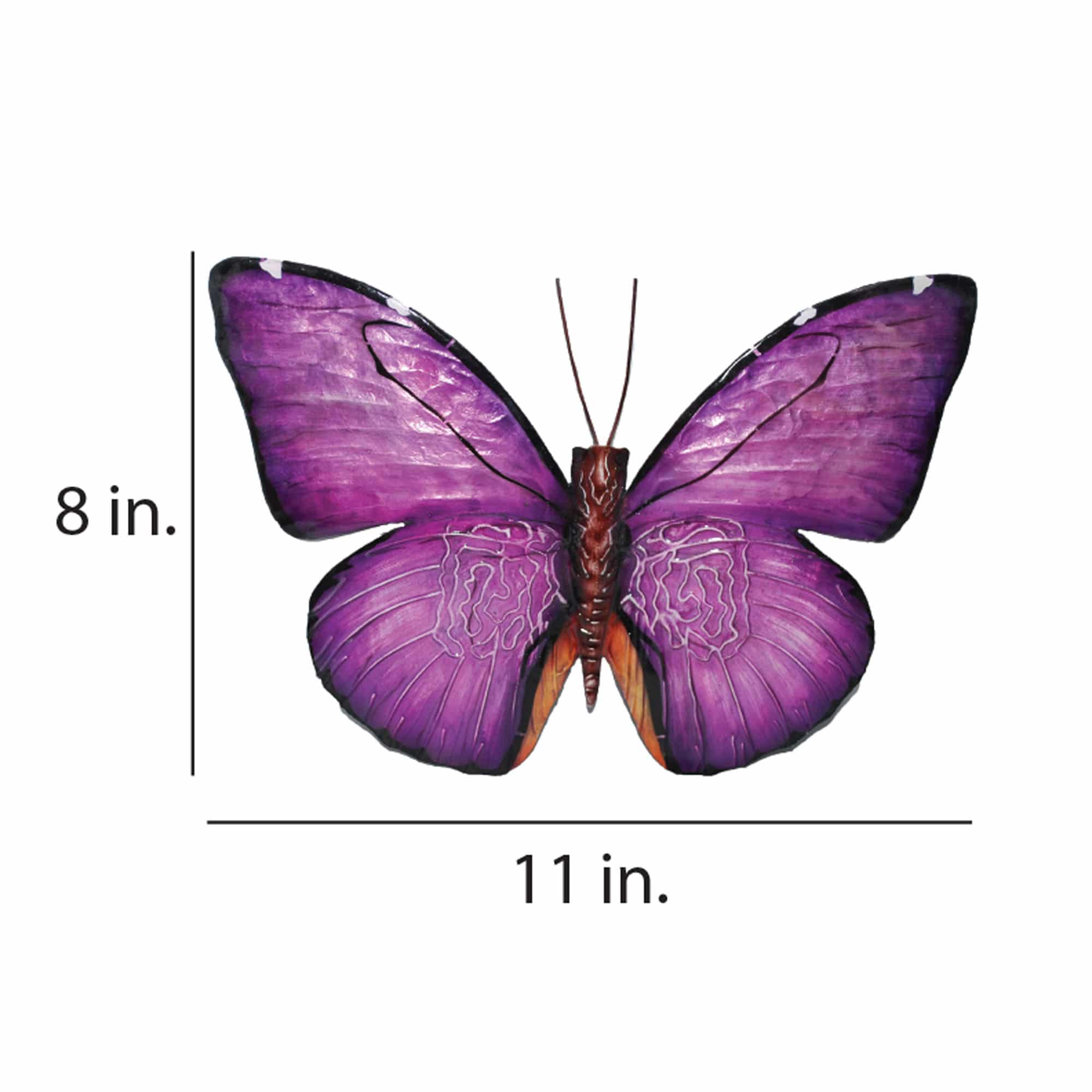
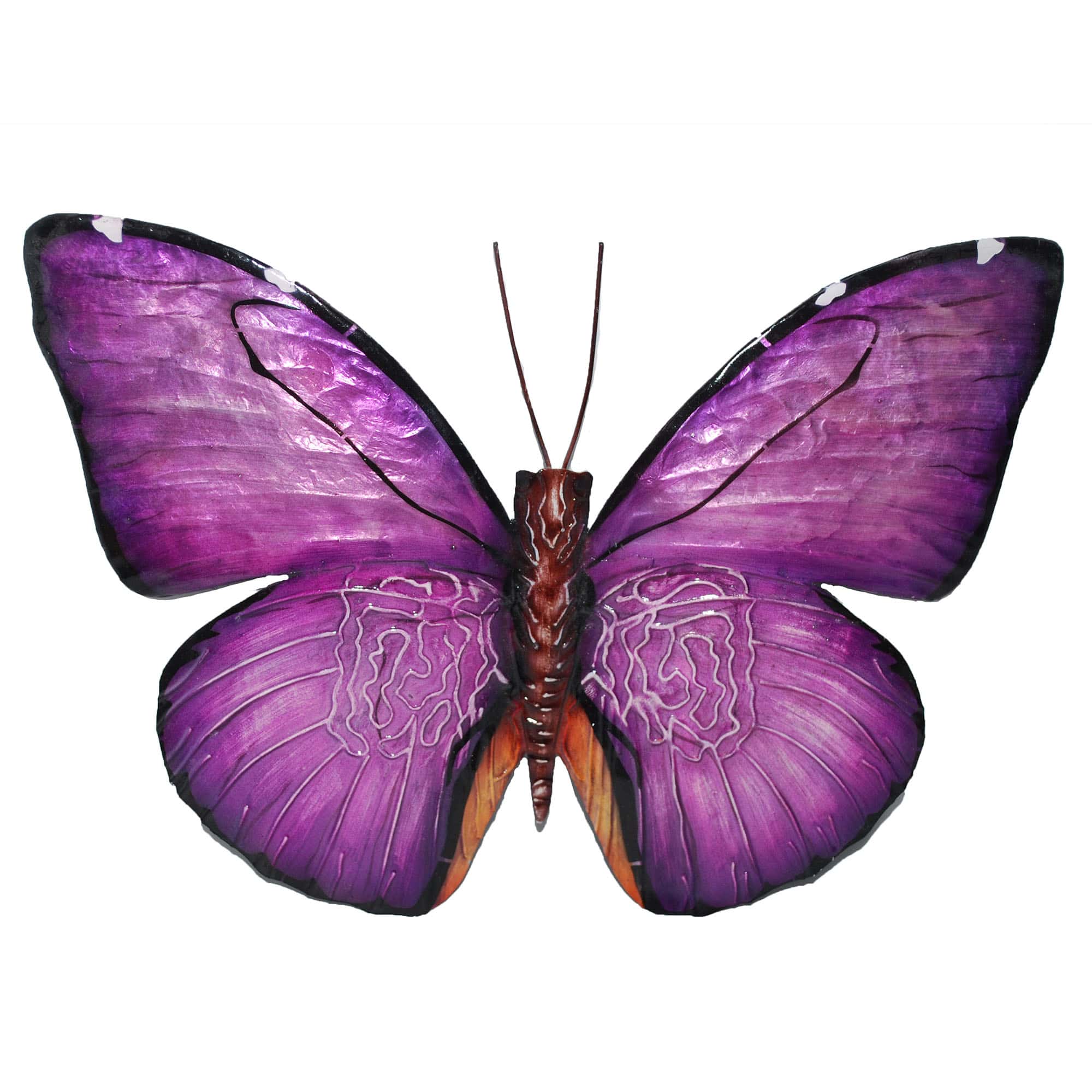
Purple is considered a color of royalty and wealth due to the rarity of the dye that originally produced it. Even though that no longer is the case, it still is considered a bold and rich color. The color is even more vibrant due to the strips of color created by the brush strokes against the capiz shell. The artist complemented the predominantly purple colored butterfly with oranges and reds at the base and a couple of white spots on each wing. If your color is primarily purple or if it is just used as an accent, this butterfly will complement any decor in your room.
The basic frame of the butterfly is created using tin, which is powder-coated with a black finish and makes this piece safe to use outdoors. The edges of the frame are reinforced using thicker tin wire. The front of this piece is adorned in areas with capiz shell, an oyster native to the Philippines, before being hand-painted and sealed with a water-based sealant. The primary purpose of this oyster to provide a source of food, however, the shell is a sustainable by-product that can be used for decoration. The capiz shell subtly replicates the reflective qualities of butterflies in nature. The entire piece is lightweight and has an eyelet in the back allowing it to be hung using a finishing nail, command strip, or a push pin. Due to it being a natural material, the organic colors of capiz come through as tans and browns underneath the paint.
-

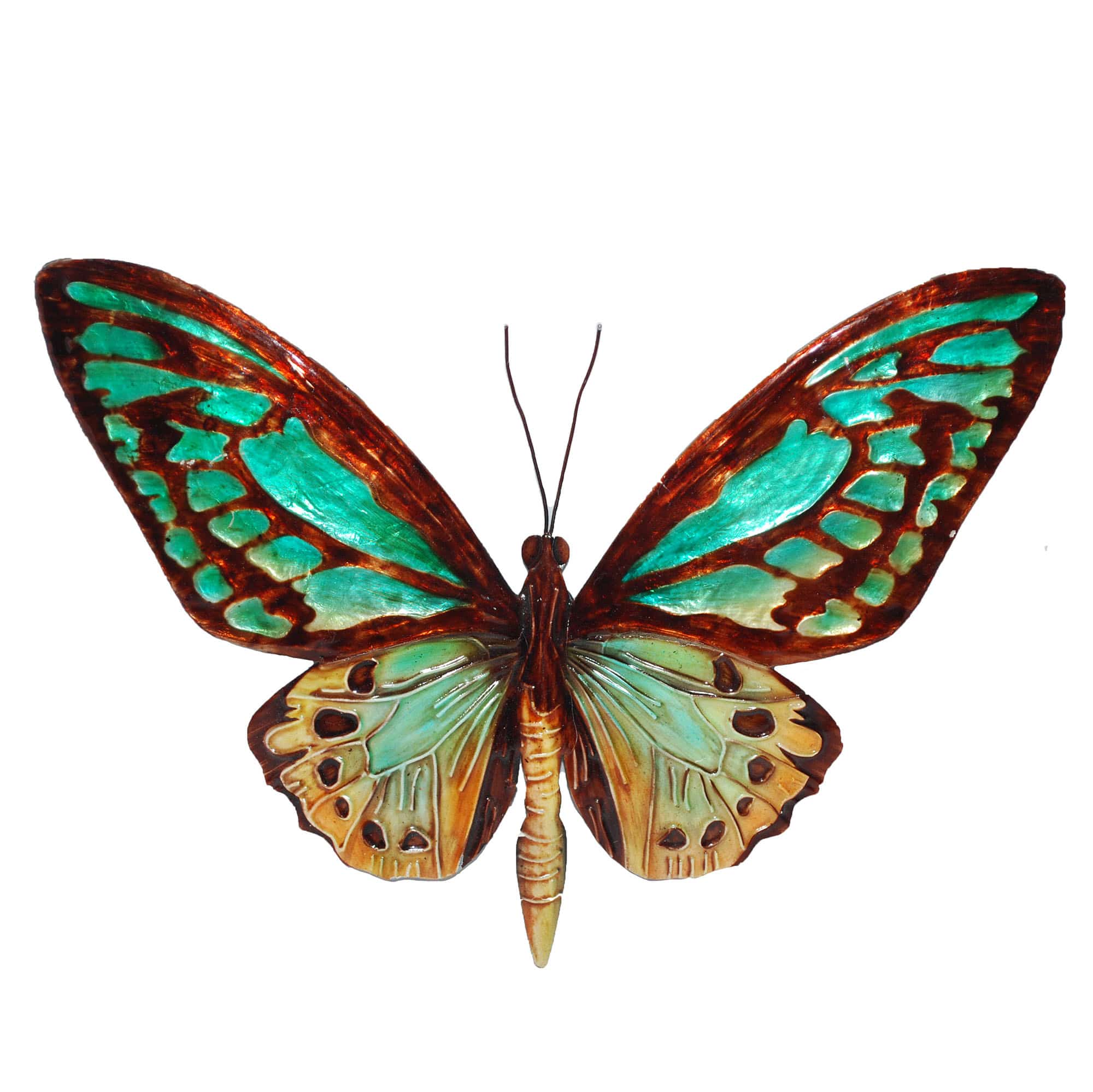
The aqua color of this butterfly and the capiz shell complement each other in such a way that it almost looks like one is looking at cobalt glass. This color is accentuated by the copper tone bordering the aqua centers. This is truly an impressive piece combining natural materials and colors and creating something breathtaking. The upper wing adorned in capiz is contrasted by the handcrafted metal lower wing. Both components meld together for a piece that showcases the artists talents.
The basic frame of the butterfly is created using tin, which is powder-coated with a black finish and makes this piece safe to use outdoors. The edges of the frame are reinforced using thicker tin wire. The front of this piece is adorned in areas with capiz shell, an oyster native to the Philippines, before being hand-painted and sealed with a water-based sealant. The primary purpose of this oyster to provide a source of food, however, the shell is a sustainable by-product that can be used for decoration. The capiz shell subtly replicates the reflective qualities of butterflies in nature. The entire piece is lightweight and has an eyelet in the back allowing it to be hung using a finishing nail, command strip, or a push pin. Due to it being a natural material, the organic colors of capiz come through as tans and browns underneath the paint.
-
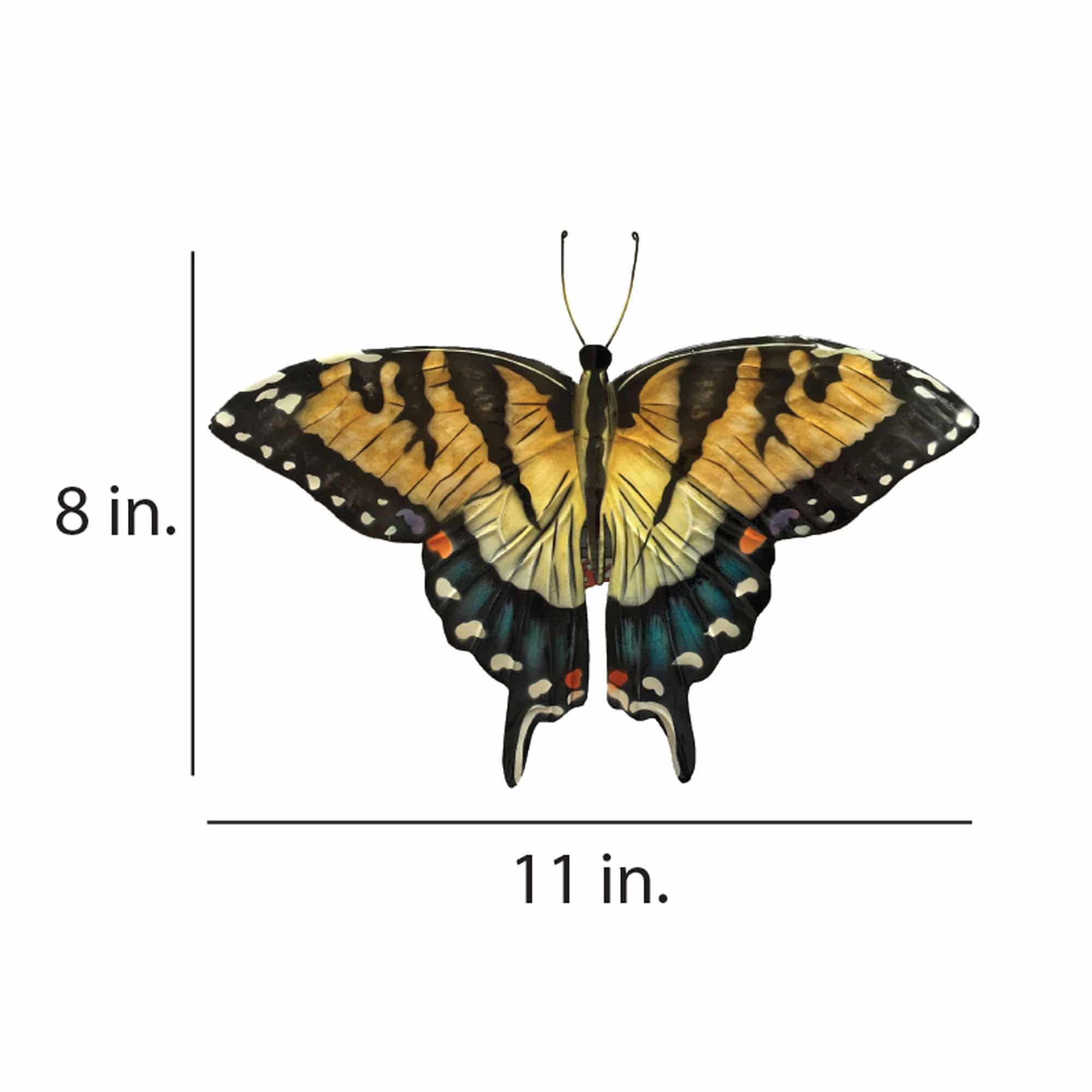
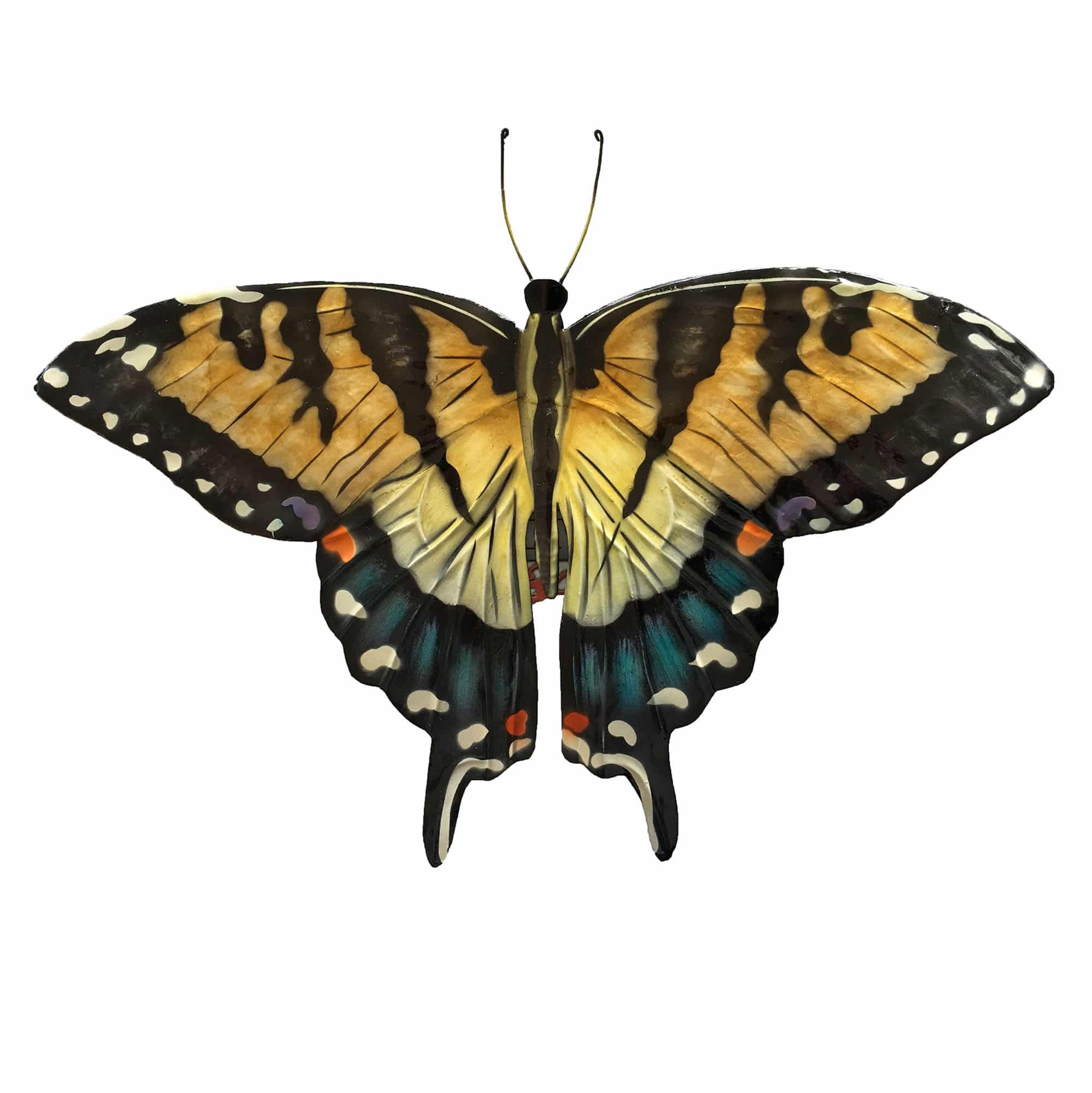
Chances are you have seen the eastern tiger swallowtail at some point. This species can be seen in every state on the continent, as well as Canada and Mexico. Even though the males are colorful, the females carry more of the color and therefore inspired this realistic butterfly piece. Bringing this recreation of nature into your home will add design and color to your space.
The basic frame of the butterfly is created using tin, which is powder-coated with a black finish and makes this piece safe to use outdoors. The edges of the frame are reinforced using thicker tin wire. The front of this piece is adorned in areas with capiz shell, an oyster native to the Philippines, before being hand-painted and sealed with a water-based sealant. The primary purpose of this oyster to provide a source of food, however, the shell is a sustainable by-product that can be used for decoration. The capiz shell subtly replicates the reflective qualities of butterflies in nature. The entire piece is lightweight and has an eyelet in the back allowing it to be hung using a finishing nail, command strip, or a push pin. Due to it being a natural material, the organic colors of capiz come through as tans and browns underneath the paint.
-
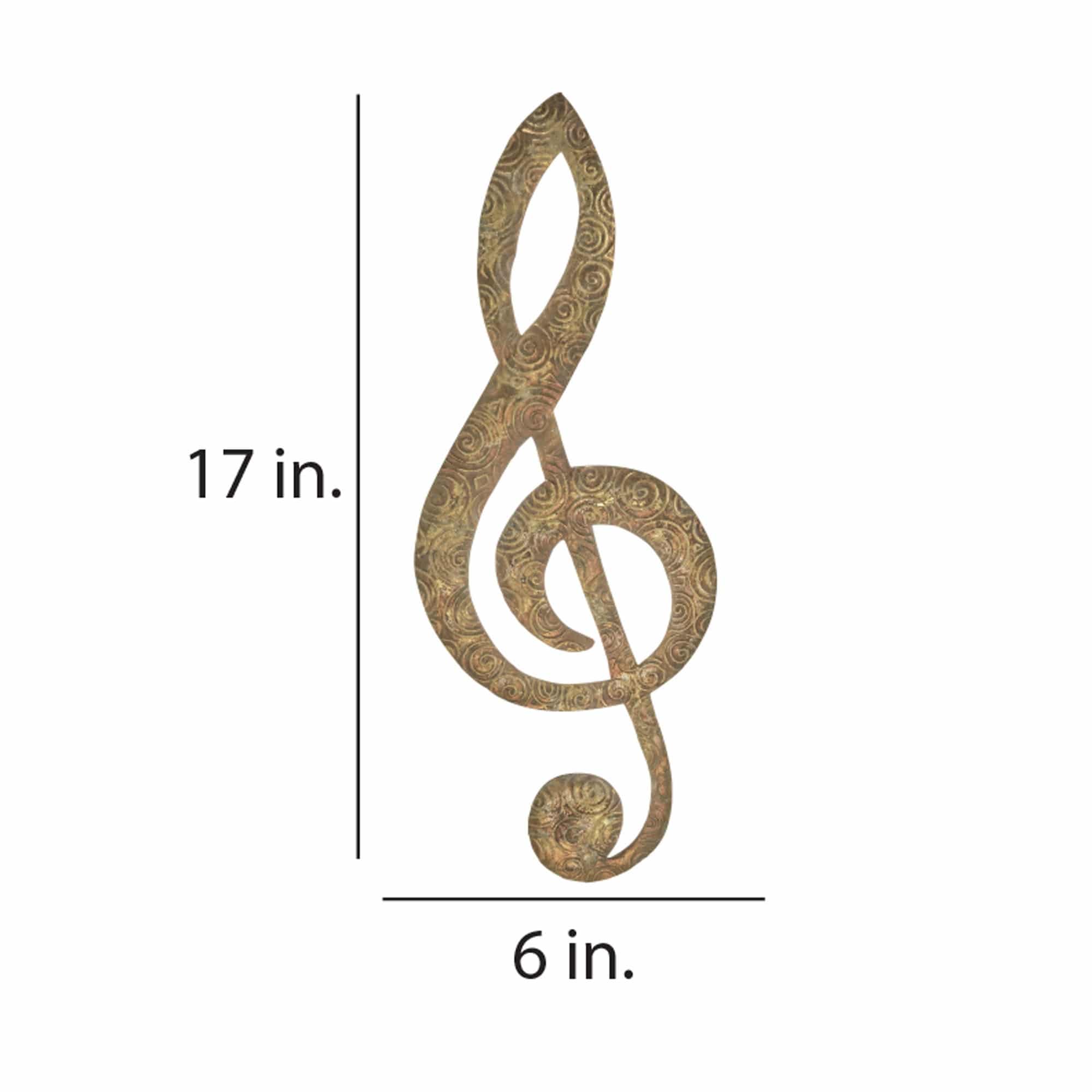
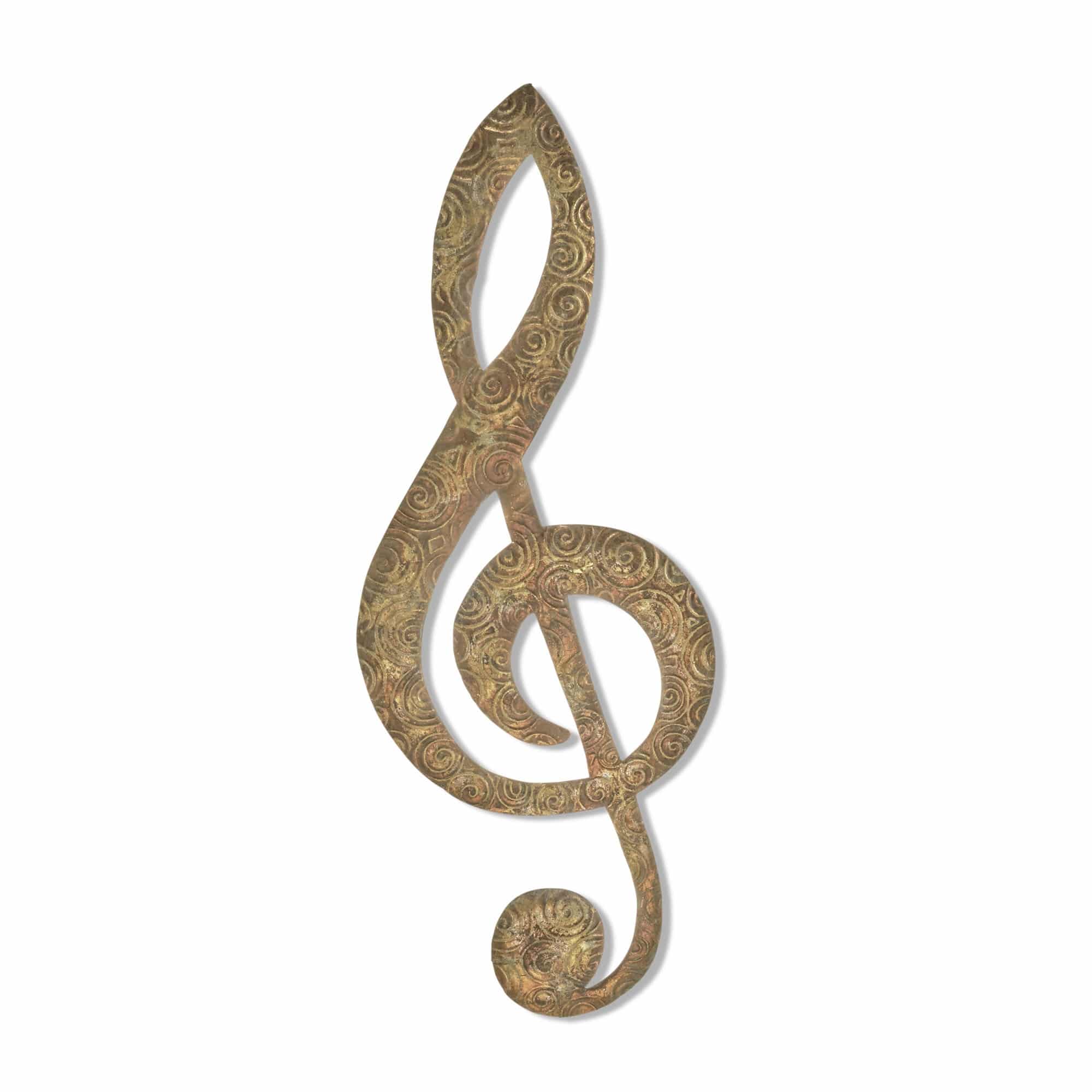 The treble clef is a musical symbol placed on one of the lines at the beginning of the staff. It indicates the name and pitch of the notes on that line. Imprinted into the treble clef are shapes and circles, symbolizing the movement of music. All components come together to give you a great textural piece to symbolize your love of music. The frame of the Music Note Wall Decor is created using tin, which is powder coated in a black finish. The frame is reinforced using wrought iron wire on the inner and outer edges. The copper paint is worked over to give it an aged and oxidized look.
The treble clef is a musical symbol placed on one of the lines at the beginning of the staff. It indicates the name and pitch of the notes on that line. Imprinted into the treble clef are shapes and circles, symbolizing the movement of music. All components come together to give you a great textural piece to symbolize your love of music. The frame of the Music Note Wall Decor is created using tin, which is powder coated in a black finish. The frame is reinforced using wrought iron wire on the inner and outer edges. The copper paint is worked over to give it an aged and oxidized look. -
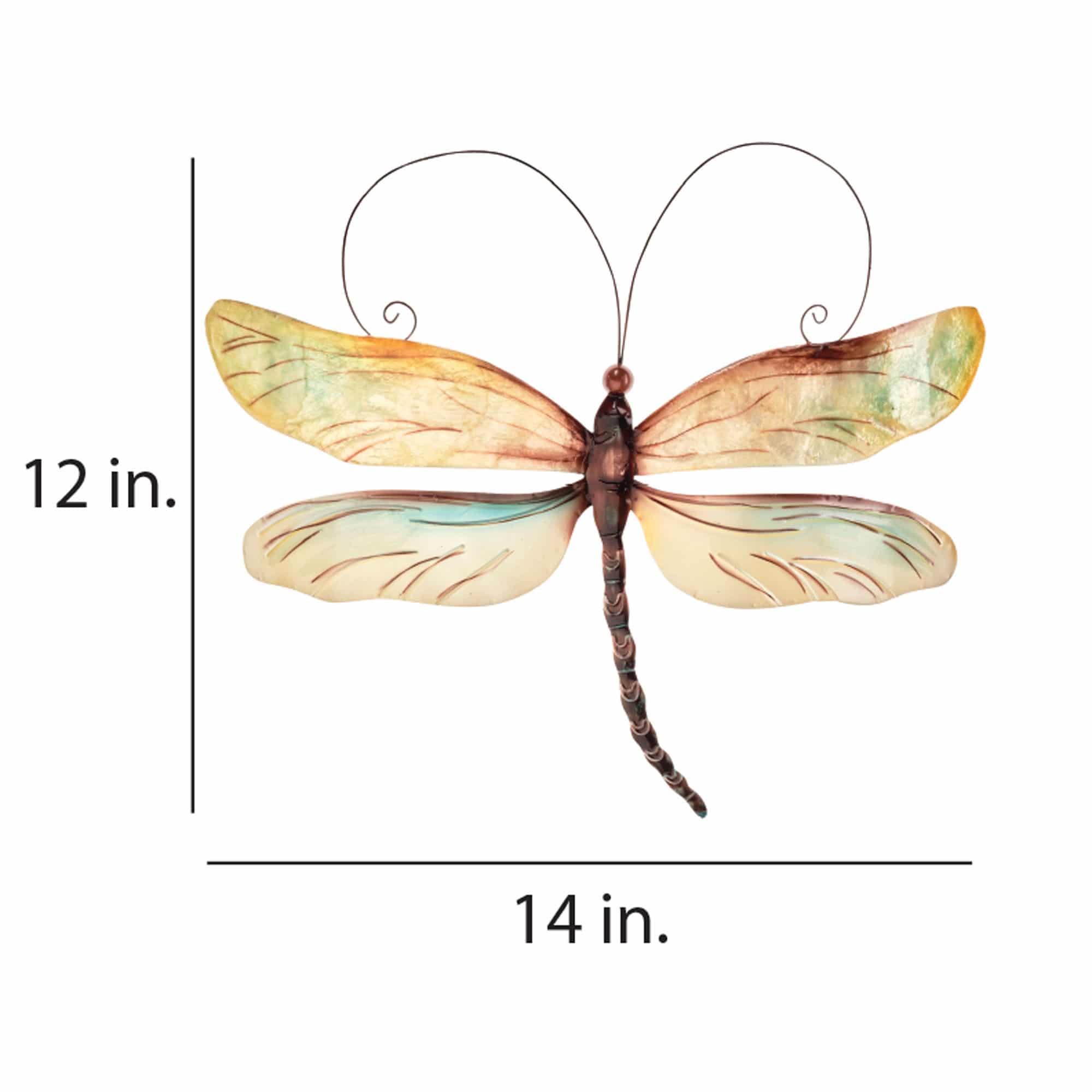
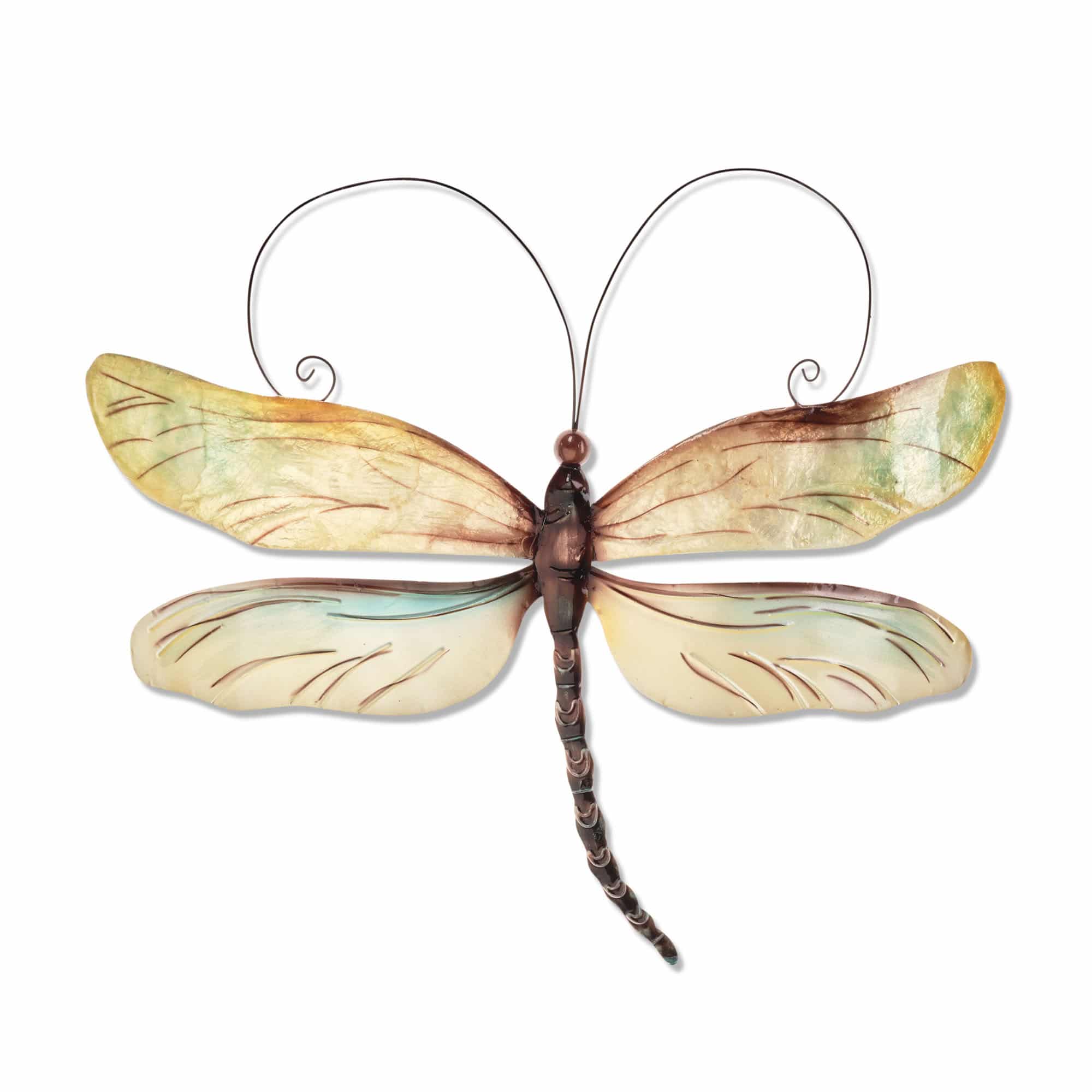
This dragonfly is extremely popular! The colors of the wings are inspired by the water of a crystal-clear lake, making the pearl wings feel translucent next to the dark body. The long flowing antenna and the shape of this dragonfly provide a classic feel to this very familiar form.
The basic frame of the dragonfly is created using tin, which is powder-coated with a black finish and makes this piece safe to use outdoors. The edges of the frame are reinforced using thicker tin wire. The front of this piece is adorned in areas with capiz shell, an oyster native to the Philippines, before being hand-painted and sealed with a water-based sealant. The primary purpose of this oyster to provide a source of food, however, the shell is a sustainable by-product that can be used for decoration. The capiz shell subtly replicates the reflective qualities of dragonflies in nature. The entire piece is lightweight and has an eyelet in the back allowing it to be hung using a finishing nail, command strip, or a push pin. Due to it being a natural material, the organic colors of capiz come through as tans and browns underneath the paint.
-

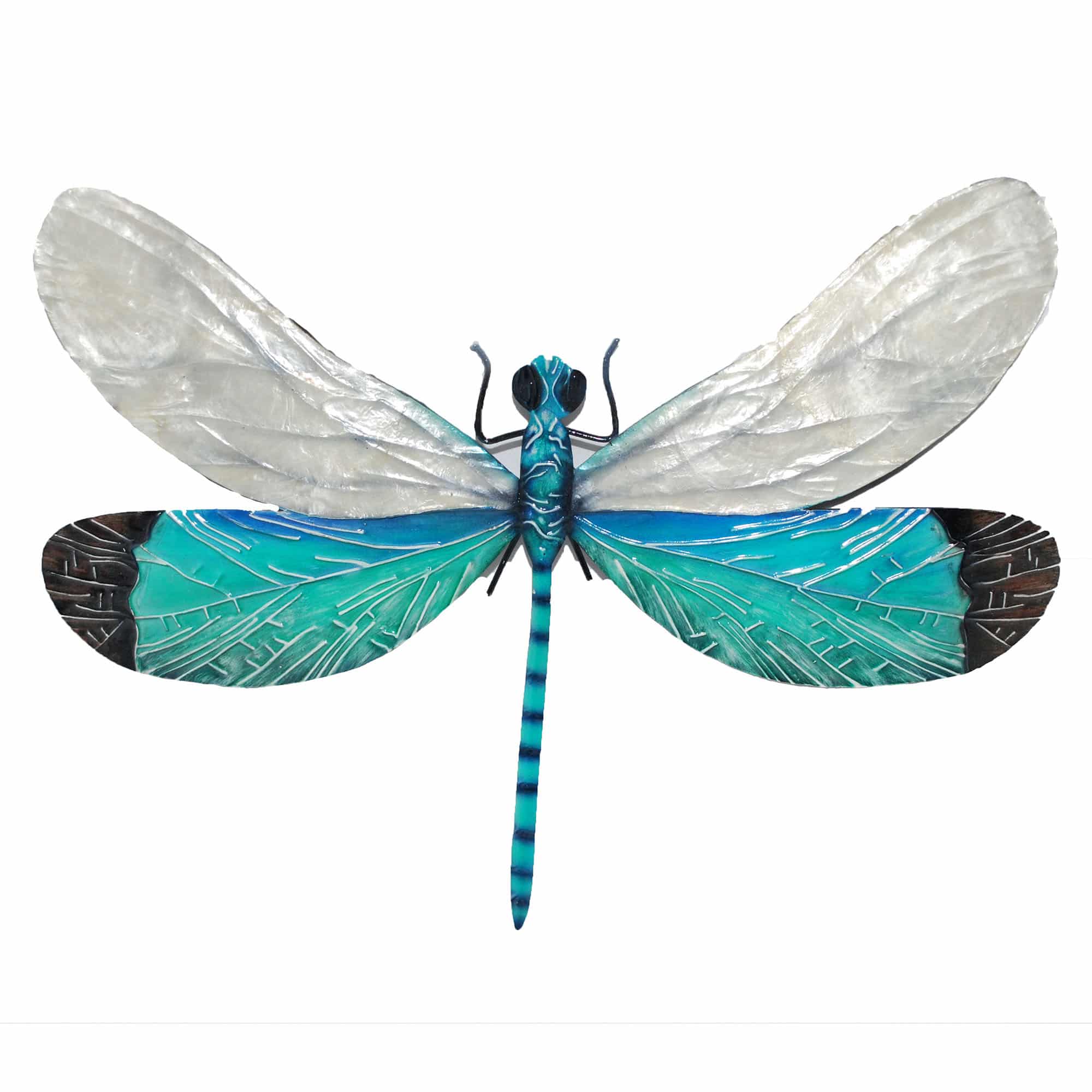
Nature is beautiful, but so is the human interpretation. The dominant color of turquoise is hand-painted on the lower wing and capiz oyster shell is used in its natural form as a reflectant on the upper wing. The combination is breathtaking when natural material and made-made influence come together in harmony.
The basic frame of the dragonfly is created using tin, which is powder-coated with a black finish and makes this piece safe to use outdoors. The edges of the frame are reinforced using thicker tin wire. The front of this piece is adorned in areas with capiz shell, an oyster native to the Philippines, before being hand-painted and sealed with a water-based sealant. The primary purpose of this oyster to provide a source of food, however, the shell is a sustainable by-product that can be used for decoration. The capiz shell subtly replicates the reflective qualities of dragonflies in nature. The entire piece is lightweight and has an eyelet in the back allowing it to be hung using a finishing nail, command strip, or a push pin. Due to it being a natural material, the organic colors of capiz come through as tans and browns underneath the paint.
-
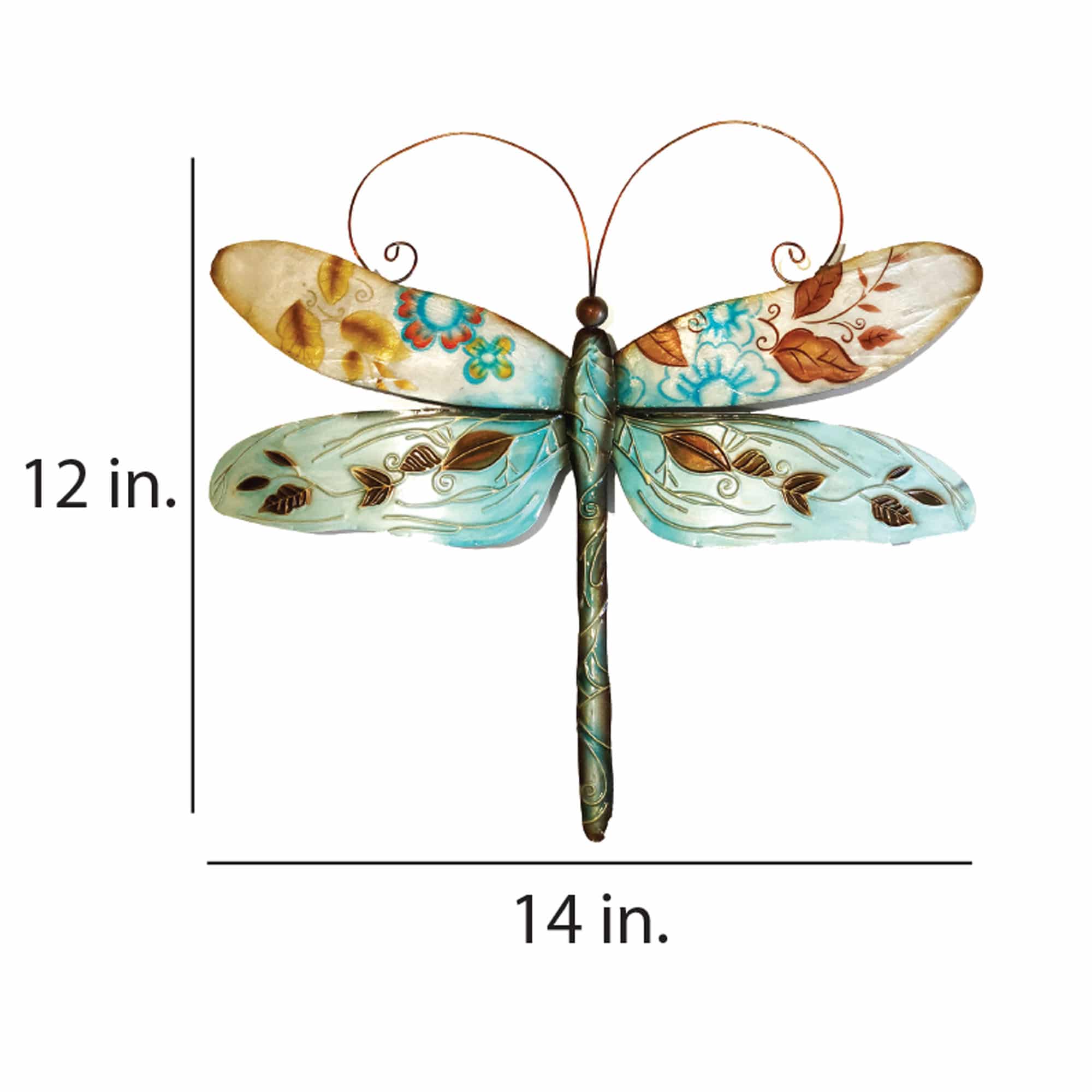
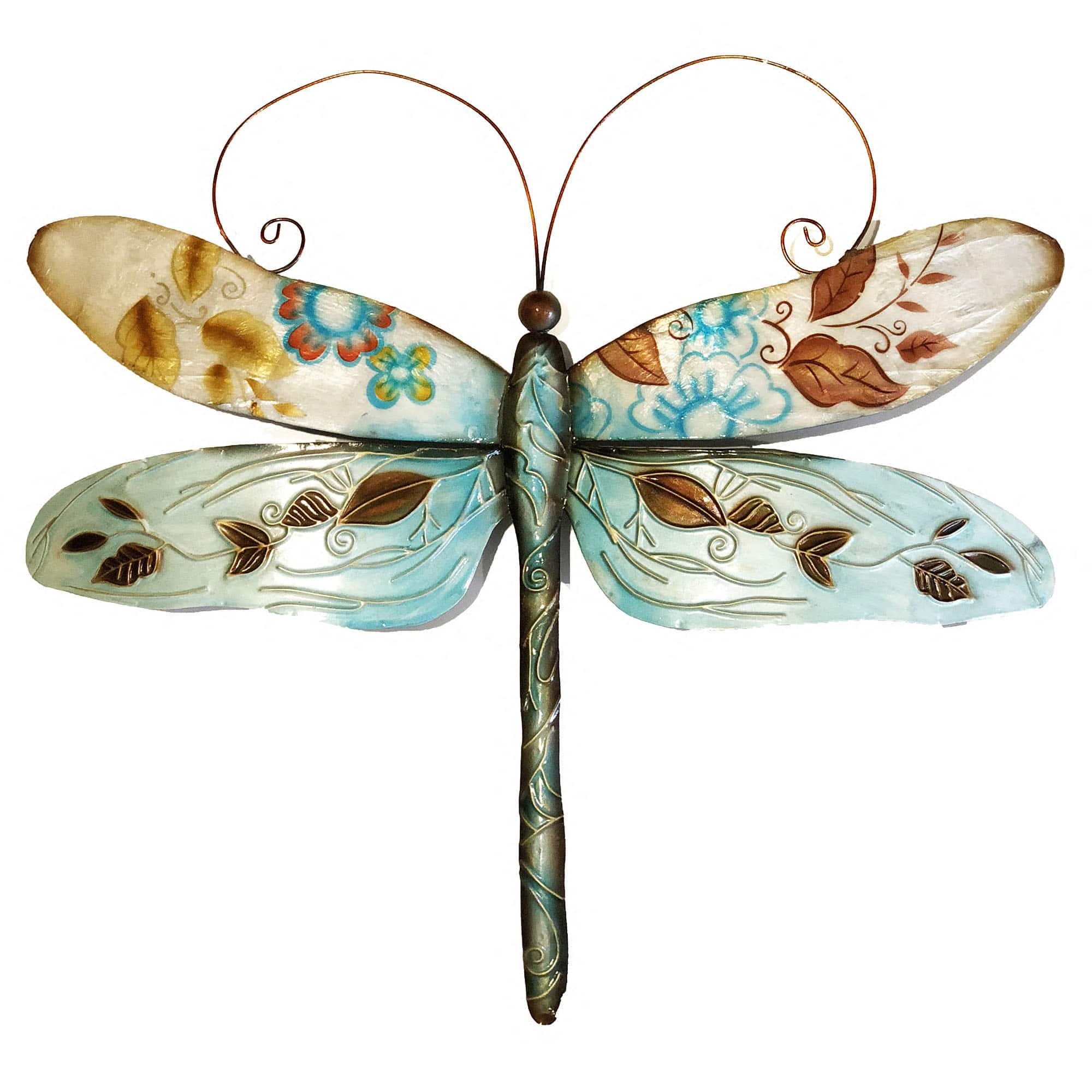
Using intricate design and cool colors, this dragonfly is sophisticated with its retro leaf and flower patterns. The upper wings are adorned with capiz shell and the flower patterns are painted lightly, complementing the translucent color seen in the natural butterfly. The lower wings are constructed from tin, textured, colored with a burst of turquoise and accented with golds and reds. Great for nearly all decor styles, this piece works great in contemporary, modern, traditional, and farm house settings.
The basic frame of the dragonfly is created using tin, which is powder-coated with a black finish and makes this piece safe to use outdoors. The edges of the frame are reinforced using thicker tin wire. The front of this piece is adorned in areas with capiz shell, an oyster native to the Philippines, before being hand-painted and sealed with a water-based sealant. The primary purpose of this oyster to provide a source of food, however, the shell is a sustainable by-product that can be used for decoration. The capiz shell subtly replicates the reflective qualities of dragonflies in nature. The entire piece is lightweight and has an eyelet in the back allowing it to be hung using a finishing nail, command strip, or a push pin. Due to it being a natural material, the organic colors of capiz come through as tans and browns underneath the paint.
-

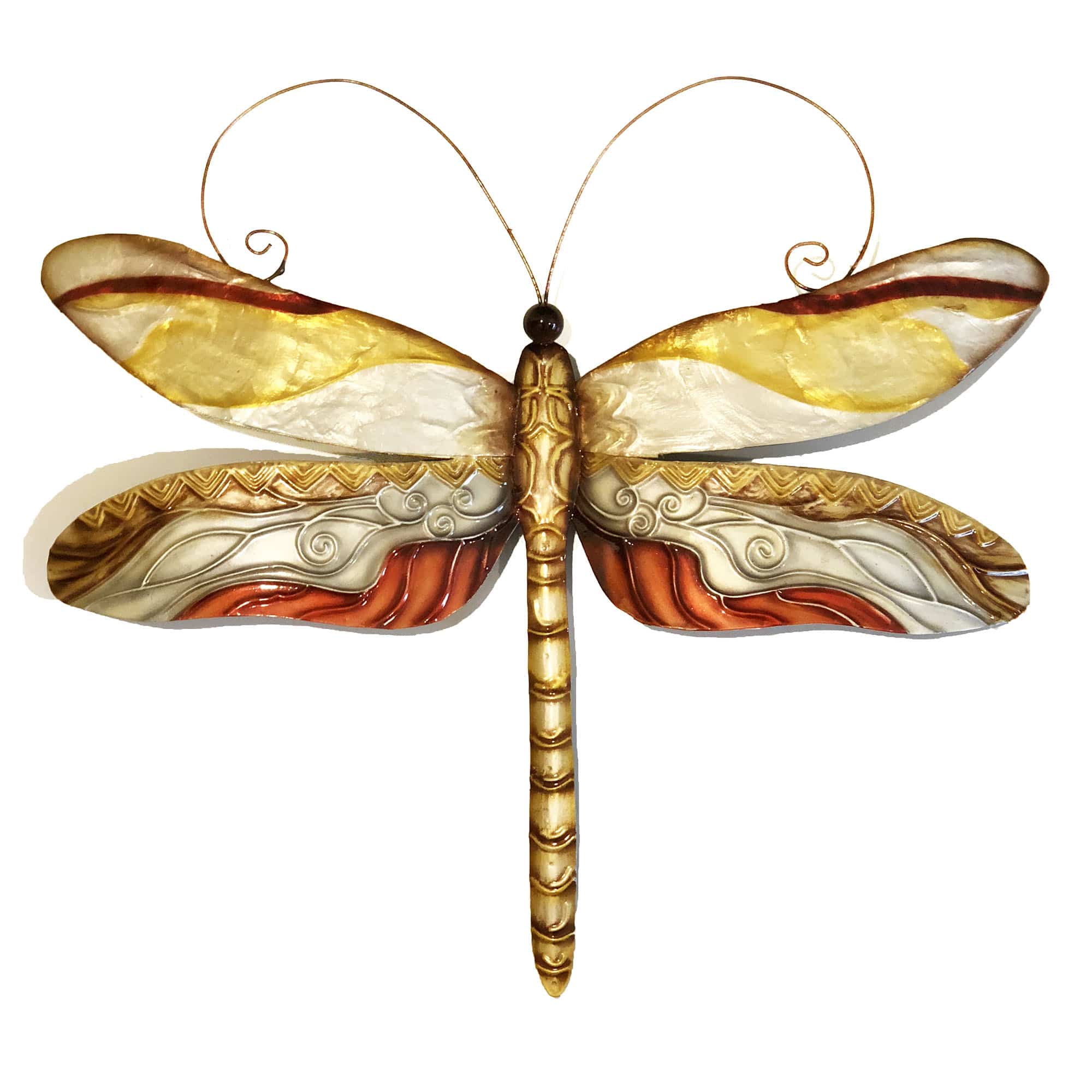
This piece features a bevy of contrasting patterns that create a unique and fun pattern for a modern or contemporary work of art. The dragonfly uses muted, warm colors that add depth to any space. The upper wing is constructed using capiz shell hand painted with soft colors, in contrast to the lower wing, crafted out of tin, textured, colored with darker hues of the same color pallet.
The basic frame of the dragonfly is created using tin, which is powder-coated with a black finish and makes this piece safe to use outdoors. The edges of the frame are reinforced using thicker tin wire. The front of this piece is adorned in areas with capiz shell, an oyster native to the Philippines, before being hand-painted and sealed with a water-based sealant. The primary purpose of this oyster to provide a source of food, however, the shell is a sustainable by-product that can be used for decoration. The capiz shell subtly replicates the reflective qualities of dragonflies in nature. The entire piece is lightweight and has an eyelet in the back allowing it to be hung using a finishing nail, command strip, or a push pin. Due to it being a natural material, the organic colors of capiz come through as tans and browns underneath the paint.
-
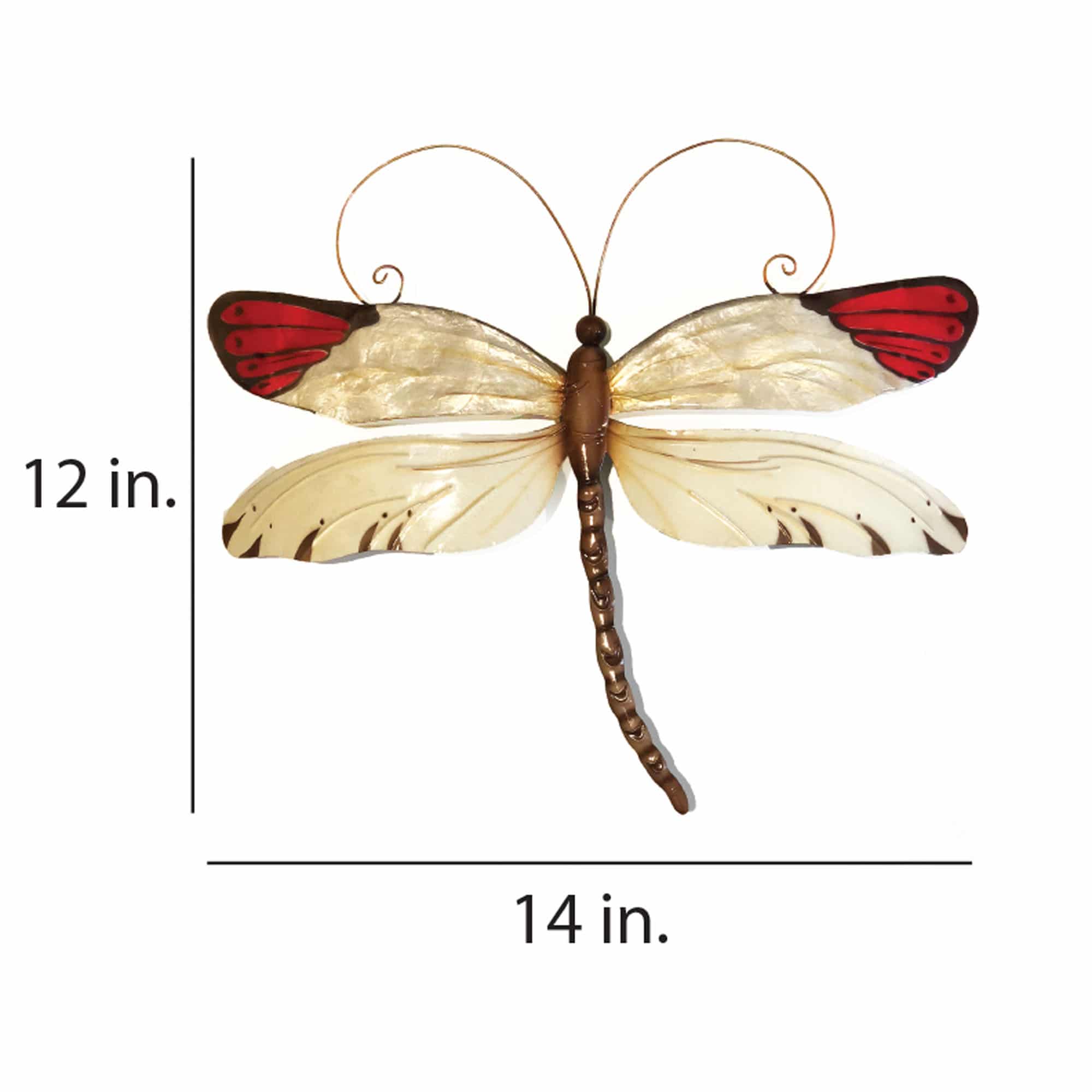

Starting with a base color of pearl white, the artist uses different techniques and splashes of color to craft a distinctive piece. The upper wings are created using capiz oyster shell, left natural to bring in different natural hues. The red base color is accented using brown feathering patterns. The lower portion of the wing is made of tin, textured to highlight the lines that stem from the body of the dragonfly.
The basic frame of the dragonfly is created using tin, which is powder-coated with a black finish and makes this piece safe to use outdoors. The edges of the frame are reinforced using thicker tin wire. The front of this piece is adorned in areas with capiz shell, an oyster native to the Philippines, before being hand-painted and sealed with a water-based sealant. The primary purpose of this oyster to provide a source of food, however, the shell is a sustainable by-product that can be used for decoration. The capiz shell subtly replicates the reflective qualities of dragonflies in nature. The entire piece is lightweight and has an eyelet in the back allowing it to be hung using a finishing nail, command strip, or a push pin. Due to it being a natural material, the organic colors of capiz come through as tans and browns underneath the paint.
-

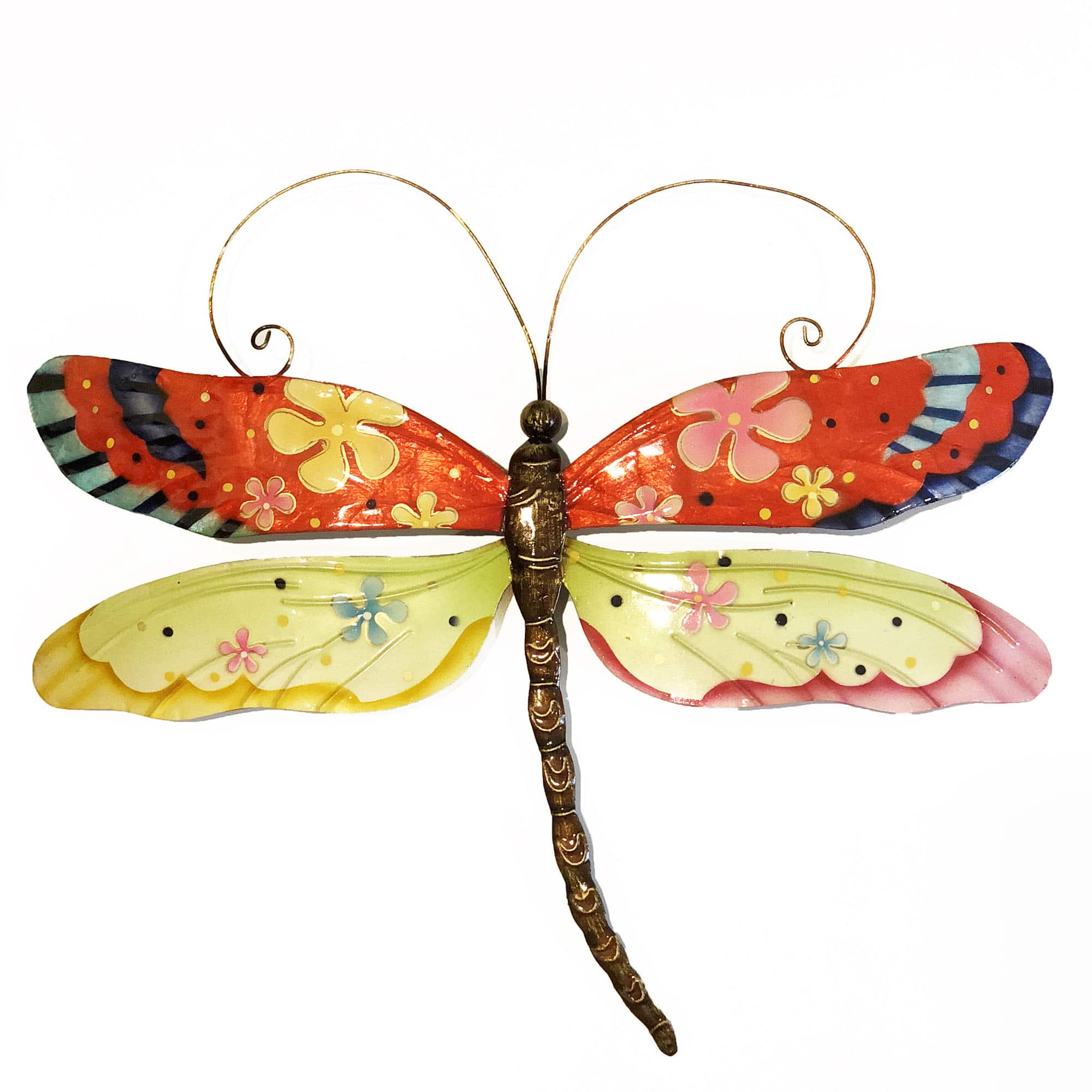
Colorful, fun, and full of cheer, this dragonfly gets its influence from the flower power movement of years past. Designed to stand out, this piece adds a powerful pop of color and pizzazz to any space.
The basic frame of the dragonfly is created using tin, which is powder-coated with a black finish and makes this piece safe to use outdoors. The edges of the frame are reinforced using thicker tin wire. The front of this piece is adorned in areas with capiz shell, an oyster native to the Philippines, before being hand-painted and sealed with a water-based sealant. The primary purpose of this oyster to provide a source of food, however, the shell is a sustainable by-product that can be used for decoration. The capiz shell subtly replicates the reflective qualities of dragonflies in nature. The entire piece is lightweight and has an eyelet in the back allowing it to be hung using a finishing nail, command strip, or a push pin. Due to it being a natural material, the organic colors of capiz come through as tans and browns underneath the paint.
-


Using paints of various shades and different hues of yellow, this graceful dragonfly features an appearance of flowing honey on its upper wings. The lower wings diverge from the honey and are textured in a base white color with highlights of yellow. Stylish and elegant, this piece adds sophistication to the finish of any room, contemporary or traditional.
The basic frame of the dragonfly is created using tin, which is powder-coated with a black finish and makes this piece safe to use outdoors. The edges of the frame are reinforced using thicker tin wire. The front of this piece is adorned in areas with capiz shell, an oyster native to the Philippines, before being hand-painted and sealed with a water-based sealant. The primary purpose of this oyster to provide a source of food, however, the shell is a sustainable by-product that can be used for decoration. The capiz shell subtly replicates the reflective qualities of dragonflies in nature. The entire piece is lightweight and has an eyelet in the back allowing it to be hung using a finishing nail, command strip, or a push pin. Due to it being a natural material, the organic colors of capiz come through as tans and browns underneath the paint.
-
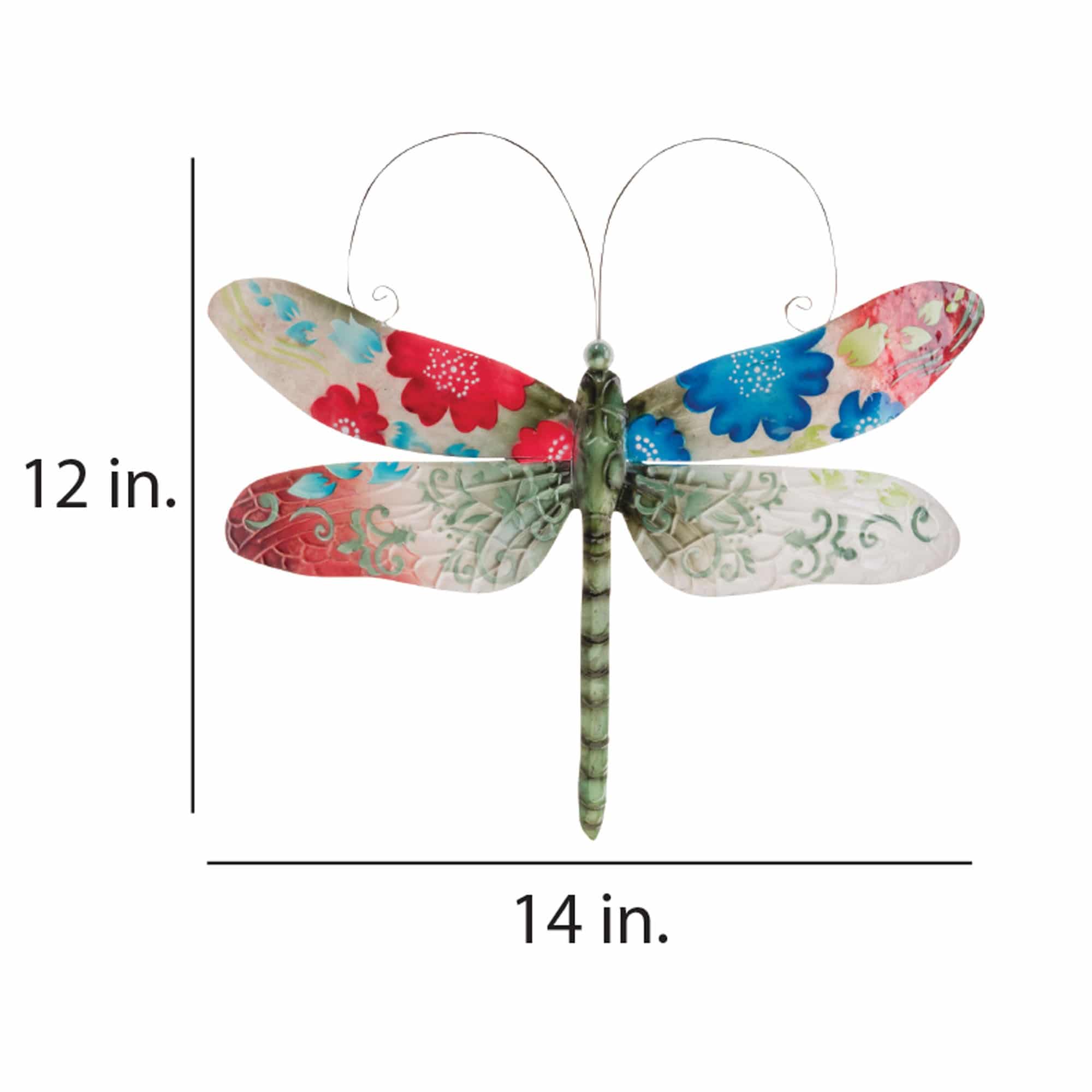
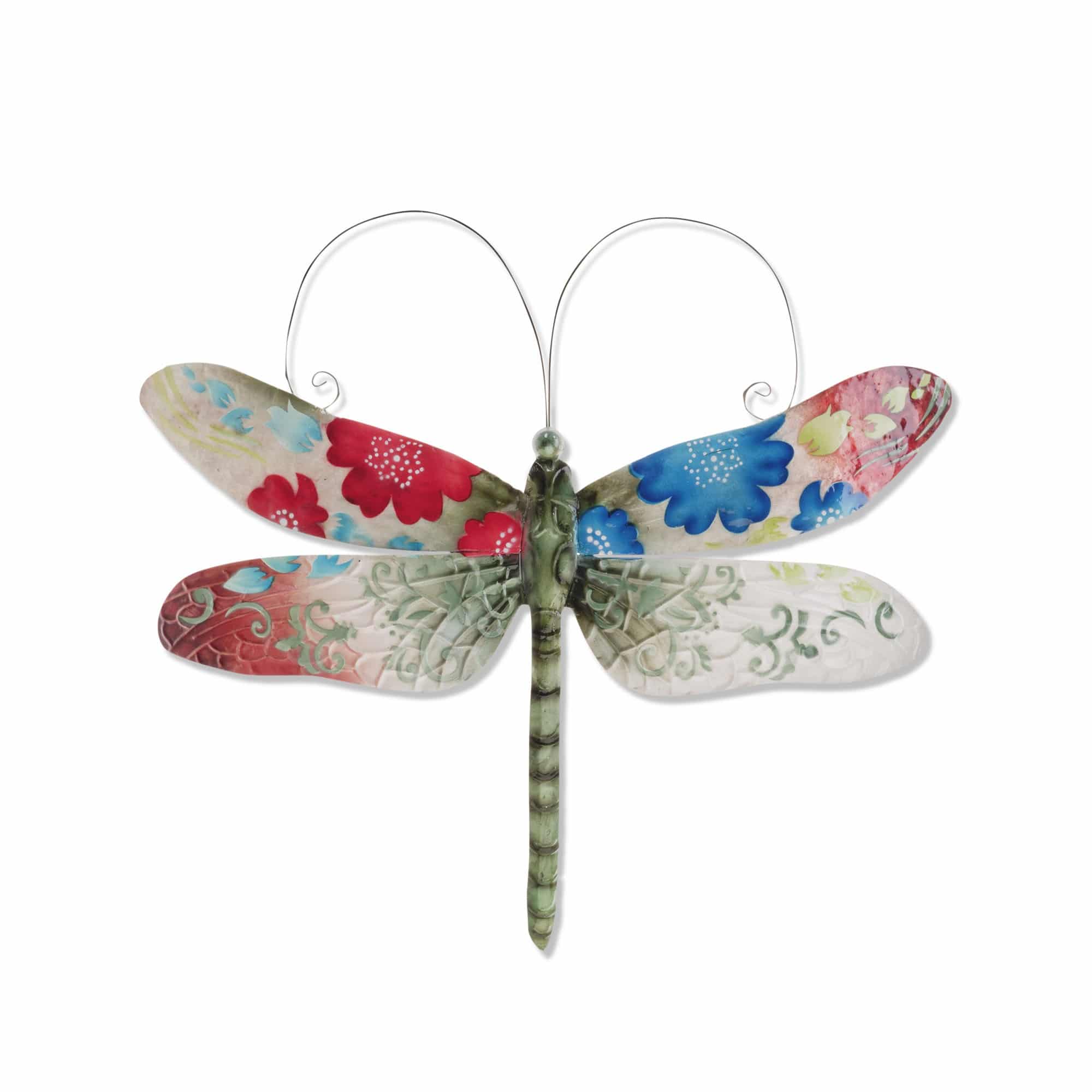
With colorful rising flowers, this dragonfly represents spring rising to overtake winter's cold. The bold tones will provide strong accent to any space. A mix of color and designs painted on the wings add depth and dimension.
The basic frame of the dragonfly is created using tin, which is powder-coated with a black finish and makes this piece safe to use outdoors. The edges of the frame are reinforced using thicker tin wire. The front of this piece is adorned in areas with capiz shell, an oyster native to the Philippines, before being hand-painted and sealed with a water-based sealant. The primary purpose of this oyster to provide a source of food, however, the shell is a sustainable by-product that can be used for decoration. The capiz shell subtly replicates the reflective qualities of dragonflies in nature. The entire piece is lightweight and has an eyelet in the back allowing it to be hung using a finishing nail, command strip, or a push pin. Due to it being a natural material, the organic colors of capiz come through as tans and browns underneath the paint.
-
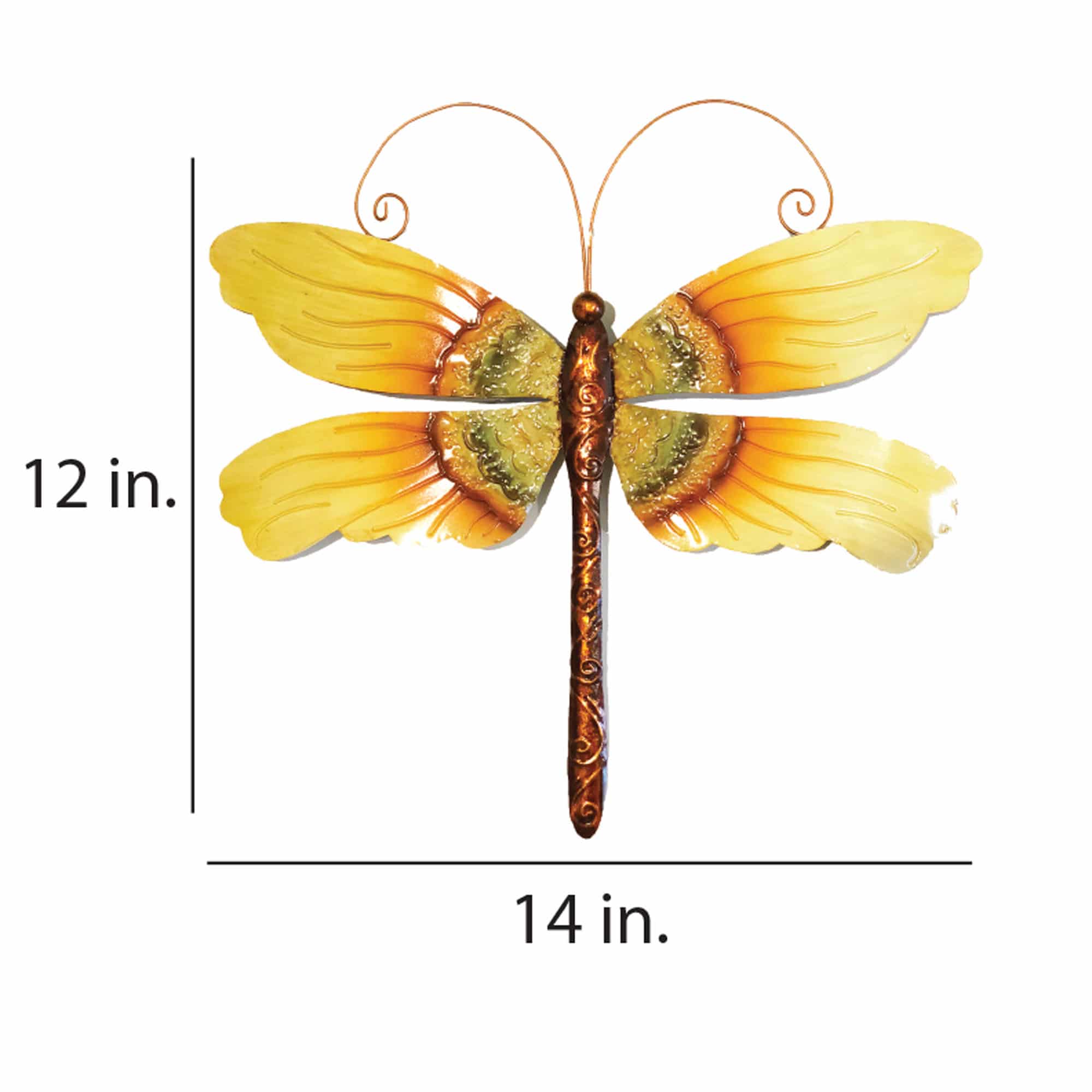
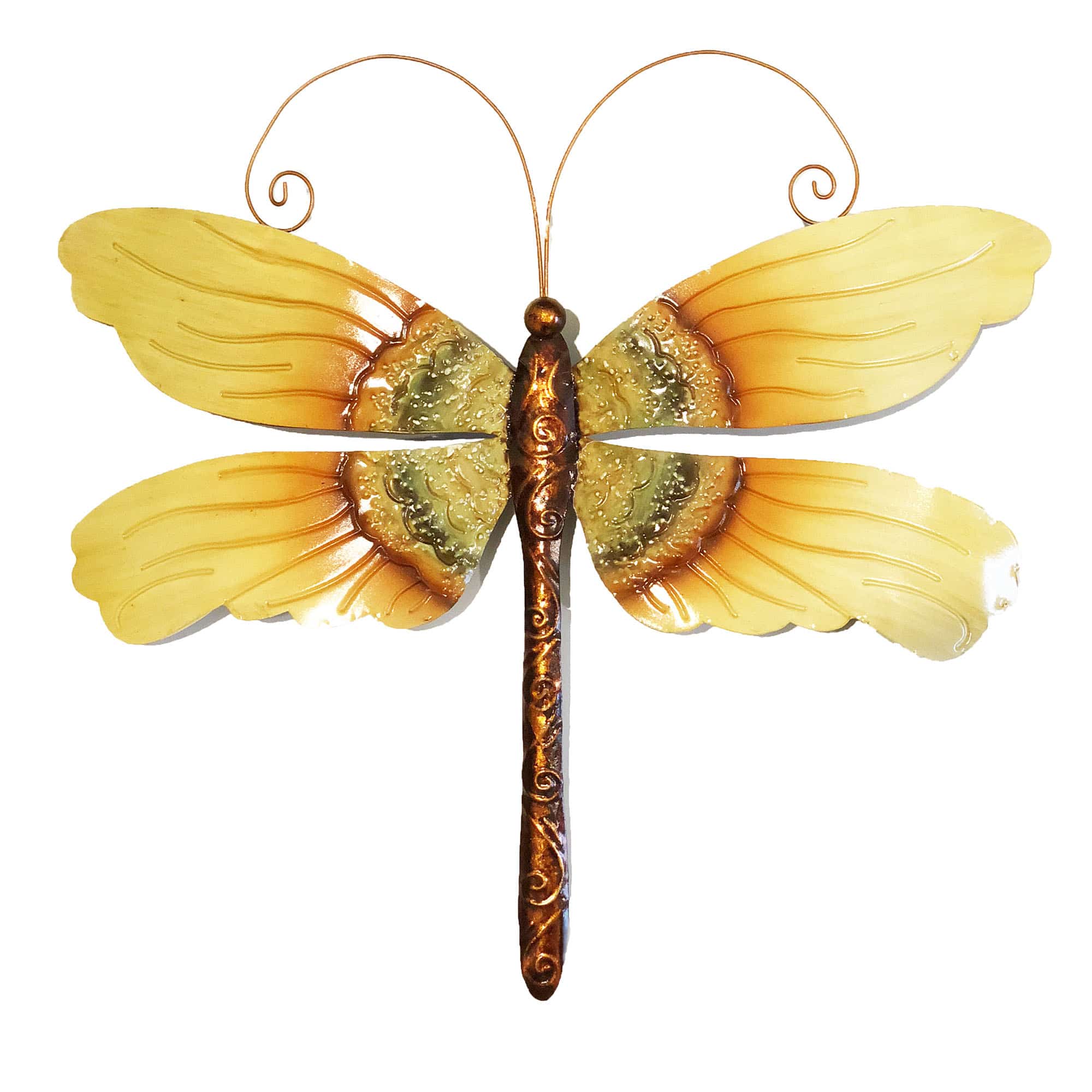 Subtle brown leaves curling and two sunflowers in full bloom provides the feeling of transition from summer to autumn. Even the base color is in the brown hue, enhancing the seasonal transition. The basic frame of the dragonfly is created using tin, which is powder-coated with a black finish and makes this piece safe to use outdoors. The edges of the frame are reinforced using thicker tin wire. The front of this piece is hand-painted and sealed with a water-based sealant. The entire piece is lightweight and has an eyelet in the back allowing it to be hung using a finishing nail, command strip, or a push pin. Due to it being a natural material, the organic colors of capiz come through as tans and browns underneath the paint.
Subtle brown leaves curling and two sunflowers in full bloom provides the feeling of transition from summer to autumn. Even the base color is in the brown hue, enhancing the seasonal transition. The basic frame of the dragonfly is created using tin, which is powder-coated with a black finish and makes this piece safe to use outdoors. The edges of the frame are reinforced using thicker tin wire. The front of this piece is hand-painted and sealed with a water-based sealant. The entire piece is lightweight and has an eyelet in the back allowing it to be hung using a finishing nail, command strip, or a push pin. Due to it being a natural material, the organic colors of capiz come through as tans and browns underneath the paint. -


The wings of this dragonfly are rather large and stately, particularly when this beauty flies on the breeze from flower to flower. The artist brings this to life by crafting the body smaller compared to the wings. The wings are adorned with capiz shell, giving it the translucent color seen in a natural dragonfly. Veins are drawn in throughout it and accentuated on its back are bright red spots, meant to pop out.
The basic frame of the dragonfly is created using tin, which is powder-coated with a black finish and makes this piece safe to use outdoors. The edges of the frame are reinforced using thicker tin wire. The front of this piece is adorned in areas with capiz shell, an oyster native to the Philippines, before being hand-painted and sealed with a water-based sealant. The primary purpose of this oyster to provide a source of food, however, the shell is a sustainable by-product that can be used for decoration. The capiz shell subtly replicates the reflective qualities of dragonflies in nature. The entire piece is lightweight and has an eyelet in the back allowing it to be hung using a finishing nail, command strip, or a push pin. Due to it being a natural material, the organic colors of capiz come through as tans and browns underneath the paint.
-
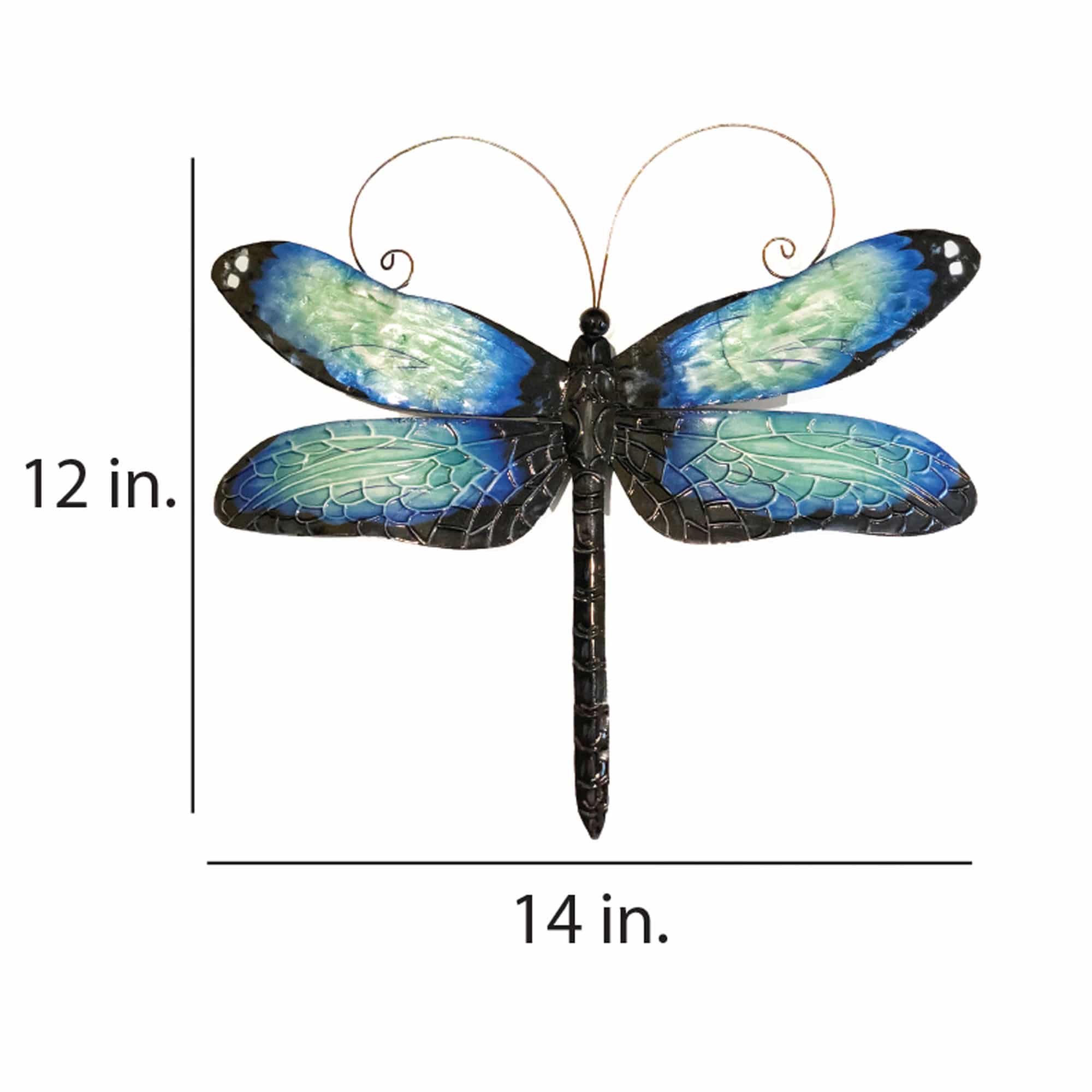
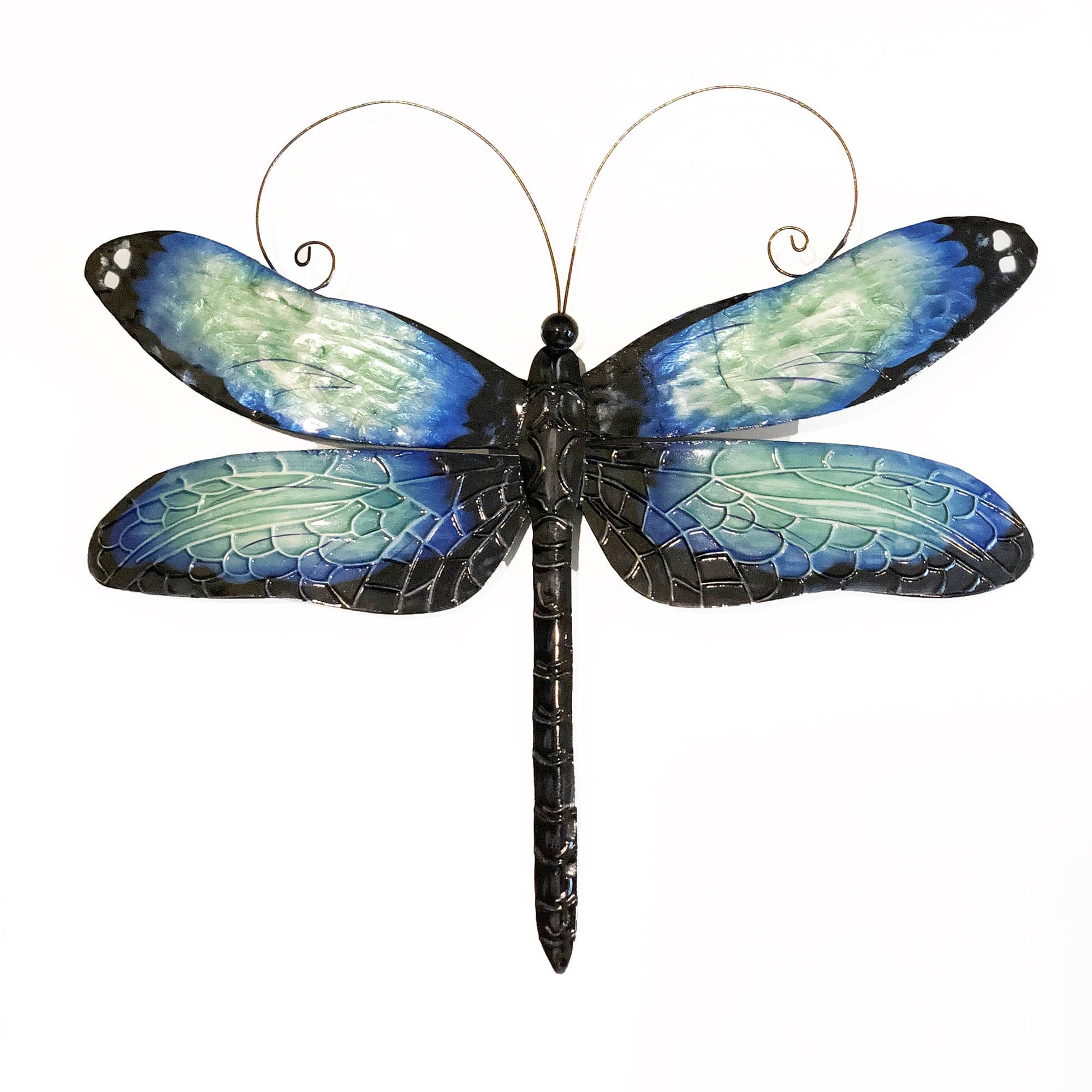
These swift fliers fly low to the ground and do not stay in one spot for very long. The artist captured bright cobalt blue color which is truly striking. Accent your wall with a color that has been given a stamp of approval by nature.
The basic frame of the dragonfly is created using tin, which is powder-coated with a black finish and makes this piece safe to use outdoors. The edges of the frame are reinforced using thicker tin wire. The front of this piece is adorned in areas with capiz shell, an oyster native to the Philippines, before being hand-painted and sealed with a water-based sealant. The primary purpose of this oyster to provide a source of food, however, the shell is a sustainable by-product that can be used for decoration. The capiz shell subtly replicates the reflective qualities of dragonflies in nature. The entire piece is lightweight and has an eyelet in the back allowing it to be hung using a finishing nail, command strip, or a push pin. Due to it being a natural material, the organic colors of capiz come through as tans and browns underneath the paint.
-
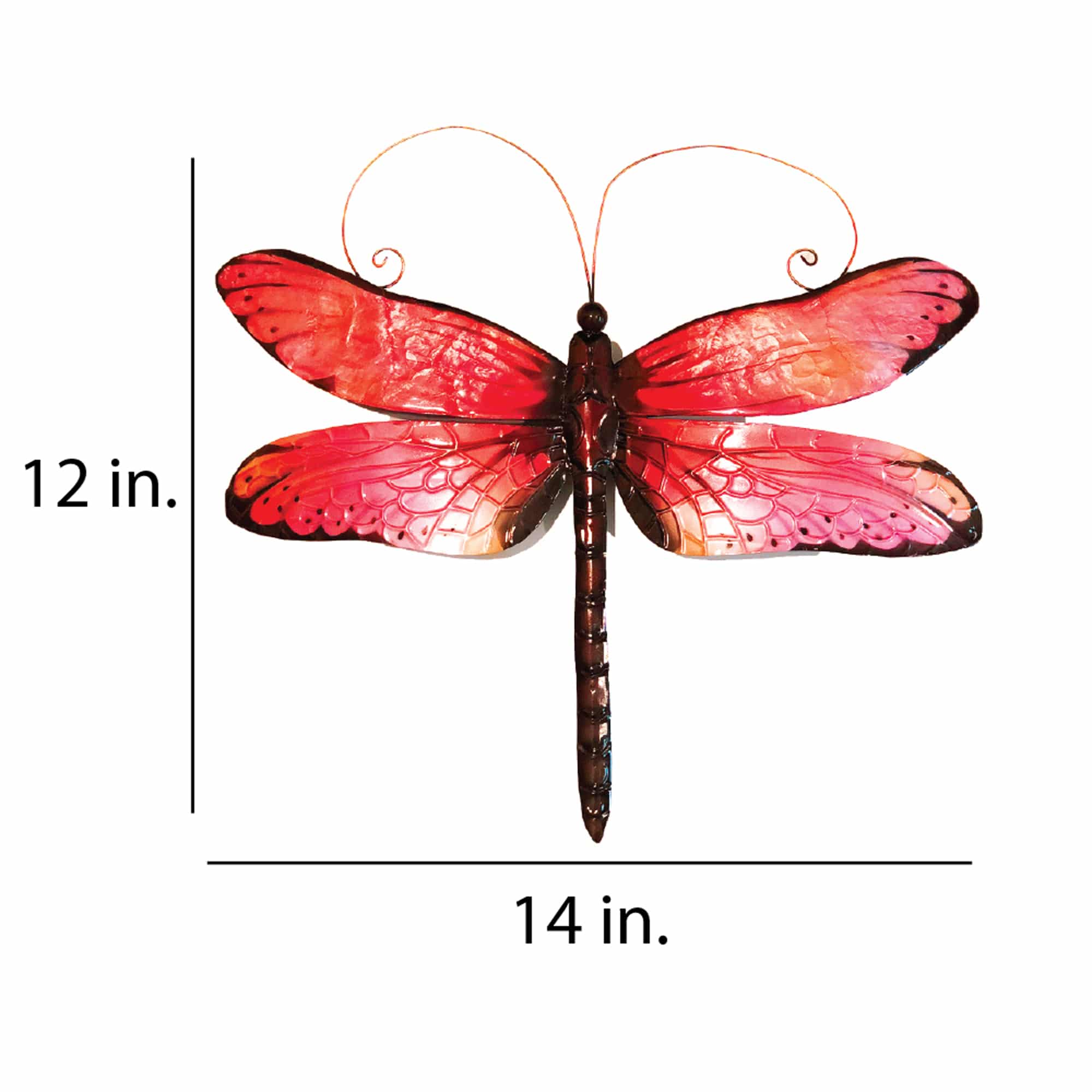
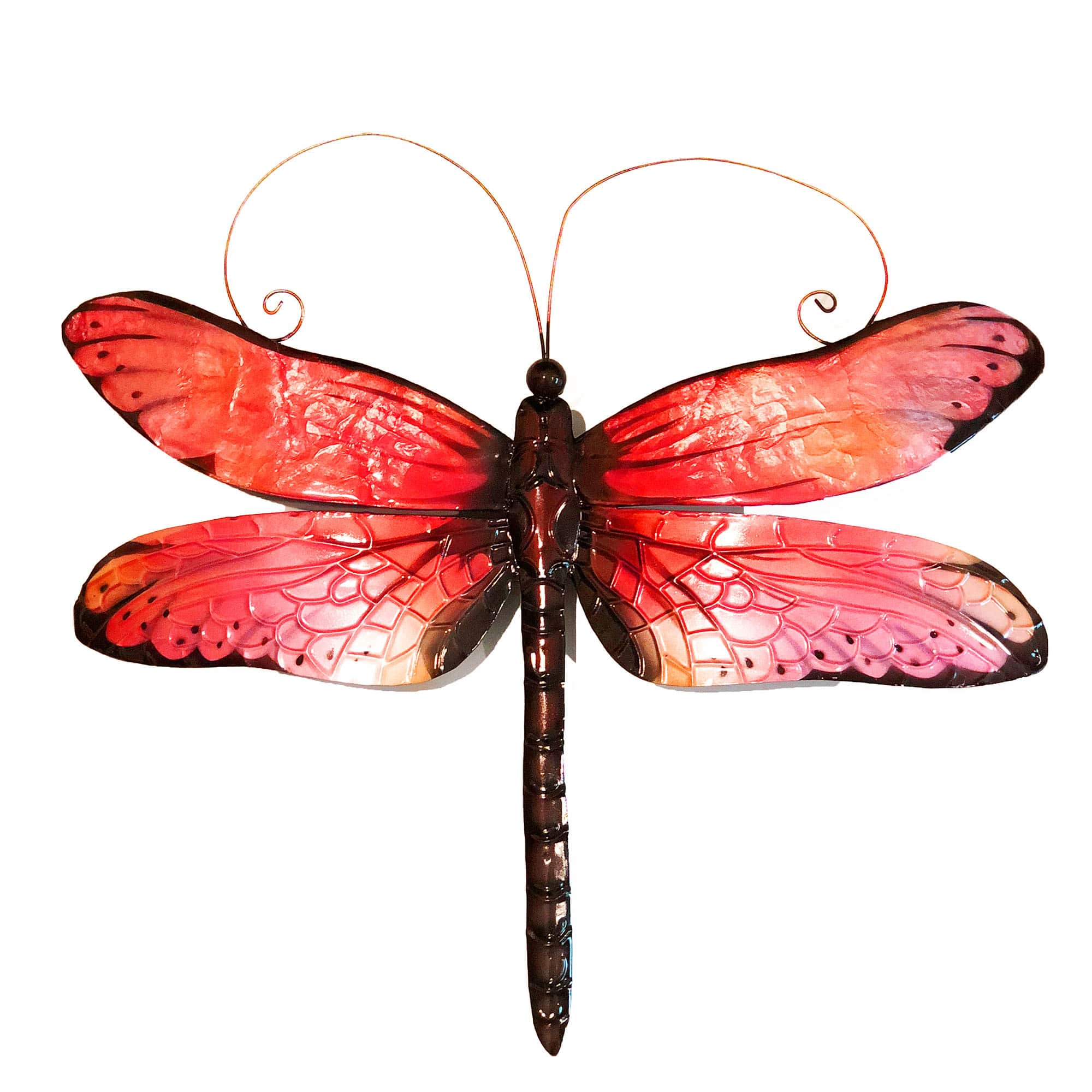
The artists truly captured the bold reds and contrasting black that this dragonfly is known for in its natural form. To enhance the illusion of transparency, the artists use capiz shell in the upper wing to reflect more light. Hand-painted, but with varying degree of hue, this butterfly will feel like the real deal on your wall, except for the size of course.
The basic frame of the dragonfly is created using tin, which is powder-coated with a black finish and makes this piece safe to use outdoors. The edges of the frame are reinforced using thicker tin wire. The front of this piece is adorned in areas with capiz shell, an oyster native to the Philippines, before being hand-painted and sealed with a water-based sealant. The primary purpose of this oyster to provide a source of food, however, the shell is a sustainable by-product that can be used for decoration. The capiz shell subtly replicates the reflective qualities of dragonflies in nature. The entire piece is lightweight and has an eyelet in the back allowing it to be hung using a finishing nail, command strip, or a push pin. Due to it being a natural material, the organic colors of capiz come through as tans and browns underneath the paint.
-
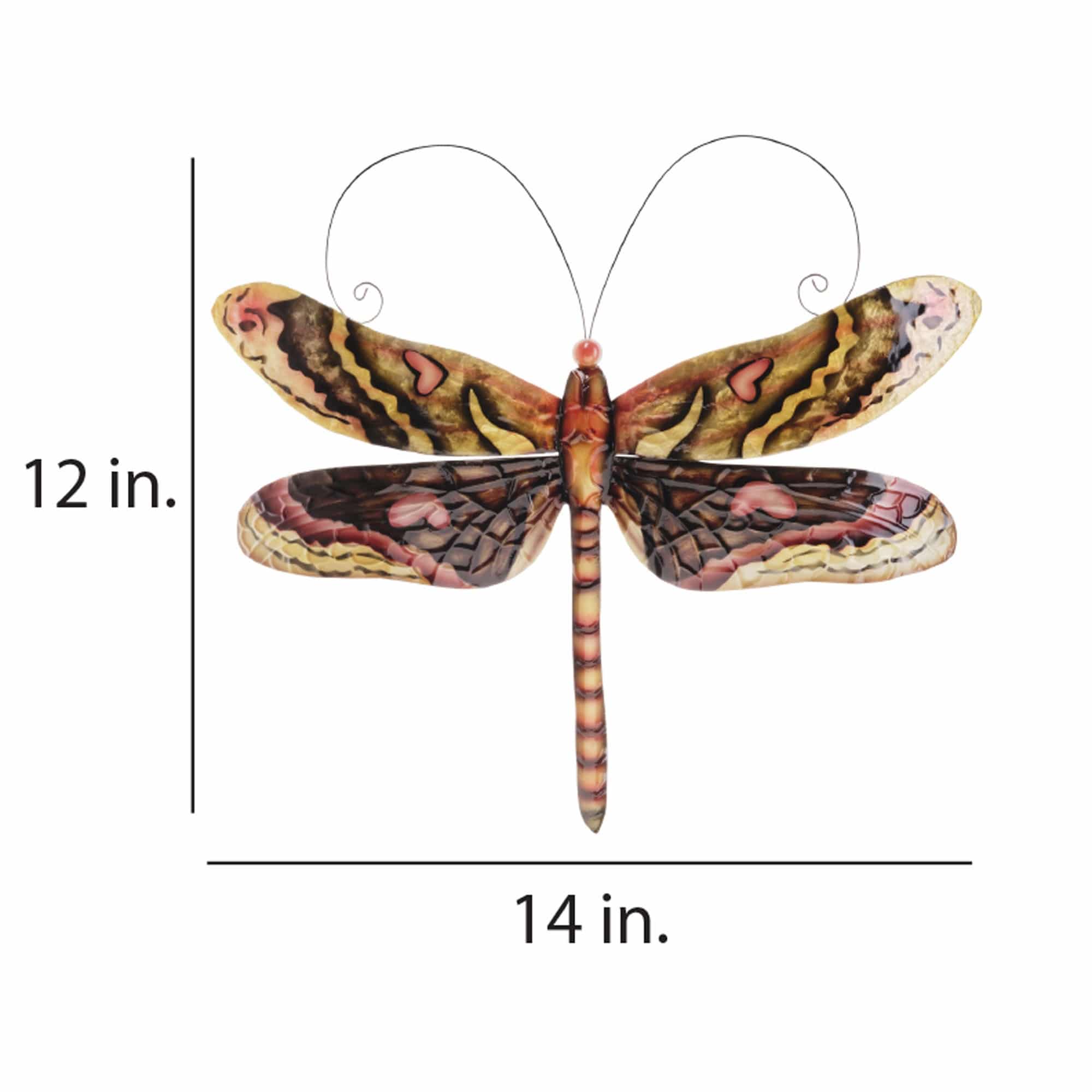
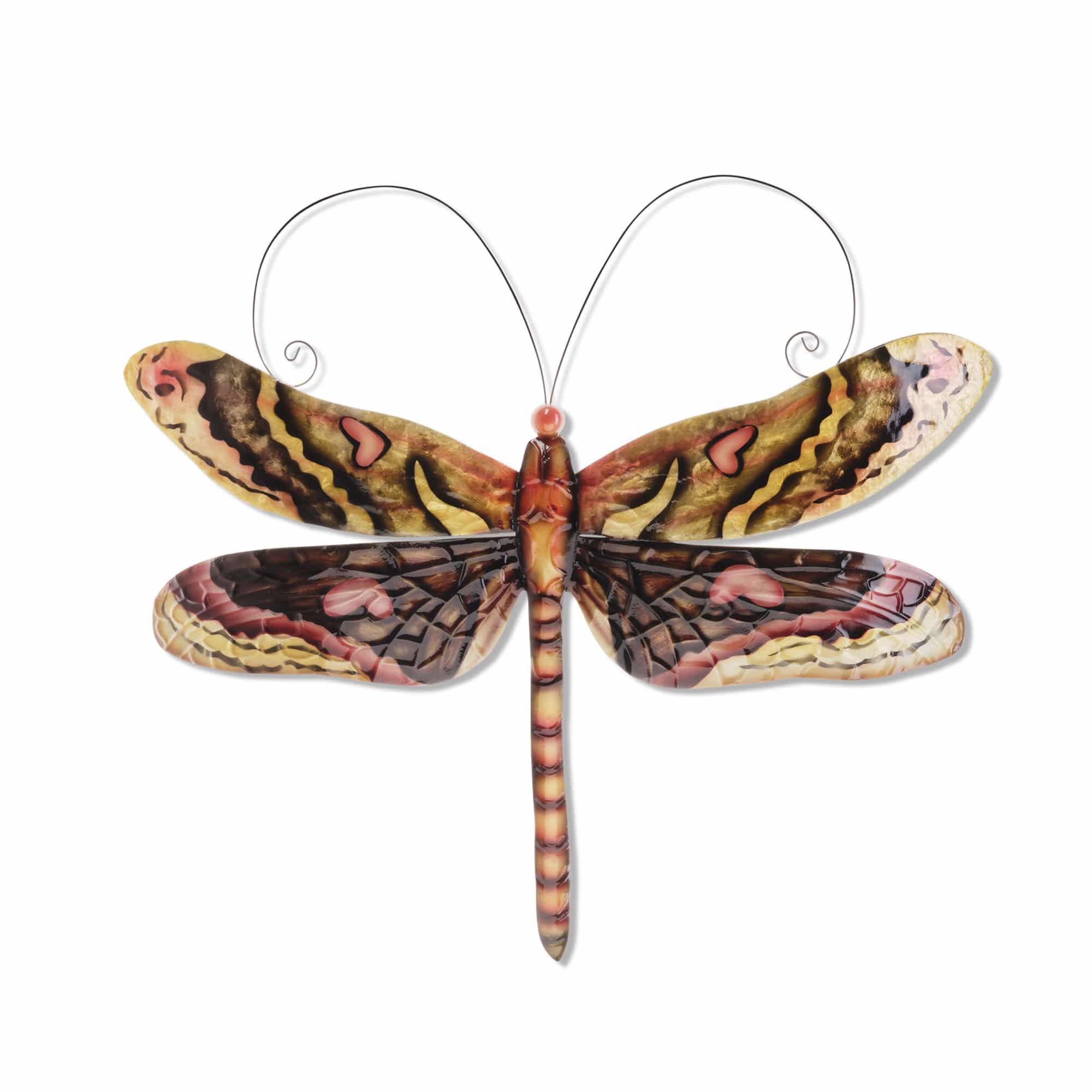
Dragonflies play a vital role in telling us the health of our natural environments. They can be just as colorful as butterflies and many other insects. The artist brings out the earth tones with a hint of the reds in this piece. The mix of color and design is intricately painted on the frontside of the wings and body. The artist brings out the reflective nature of the wings using capiz shell. <
The basic frame of the dragonfly is created using tin, which is powder-coated with a black finish and makes this piece safe to use outdoors. The edges of the frame are reinforced using thicker tin wire. The front of this piece is adorned in areas with capiz shell, an oyster native to the Philippines, before being hand-painted and sealed with a water-based sealant. The primary purpose of this oyster to provide a source of food, however, the shell is a sustainable by-product that can be used for decoration. The capiz shell subtly replicates the reflective qualities of dragonflies in nature. The entire piece is lightweight and has an eyelet in the back allowing it to be hung using a finishing nail, command strip, or a push pin. Due to it being a natural material, the organic colors of capiz come through as tans and browns underneath the paint.
-
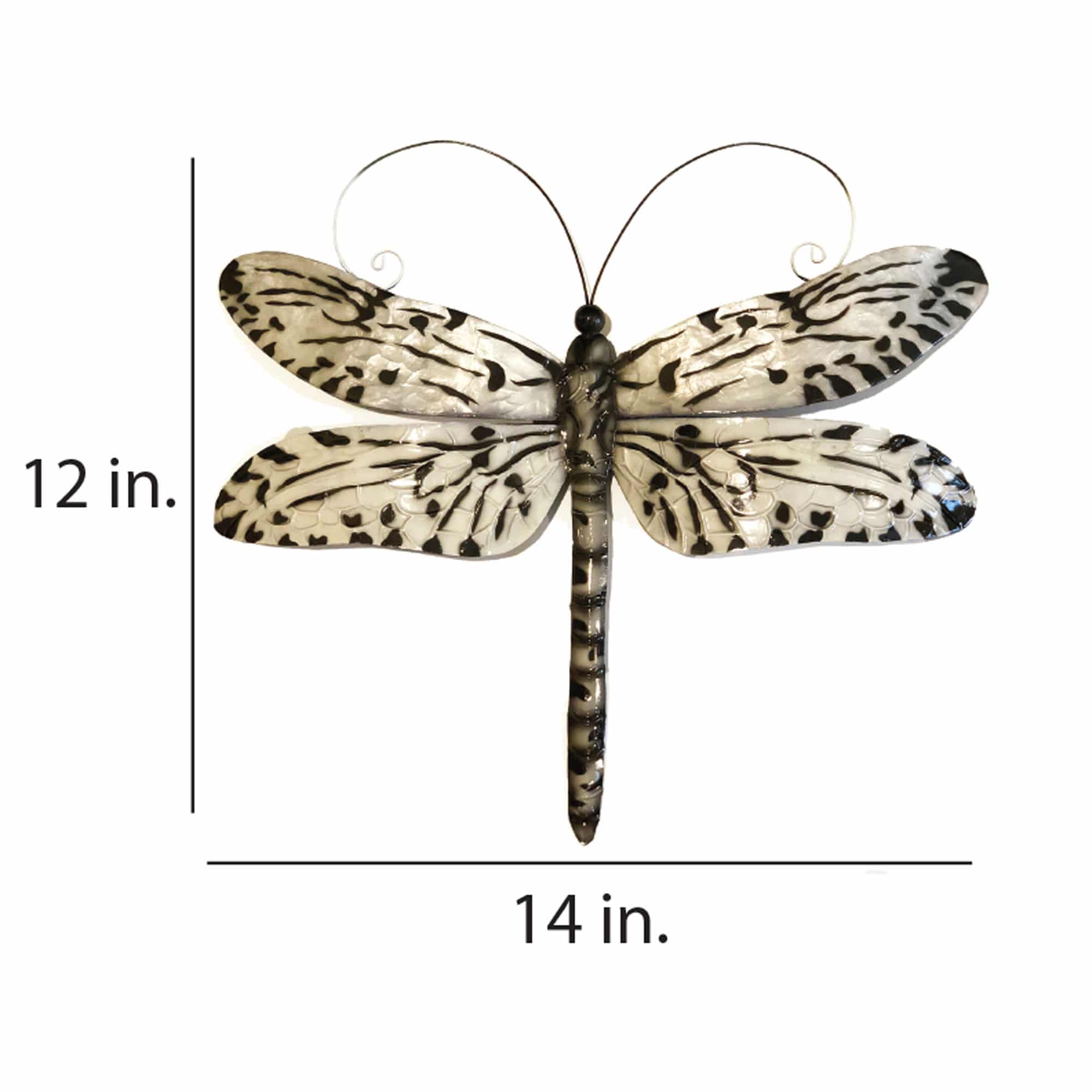
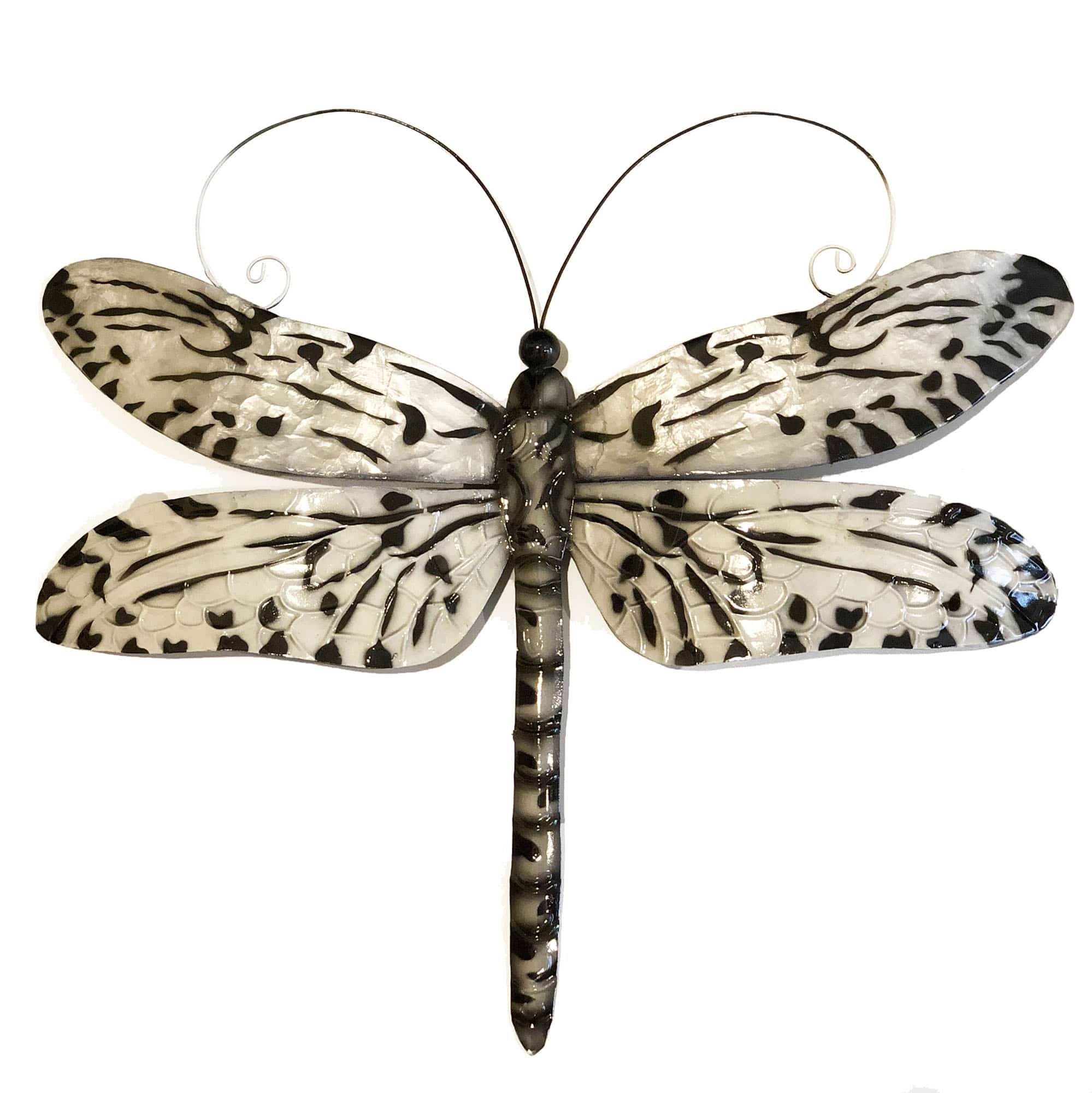
Angelic and graceful, this dragonfly is distinctive and regal. The wings of this piece are rather large and stately, particularly when this beauty flies on the breeze from flower to flower. The artist brings this to life by crafting the body smaller compared to the wings. The upper wings are adorned with capiz shell, giving it the translucent color seen in the natural dragonfly. The lower wings are constructed from tin and the colors help accentuate the vein structures. The combination of the two will add both color and structure to your wall and your room.
The basic frame of the dragonfly is created using tin, which is powder-coated with a black finish and makes this piece safe to use outdoors. The edges of the frame are reinforced using thicker tin wire. The front of this piece is adorned in areas with capiz shell, an oyster native to the Philippines, before being hand-painted and sealed with a water-based sealant. The primary purpose of this oyster to provide a source of food, however, the shell is a sustainable by-product that can be used for decoration. The capiz shell subtly replicates the reflective qualities of dragonflies in nature. The entire piece is lightweight and has an eyelet in the back allowing it to be hung using a finishing nail, command strip, or a push pin. Due to it being a natural material, the organic colors of capiz come through as tans and browns underneath the paint.
-

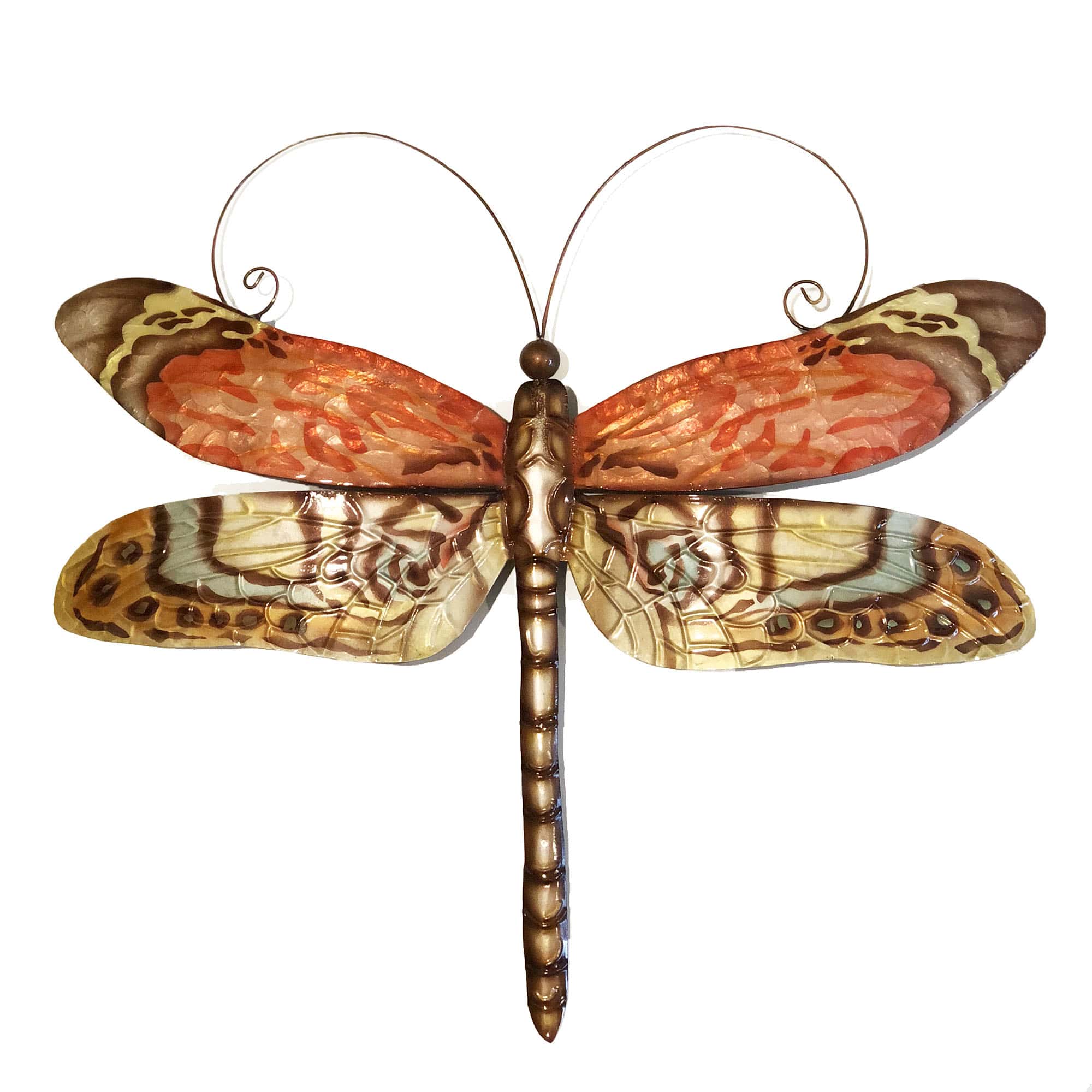
This festively colored dragonfly will brighten any room with its mix of colors hand-painted in intricate detailed patterns. A mix of metal and capiz shell will highlight texture and the capiz will give it a translucent feel as it reflects and bounces the colors.
The basic frame of the dragonfly is created using tin, which is powder-coated with a black finish and makes this piece safe to use outdoors. The edges of the frame are reinforced using thicker tin wire. The front of this piece is adorned in areas with capiz shell, an oyster native to the Philippines, before being hand-painted and sealed with a water-based sealant. The primary purpose of this oyster to provide a source of food, however, the shell is a sustainable by-product that can be used for decoration. The capiz shell subtly replicates the reflective qualities of dragonflies in nature. The entire piece is lightweight and has an eyelet in the back allowing it to be hung using a finishing nail, command strip, or a push pin. Due to it being a natural material, the organic colors of capiz come through as tans and browns underneath the paint.
-


Purple is considered a color of royalty and wealth due to the rarity of the dye that originally produced it. Even though that no longer is the case, it still is considered a bold and rich color. The color is even more vibrant due to the strips of color created by the brush strokes against the capiz shell. The artist complemented the predominantly purple colored dragonfly with oranges and reds at the base and a couple of white spots on each wing. If your color is primarily purple or if it is just used as an accent, this dragonfly will complement any decor in your room.
The basic frame of the dragonfly is created using tin, which is powder-coated with a black finish and makes this piece safe to use outdoors. The edges of the frame are reinforced using thicker tin wire. The front of this piece is adorned in areas with capiz shell, an oyster native to the Philippines, before being hand-painted and sealed with a water-based sealant. The primary purpose of this oyster to provide a source of food, however, the shell is a sustainable by-product that can be used for decoration. The capiz shell subtly replicates the reflective qualities of dragonflies in nature. The entire piece is lightweight and has an eyelet in the back allowing it to be hung using a finishing nail, command strip, or a push pin. Due to it being a natural material, the organic colors of capiz come through as tans and browns underneath the paint.
-
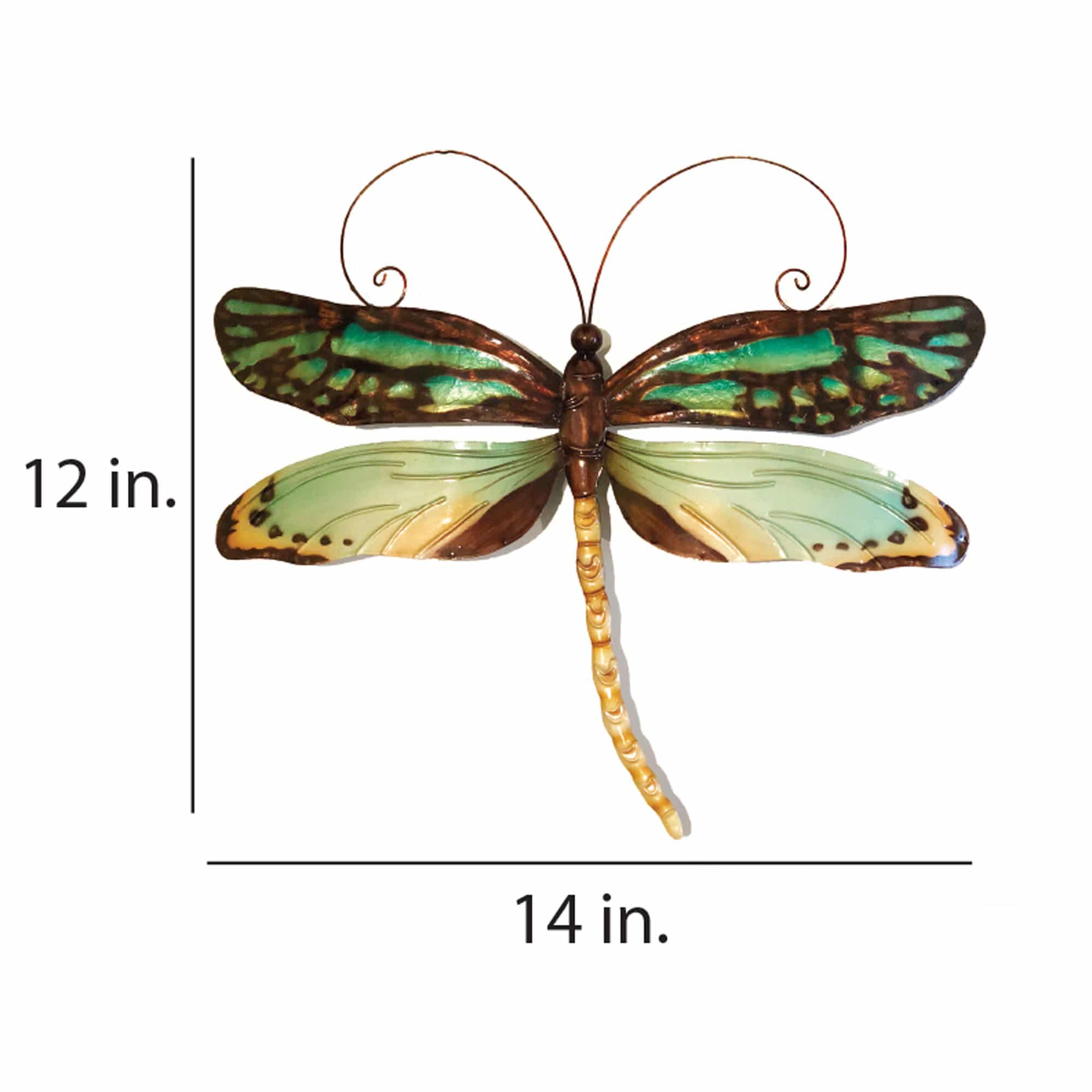
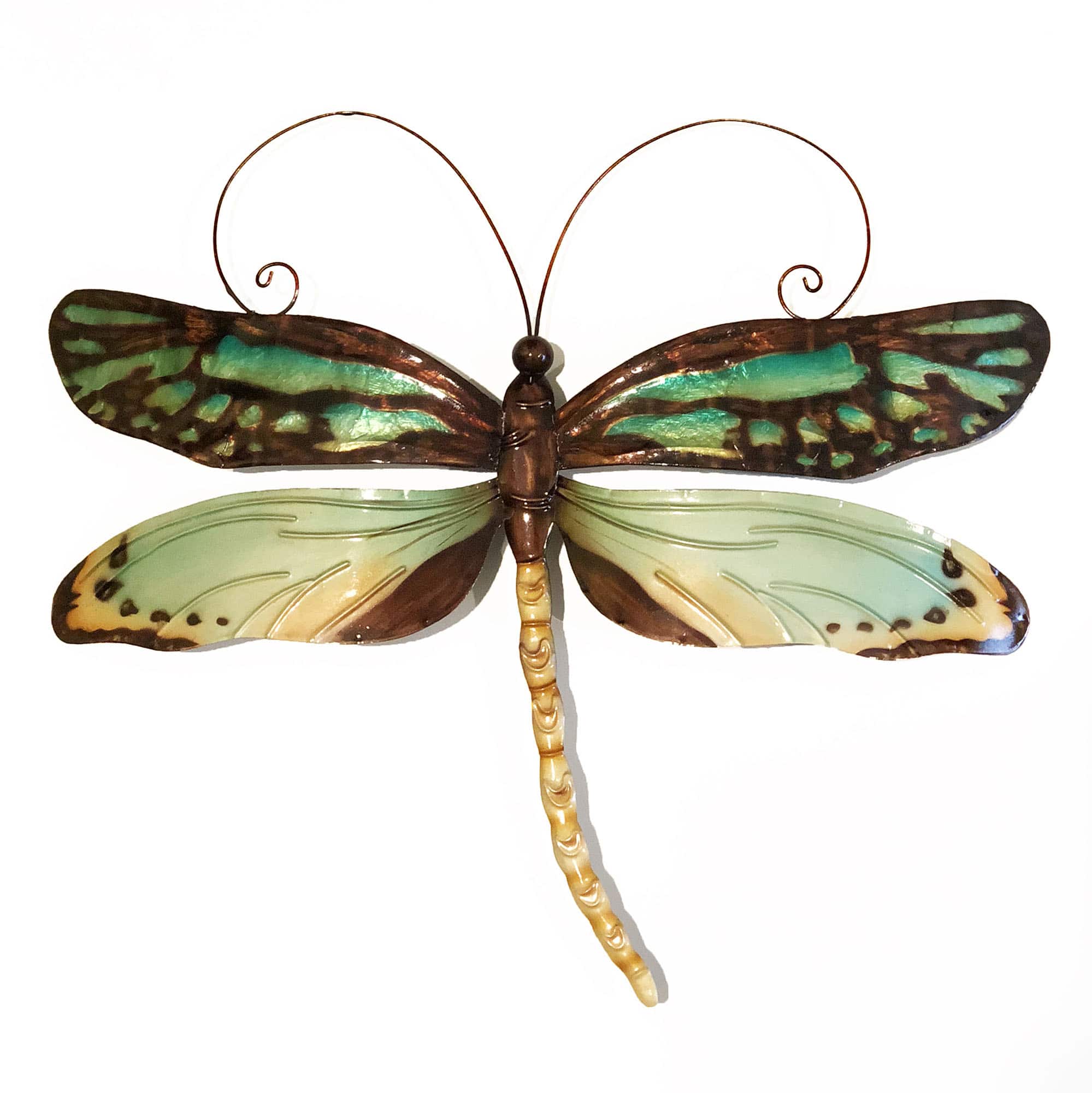
The aqua color of this dragonfly and the capiz shell complement each other in such a way that it almost looks like one is looking at cobalt glass. This color is accentuated by the copper tone bordering the aqua centers. This is truly an impressive piece combining natural materials and colors and creating something breathtaking. The upper wing adorned in capiz is contrasted by the handcrafted metal lower wing. Both components meld together for a piece that showcases the artists talents.
The basic frame of the dragonfly is created using tin, which is powder-coated with a black finish and makes this piece safe to use outdoors. The edges of the frame are reinforced using thicker tin wire. The front of this piece is adorned in areas with capiz shell, an oyster native to the Philippines, before being hand-painted and sealed with a water-based sealant. The primary purpose of this oyster to provide a source of food, however, the shell is a sustainable by-product that can be used for decoration. The capiz shell subtly replicates the reflective qualities of dragonflies in nature. The entire piece is lightweight and has an eyelet in the back allowing it to be hung using a finishing nail, command strip, or a push pin. Due to it being a natural material, the organic colors of capiz come through as tans and browns underneath the paint.
-
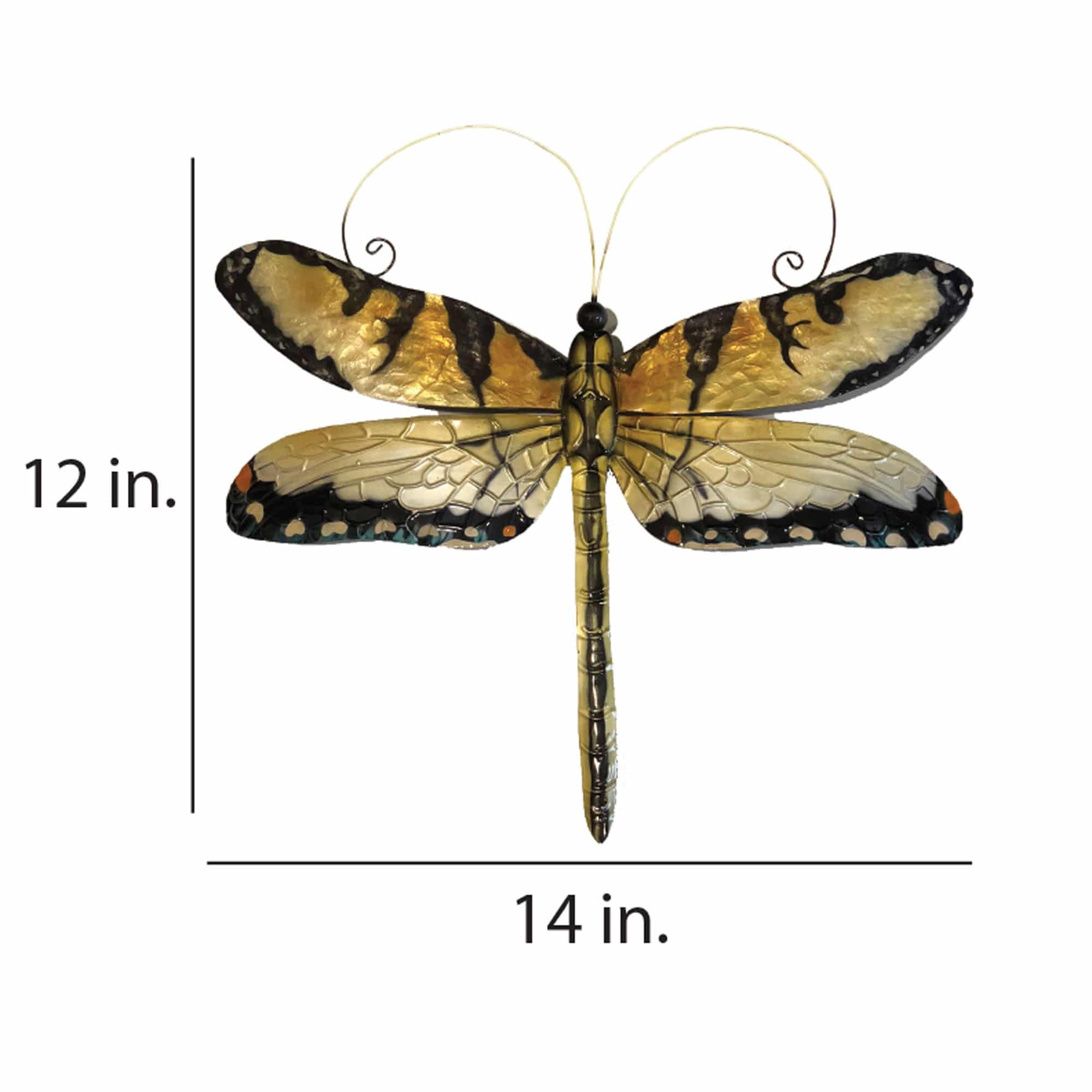
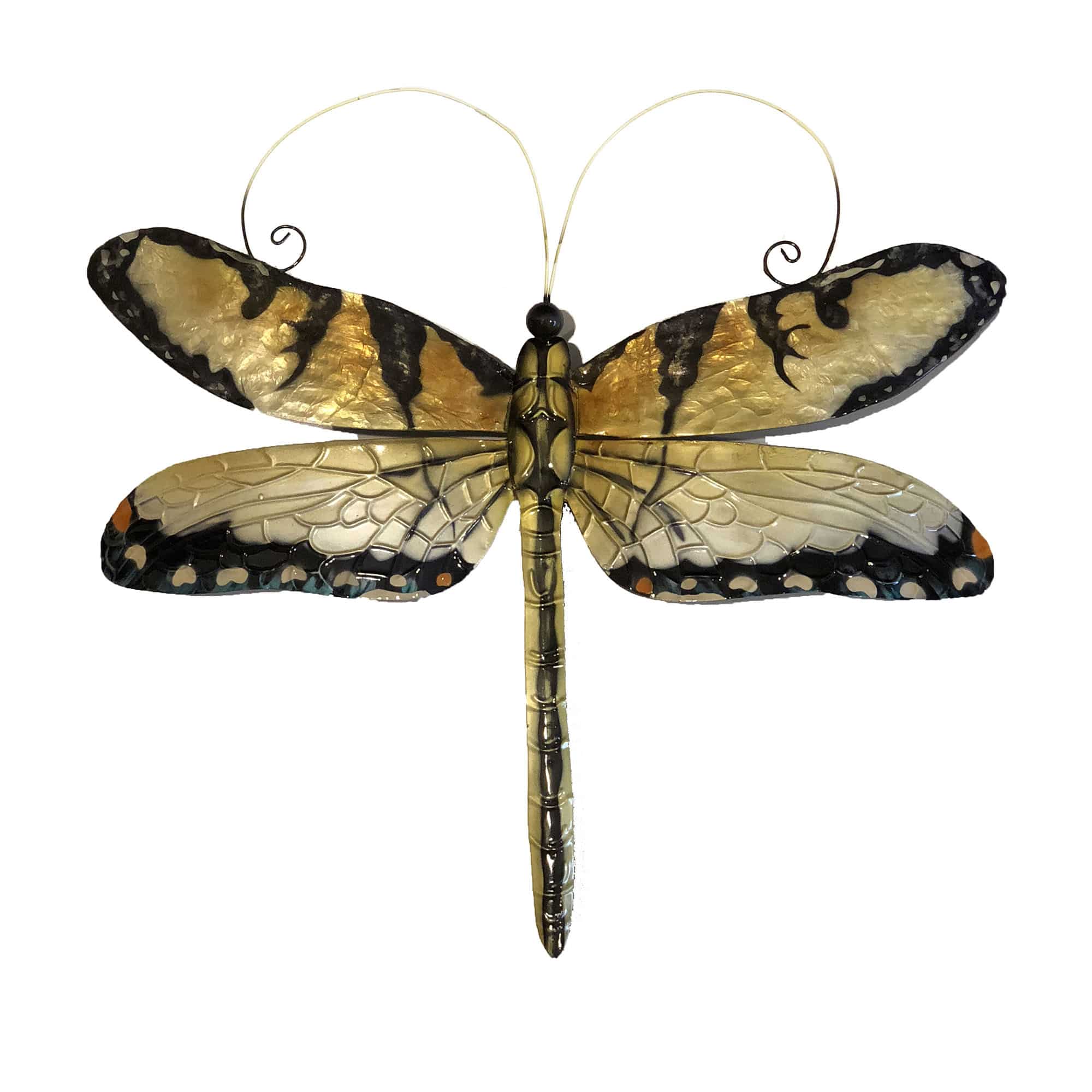
With so much detail in this piece it nearly feels like it's about to spring to life and take flight. Vibrant yellows bounce off of blacks and are highlighted with blue. Bringing this recreation of nature into your home will add design and color to your space.
The basic frame of the dragonfly is created using tin, which is powder-coated with a black finish and makes this piece safe to use outdoors. The edges of the frame are reinforced using thicker tin wire. The front of this piece is adorned in areas with capiz shell, an oyster native to the Philippines, before being hand-painted and sealed with a water-based sealant. The primary purpose of this oyster to provide a source of food, however, the shell is a sustainable by-product that can be used for decoration. The capiz shell subtly replicates the reflective qualities of dragonflies in nature. The entire piece is lightweight and has an eyelet in the back allowing it to be hung using a finishing nail, command strip, or a push pin. Due to it being a natural material, the organic colors of capiz come through as tans and browns underneath the paint.
-


This dragonfly pays homage to the Indian peacock and its iridescent blue and green metallic plumage. Each wing has the distinctive eyespot for which this peacock is known. Bold and impossible to miss, the dramatic peacock design on this dragonfly glistens. The vibrant golds, blues and greens contrast in style. This dragonfly will add a strong punch of color to any room.
The basic frame of the dragonfly is created using tin, which is powder-coated with a black finish and makes this piece safe to use outdoors. The edges of the frame are reinforced using thicker tin wire. The front of this piece is adorned in areas with capiz shell, an oyster native to the Philippines, before being hand-painted and sealed with a water-based sealant. The primary purpose of this oyster to provide a source of food, however, the shell is a sustainable by-product that can be used for decoration. The capiz shell subtly replicates the reflective qualities of dragonflies in nature. The entire piece is lightweight and has an eyelet in the back allowing it to be hung using a finishing nail, command strip, or a push pin. Due to it being a natural material, the organic colors of capiz come through as tans and browns underneath the paint.
-
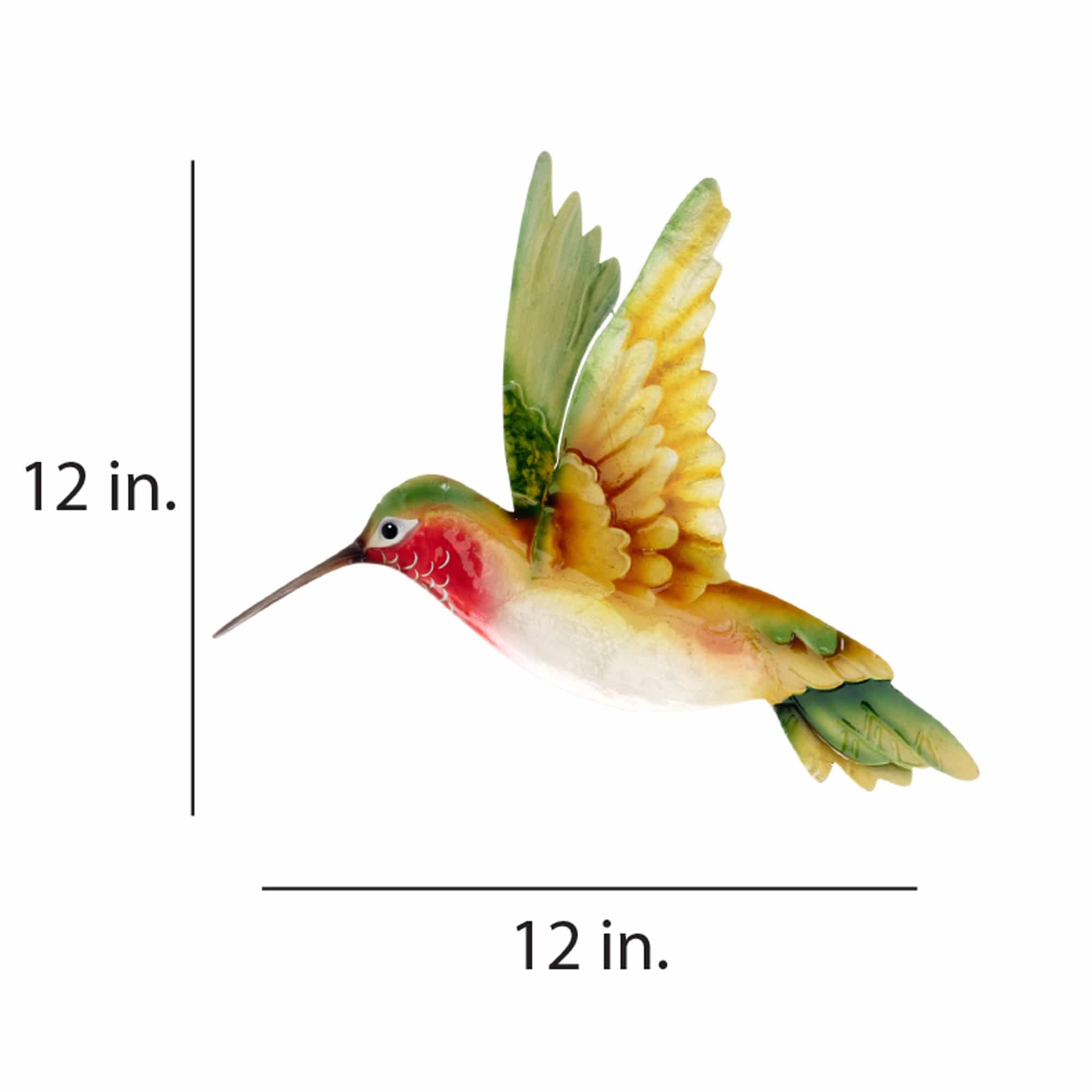
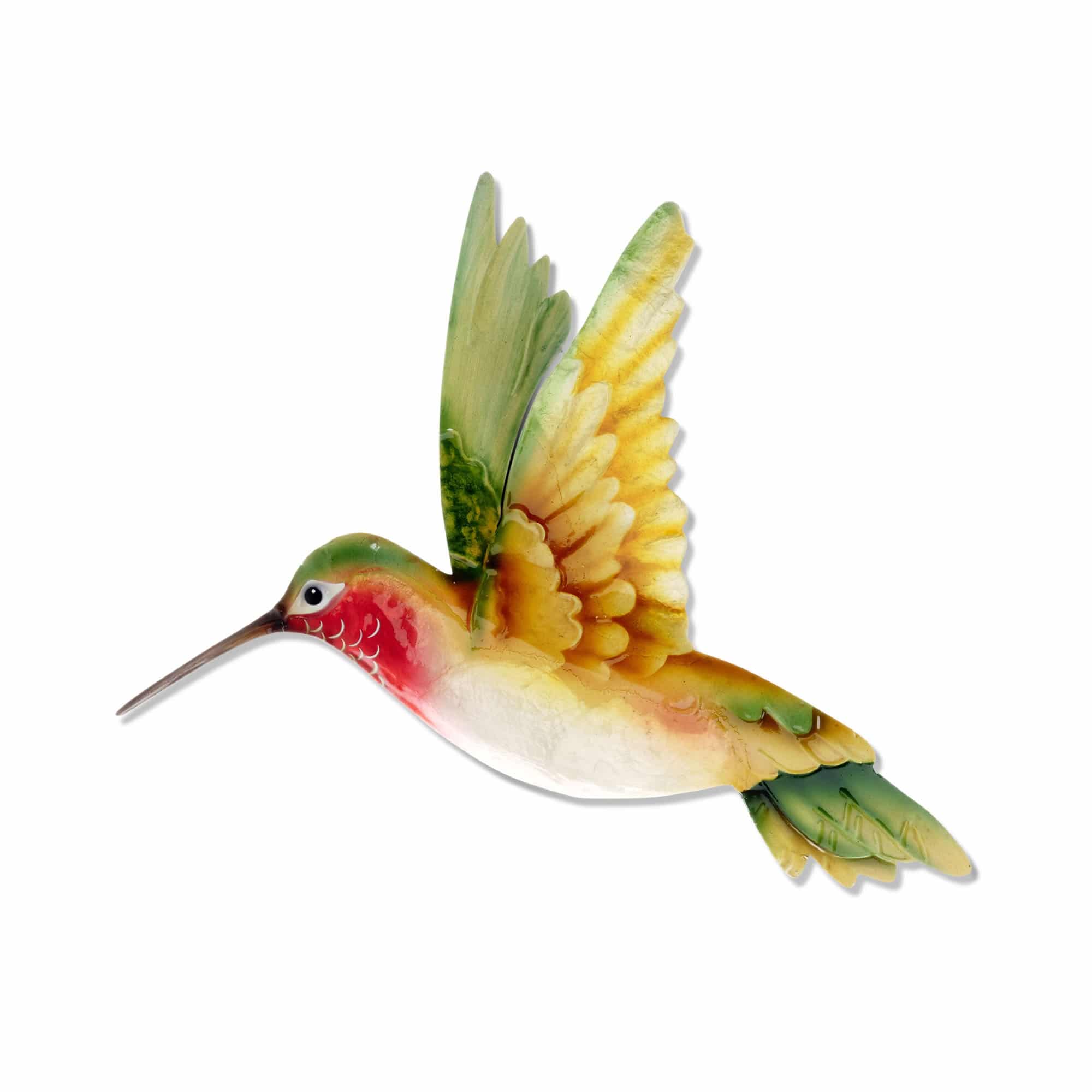
This hummingbird is inspired by the Ruby-throated hummingbird, commonly seen in Eastern North America in the summer. Small yet agile, this hummingbird flies all the way to the southern parts of Central America for the winter. The artist captures the hummingbird in mid-flight. Its chest is adorned with capiz shell, which is then hand-painted to the magnificent colors seen in this species. Bring the spirt of summer into your home by adding this piece of art to your wall.
The basic frame of the hummingbird is created using tin, which is powder coated with a black finish. The frame is reinforced using tin wire along the inner edge. Capiz is an oyster shell and the primary purpose of the oyster is as a source of food. However, the by-product, the shell, can be used for decoration. Due to it being a natural material, the natural colors of the capiz come through as tans and browns underneath the paint. The shell is then painted the bold colors you see. The entire front facing piece is carefully hand-painted keeping in mind the reflective qualities in the color of hummingbirds.
-

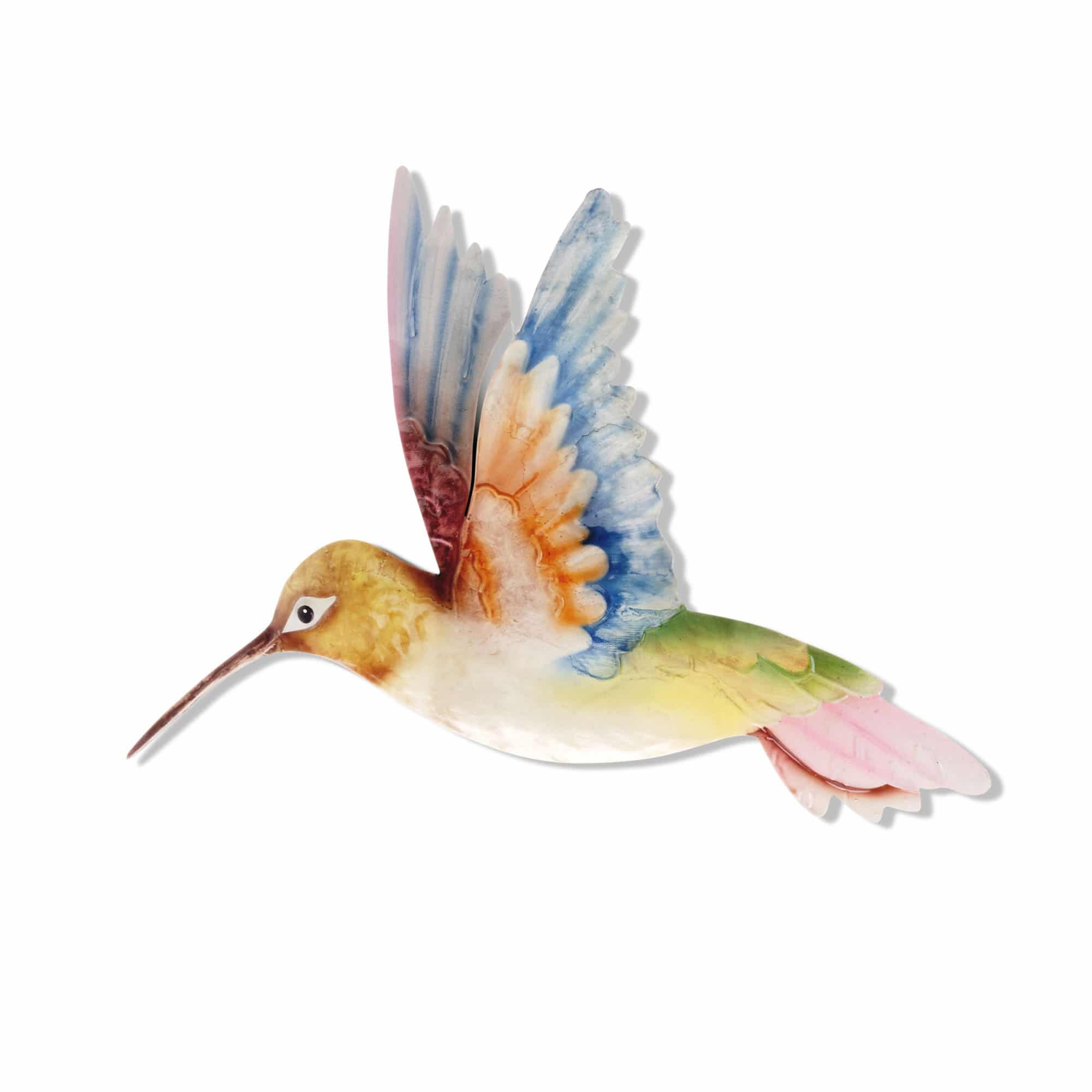
This hummingbird is inspired by many different species. The artist captures the colors and grace of a hummingbird in mid-flight. Its chest is adorned with capiz shell, which is then hand-painted to the magnificent colors seen in many species. This hummingbird brings a sense of purpose as it flies from flower to flower.
The basic frame of the hummingbird is created using tin, which is powder coated with a black finish. The frame is reinforced using tin wire along the inner edge. Capiz is an oyster shell and the primary purpose of the oyster is as a source of food. However, the by-product, the shell, can be used for decoration. Due to it being a natural material, the natural colors of the capiz come through as tans and browns underneath the paint. The shell is then painted the bold colors you see. The entire front facing piece is carefully hand-painted keeping in mind the reflective qualities in the color of hummingbirds.
-
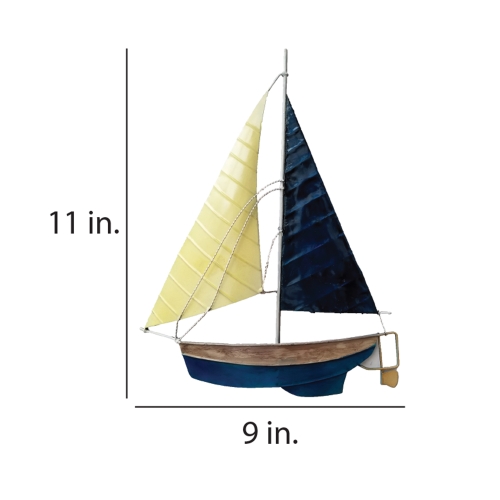
 The sailboat is a common and familiar scene at most beaches. The Yellow Blue and Gray Sailboat Wall Decor brings home the well-known features of this iconic boat. The spinnaker is fully inflated and pops away from the wall with the rope tangling on the side. The headsail, usually the more colorful, is adorned with capiz shell which gives it a shine as it reflects the sunlight. The artist enhances the authenticity of the hull by painting it with a distressed finish, showing a well loved and traveled vessel. The basic frame of the wall sailboat is created using wrought iron, which is powder coated in a black finish. The frame is reinforced using wrought iron wire inner edge or outer edge. Capiz is an oyster shell and the primary purpose of the oyster is as a source of food. However, the by-product, the shell, can be used for decoration. Due to it being a natural material, the natural colors of the capiz can come through as tans and browns underneath the paint. The final step is to hand-paint the sailboat, giving this piece a rustic finish and feel.
The sailboat is a common and familiar scene at most beaches. The Yellow Blue and Gray Sailboat Wall Decor brings home the well-known features of this iconic boat. The spinnaker is fully inflated and pops away from the wall with the rope tangling on the side. The headsail, usually the more colorful, is adorned with capiz shell which gives it a shine as it reflects the sunlight. The artist enhances the authenticity of the hull by painting it with a distressed finish, showing a well loved and traveled vessel. The basic frame of the wall sailboat is created using wrought iron, which is powder coated in a black finish. The frame is reinforced using wrought iron wire inner edge or outer edge. Capiz is an oyster shell and the primary purpose of the oyster is as a source of food. However, the by-product, the shell, can be used for decoration. Due to it being a natural material, the natural colors of the capiz can come through as tans and browns underneath the paint. The final step is to hand-paint the sailboat, giving this piece a rustic finish and feel. -
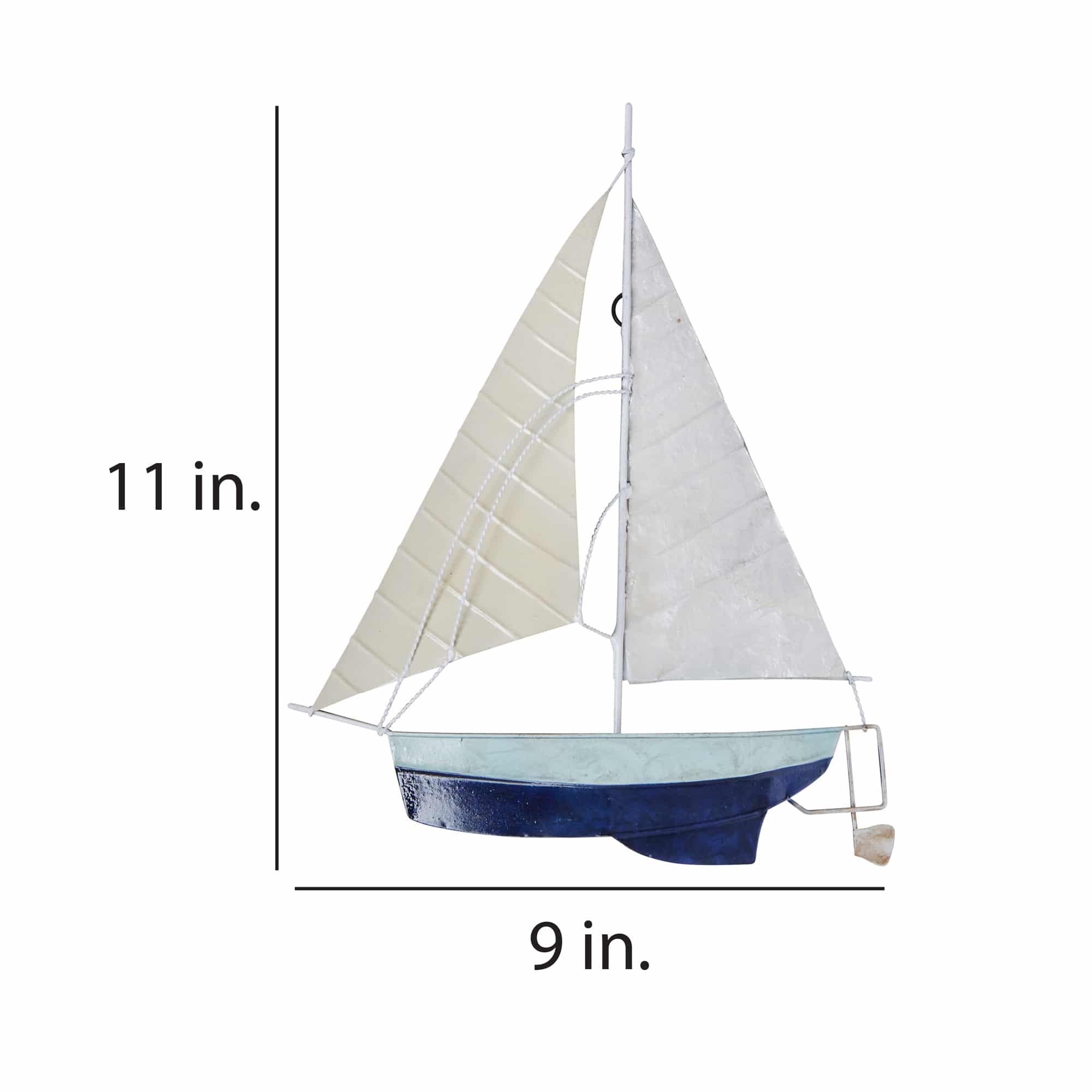
 The sailboat is a common and familiar scene at most beaches. Cream Gold and Blue Sailboat Wall Decor brings home the well-known features of this iconic boat. The spinnaker is fully inflated and pops away from the wall with the rope tangling on the side. The headsail, usually the more colorful, is adorned with capiz shell which gives it a shine as it reflects the sunlight. The artist enhances the authenticity of the hull by painting it with a distressed finish, showing a well loved and traveled vessel. The basic frame of the wall sailboat is created using wrought iron, which is powder coated in a black finish. The frame is reinforced using wrought iron wire inner edge or outer edge. Capiz is an oyster shell and the primary purpose of the oyster is as a source of food. However, the by-product, the shell, can be used for decoration. Due to it being a natural material, the natural colors of the capiz can come through as tans and browns underneath the paint. The final step is to hand-paint the sailboat, giving this piece a rustic finish and feel.
The sailboat is a common and familiar scene at most beaches. Cream Gold and Blue Sailboat Wall Decor brings home the well-known features of this iconic boat. The spinnaker is fully inflated and pops away from the wall with the rope tangling on the side. The headsail, usually the more colorful, is adorned with capiz shell which gives it a shine as it reflects the sunlight. The artist enhances the authenticity of the hull by painting it with a distressed finish, showing a well loved and traveled vessel. The basic frame of the wall sailboat is created using wrought iron, which is powder coated in a black finish. The frame is reinforced using wrought iron wire inner edge or outer edge. Capiz is an oyster shell and the primary purpose of the oyster is as a source of food. However, the by-product, the shell, can be used for decoration. Due to it being a natural material, the natural colors of the capiz can come through as tans and browns underneath the paint. The final step is to hand-paint the sailboat, giving this piece a rustic finish and feel. -
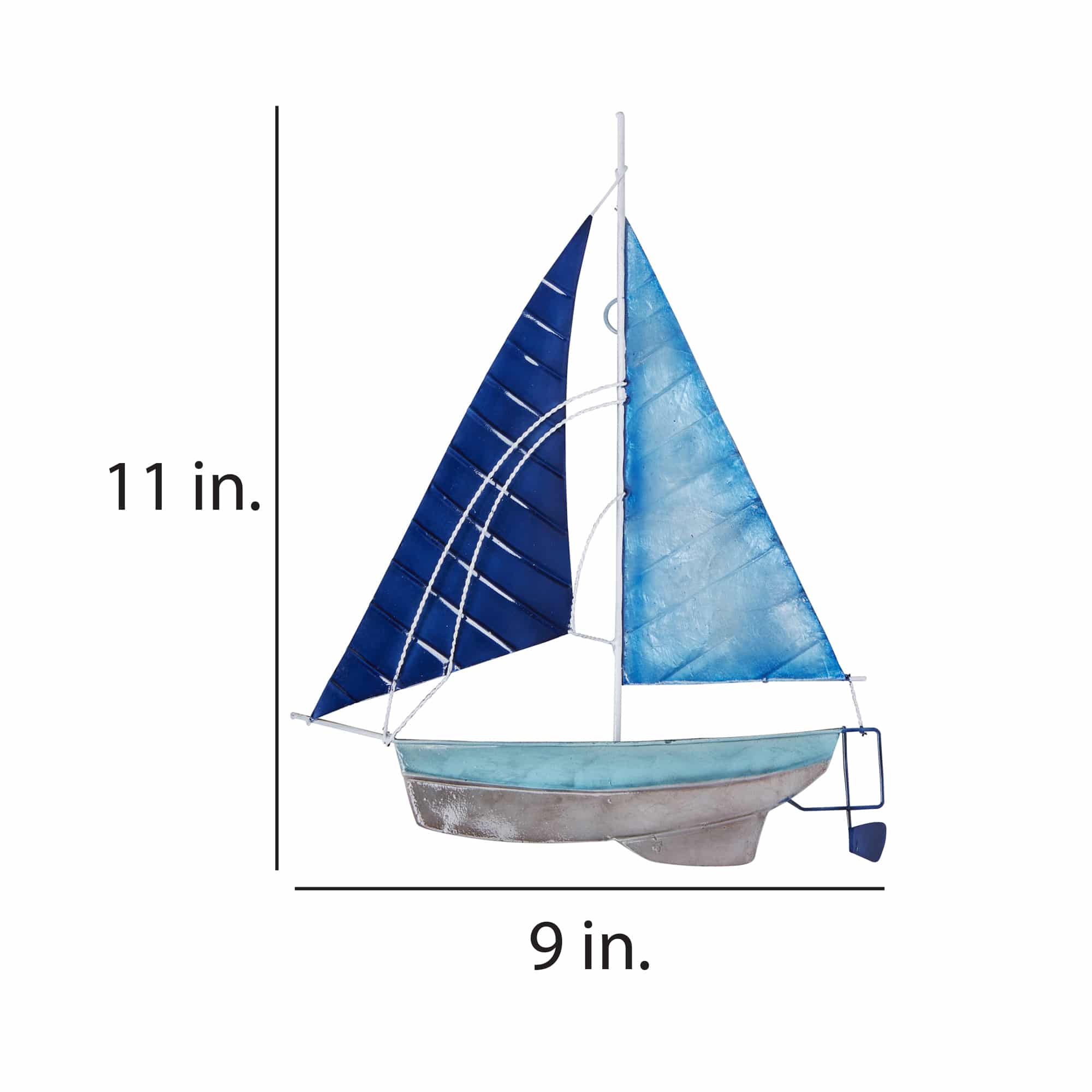
 The sailboat is a common and familiar scene at most beaches. A small fleet of boats is grouped together in this larger, handcrafted piece of wall d�cor. The spinnakers are fully inflated and pop away from the wall. The headsails are adorned with natural capiz shell, giving them a shine as they reflect the sunlight. The artist enhances the authenticity of the hulls by painting the raised, metal waves with a distressed finish, showing well-loved and traveled vessels. The basic frame of the wall sailboat is created using wrought iron, which is powder coated in a black finish. The frame is reinforced using wrought iron wire inner edge or outer edge. Capiz is an oyster shell and the primary purpose of the oyster is as a source of food. However, the by-product, the shell, can be used for decoration. Due to it being a natural material, the natural colors of the capiz can come through as tans and browns underneath the paint. The final step is to hand-paint the sailboat, giving this piece a rustic finish and feel.
The sailboat is a common and familiar scene at most beaches. A small fleet of boats is grouped together in this larger, handcrafted piece of wall d�cor. The spinnakers are fully inflated and pop away from the wall. The headsails are adorned with natural capiz shell, giving them a shine as they reflect the sunlight. The artist enhances the authenticity of the hulls by painting the raised, metal waves with a distressed finish, showing well-loved and traveled vessels. The basic frame of the wall sailboat is created using wrought iron, which is powder coated in a black finish. The frame is reinforced using wrought iron wire inner edge or outer edge. Capiz is an oyster shell and the primary purpose of the oyster is as a source of food. However, the by-product, the shell, can be used for decoration. Due to it being a natural material, the natural colors of the capiz can come through as tans and browns underneath the paint. The final step is to hand-paint the sailboat, giving this piece a rustic finish and feel. -
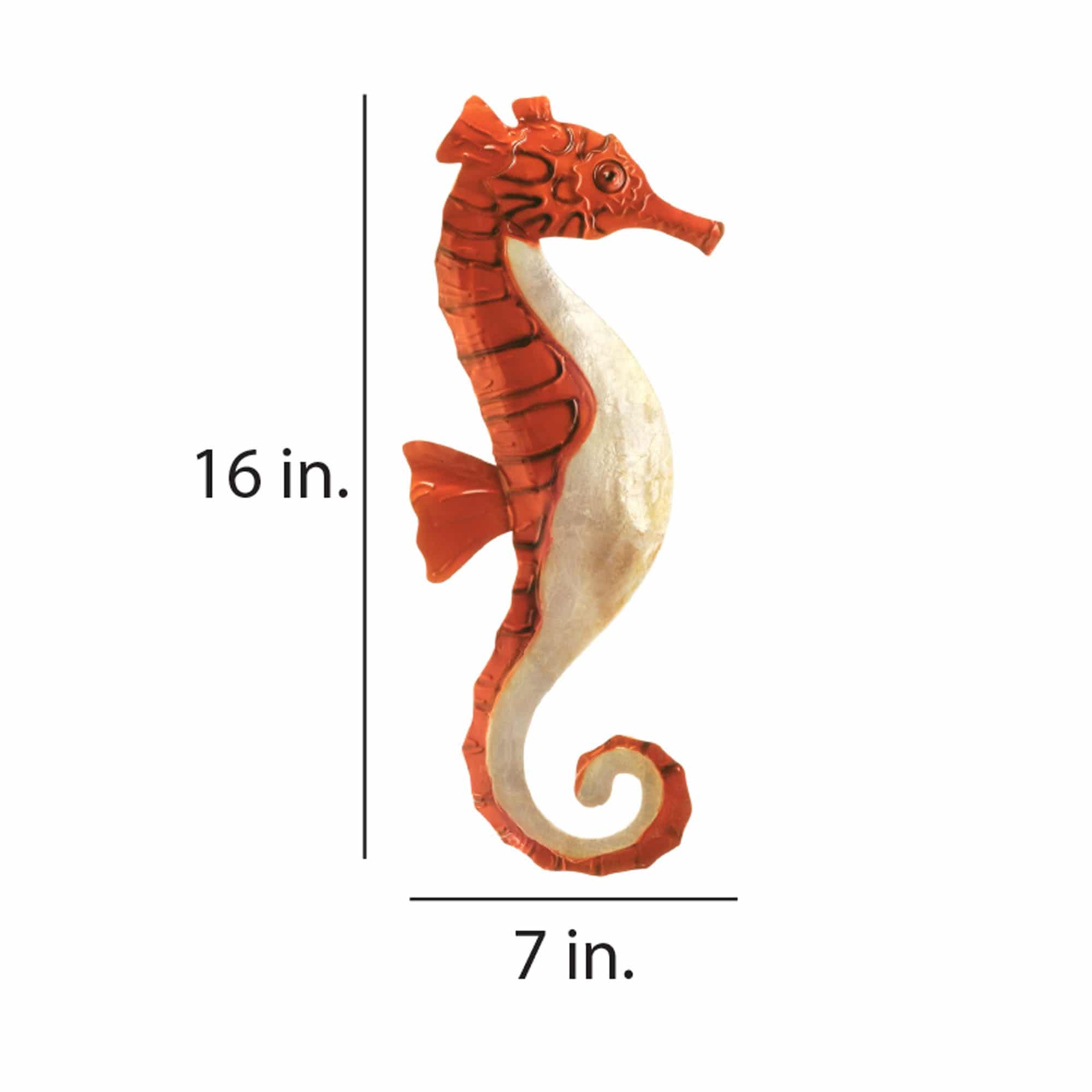
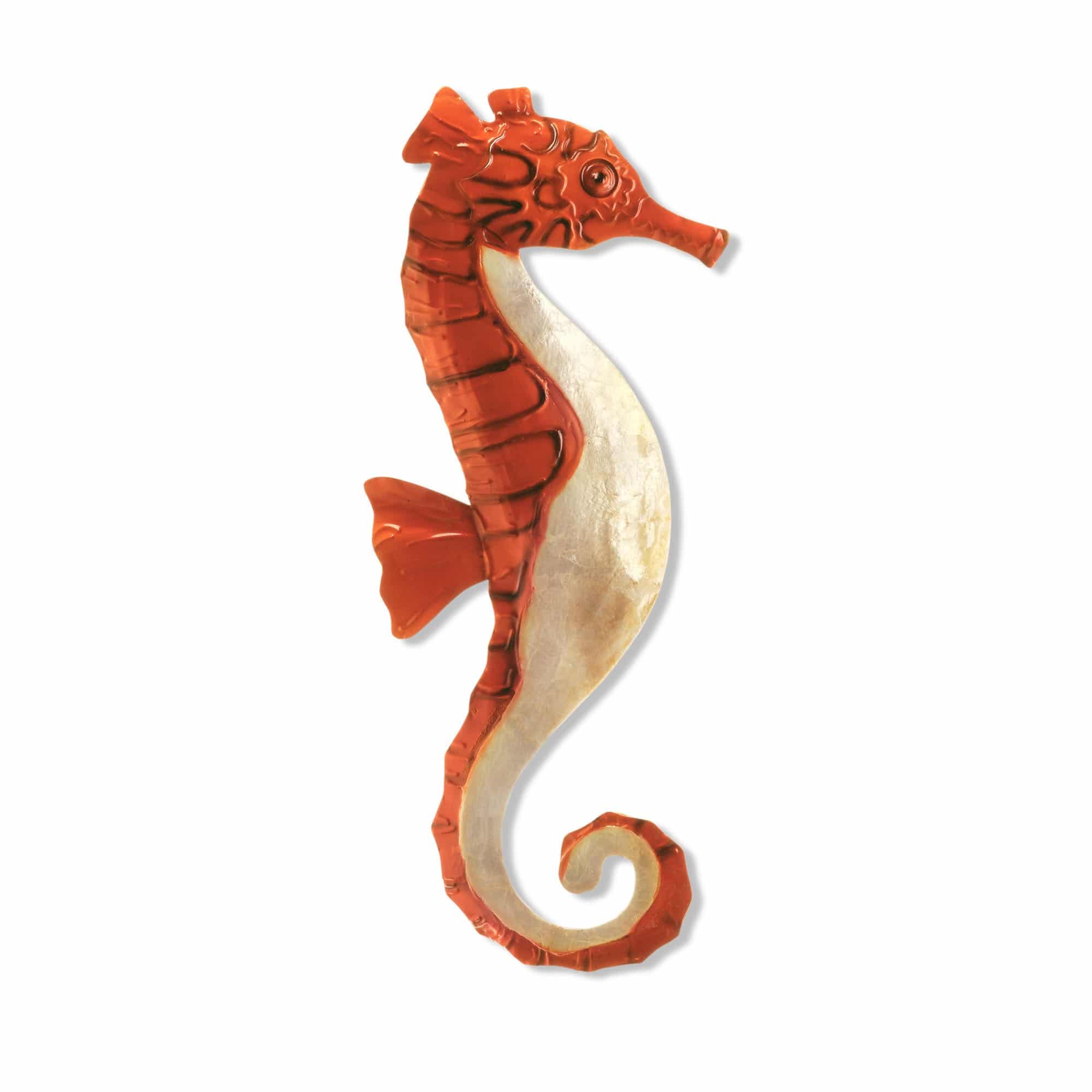 The seahorse has captured the minds and imaginations of people across all cultures for thousands of years. Seen as a symbol of good luck, strength and safety, this unique and beautiful animal is as charming as it is mysterious. The artist captures the beauty of the seahorse with a raised fine, high shine, hand-painted finish, and elegant mother of pearl chest and forefront. The basic frame of the wall seahorse is created using tin, which is powder coated as a black finish. Capiz is an oyster shell and the primary purpose of the oyster is as a source of food. However, the by-product, the shell, can be used for decoration. Due to it being a natural material, the natural colors of the capiz can come through as tans and browns.
The seahorse has captured the minds and imaginations of people across all cultures for thousands of years. Seen as a symbol of good luck, strength and safety, this unique and beautiful animal is as charming as it is mysterious. The artist captures the beauty of the seahorse with a raised fine, high shine, hand-painted finish, and elegant mother of pearl chest and forefront. The basic frame of the wall seahorse is created using tin, which is powder coated as a black finish. Capiz is an oyster shell and the primary purpose of the oyster is as a source of food. However, the by-product, the shell, can be used for decoration. Due to it being a natural material, the natural colors of the capiz can come through as tans and browns. -
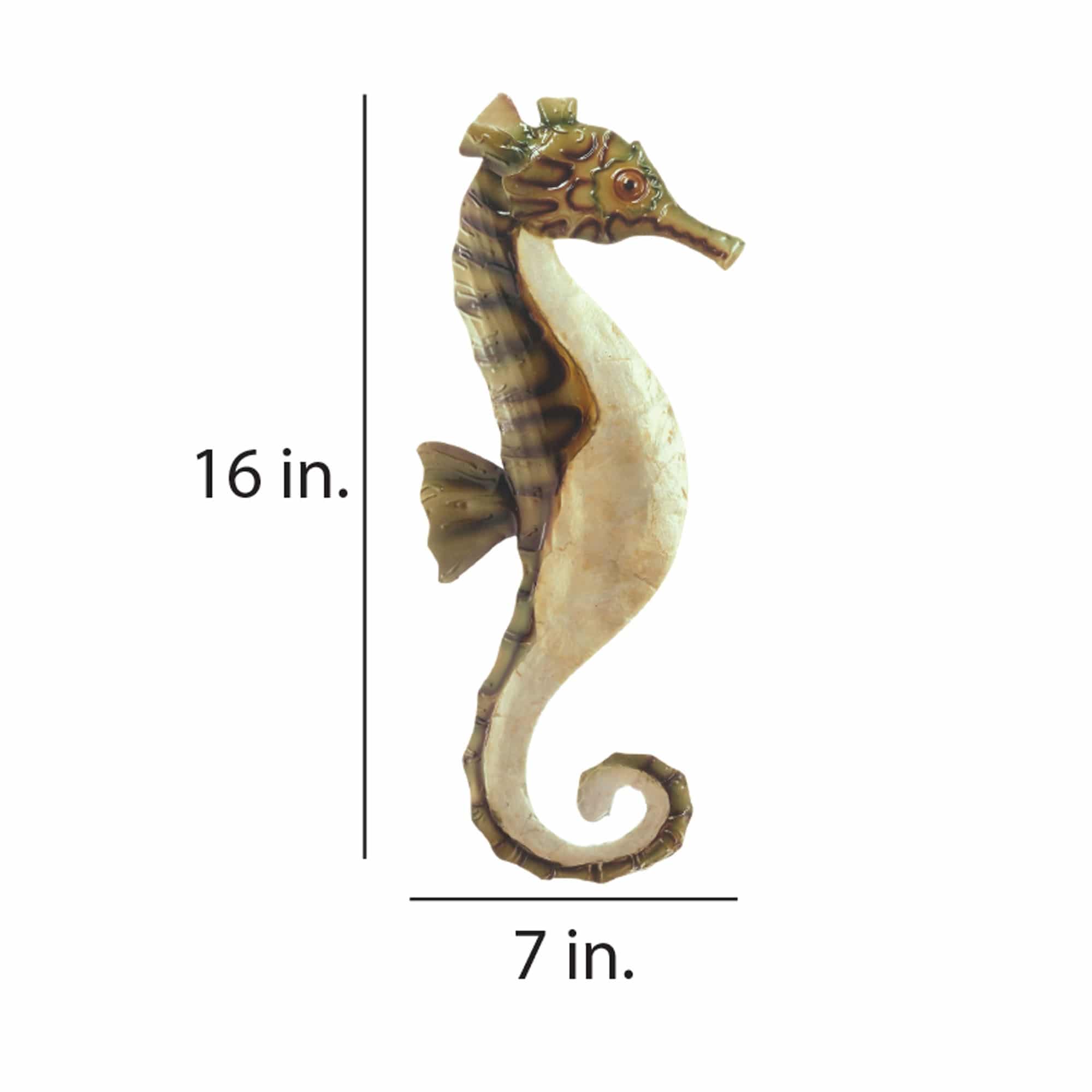
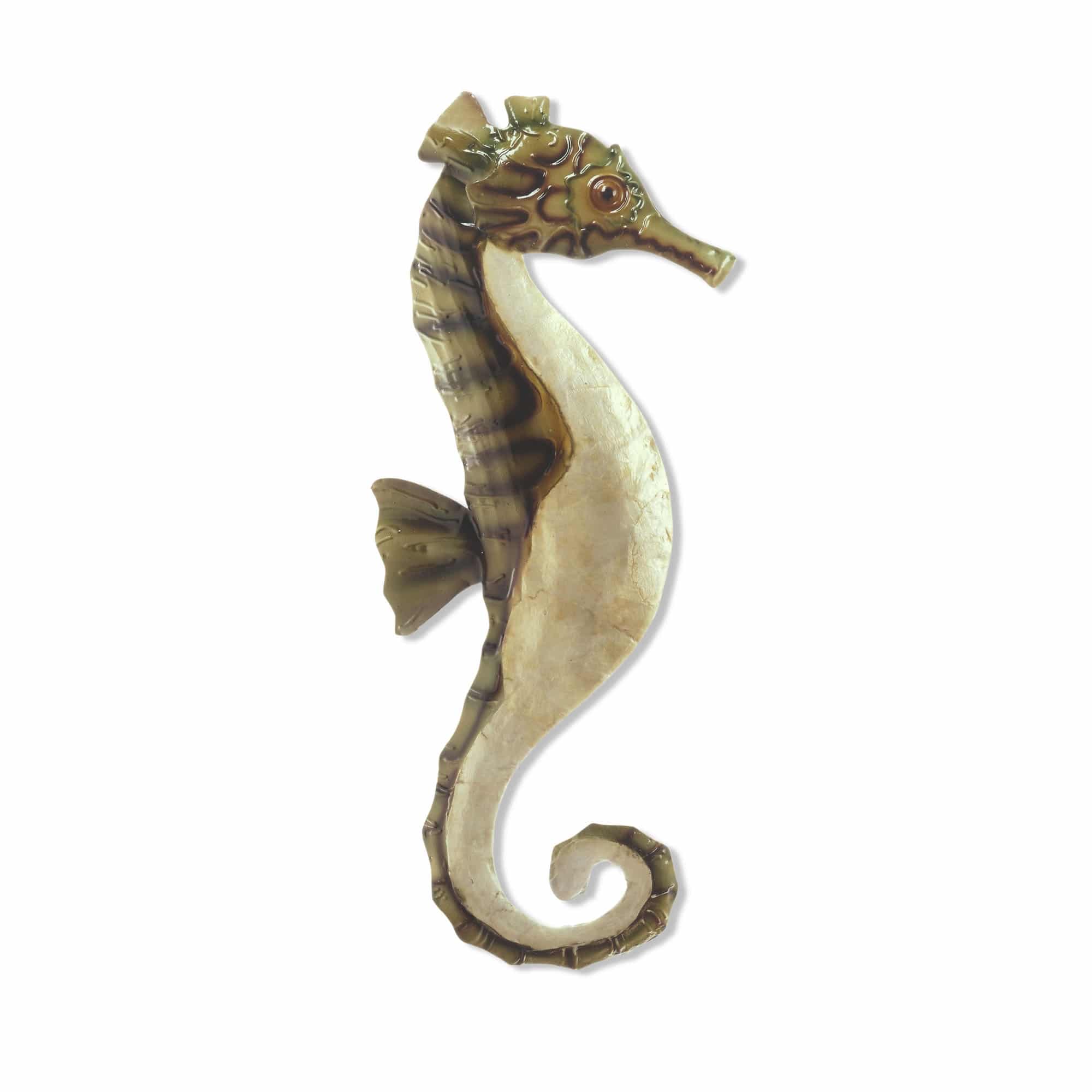 The seahorse has captured the minds and imaginations of people across all cultures for thousands of years. Seen as a symbol of good luck, strength and safety, this unique and beautiful animal is as charming as it is mysterious. The artist captures the beauty of the seahorse with a raised fine, high shine, hand-painted finish, and elegant mother of pearl chest and forefront. The basic frame of the wall seahorse is created using tin, which is powder coated as a black finish. Capiz is an oyster shell and the primary purpose of the oyster is as a source of food. However, the by-product, the shell, can be used for decoration. Due to it being a natural material, the natural colors of the capiz can come through as tans and browns.
The seahorse has captured the minds and imaginations of people across all cultures for thousands of years. Seen as a symbol of good luck, strength and safety, this unique and beautiful animal is as charming as it is mysterious. The artist captures the beauty of the seahorse with a raised fine, high shine, hand-painted finish, and elegant mother of pearl chest and forefront. The basic frame of the wall seahorse is created using tin, which is powder coated as a black finish. Capiz is an oyster shell and the primary purpose of the oyster is as a source of food. However, the by-product, the shell, can be used for decoration. Due to it being a natural material, the natural colors of the capiz can come through as tans and browns. -
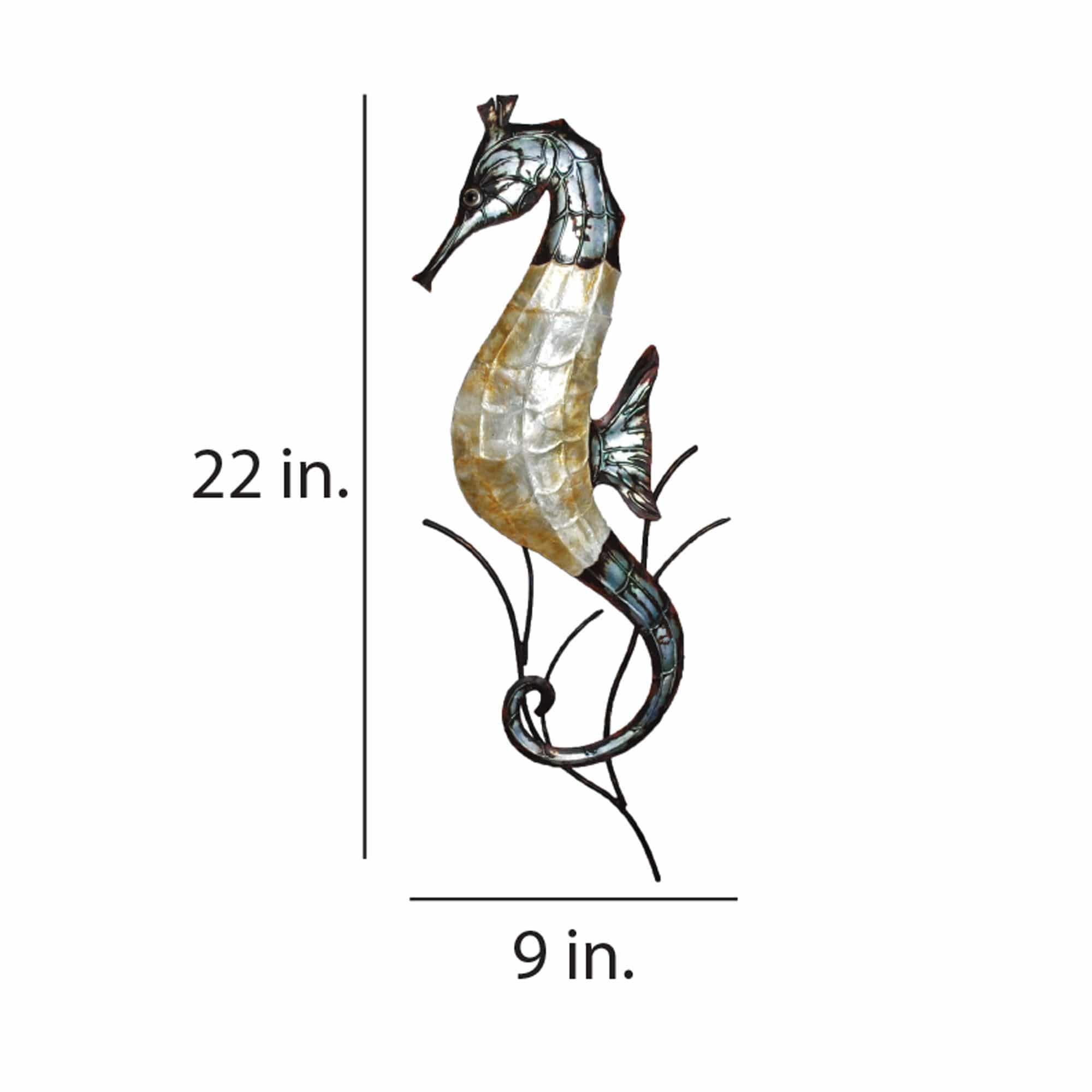
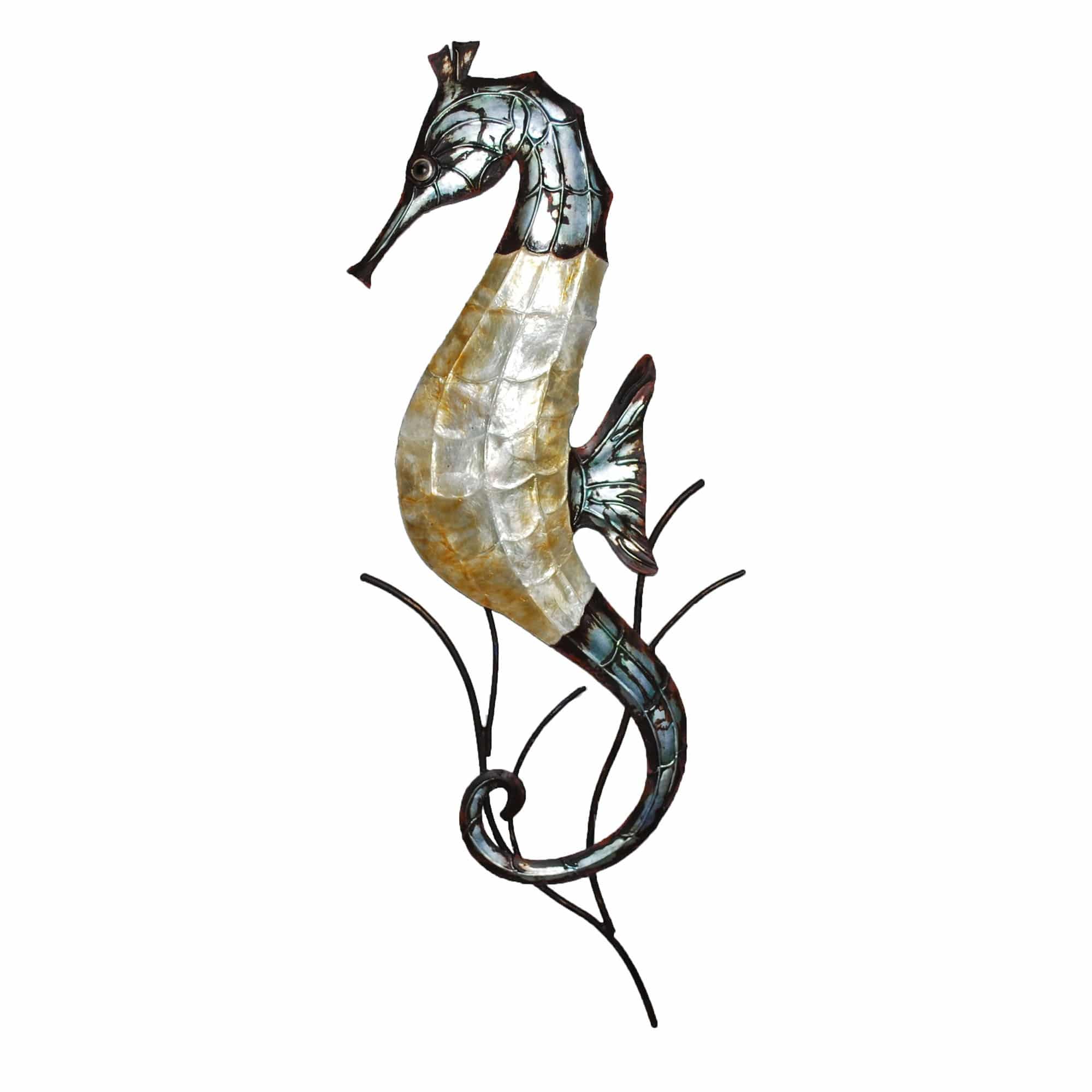 The seahorse has captured the minds and imaginations of people across all cultures for thousands of years. Seen as a symbol of good luck, strength and safety, this unique and beautiful animal is as charming as it is mysterious. The artist captures the beauty of the seahorse with a raised fine, high shine, hand-painted finish, and elegant mother of pearl chest and forefront. The basic frame of the Seahorse Wall Decoris created using tin, which is powder coated as a black finish. Capiz is an oyster shell and the primary purpose of the oyster is as a source of food. However, the by-product, the shell, can be used for decoration. Due to it being a natural material, the natural colors of the capiz can come through as tans and browns.
The seahorse has captured the minds and imaginations of people across all cultures for thousands of years. Seen as a symbol of good luck, strength and safety, this unique and beautiful animal is as charming as it is mysterious. The artist captures the beauty of the seahorse with a raised fine, high shine, hand-painted finish, and elegant mother of pearl chest and forefront. The basic frame of the Seahorse Wall Decoris created using tin, which is powder coated as a black finish. Capiz is an oyster shell and the primary purpose of the oyster is as a source of food. However, the by-product, the shell, can be used for decoration. Due to it being a natural material, the natural colors of the capiz can come through as tans and browns. -
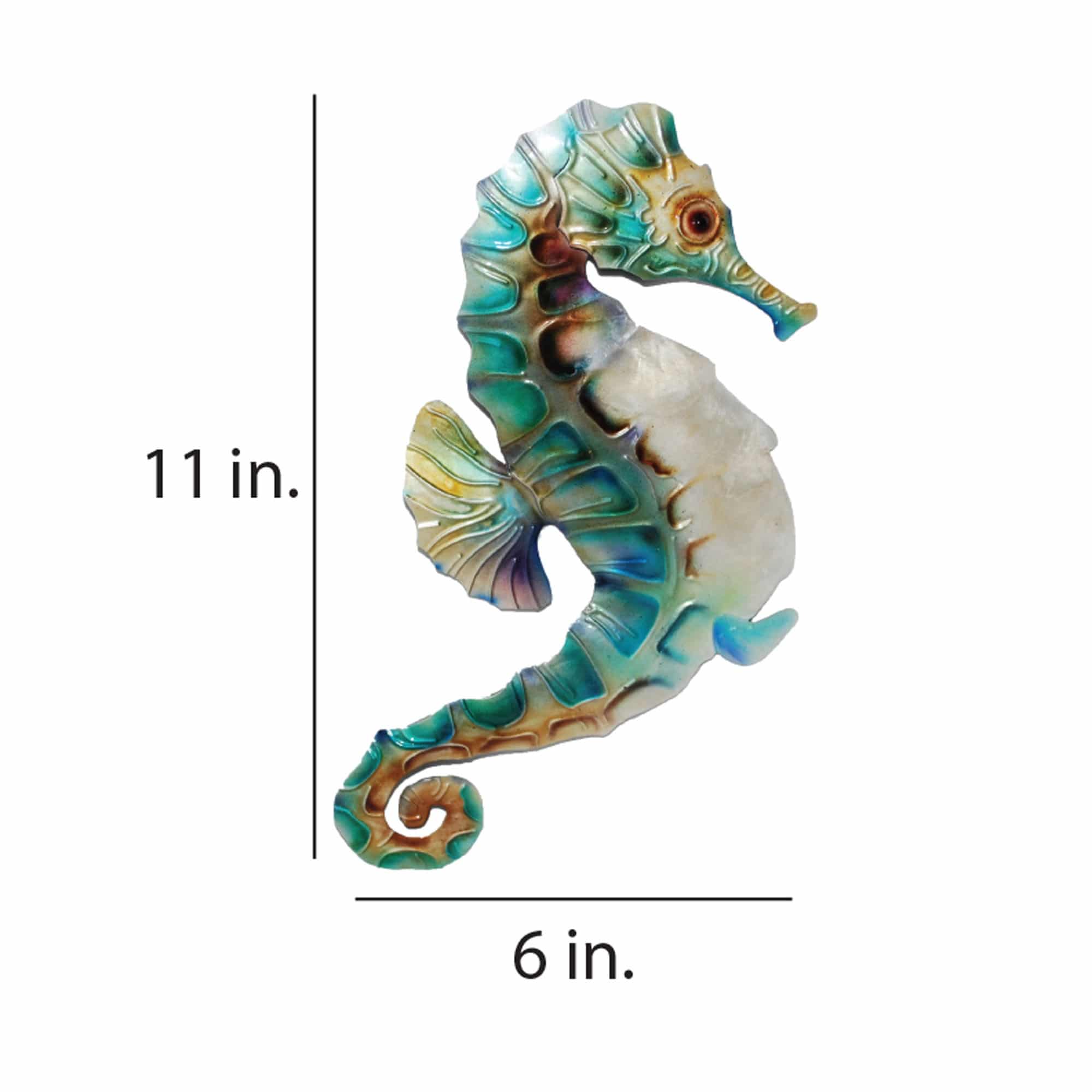
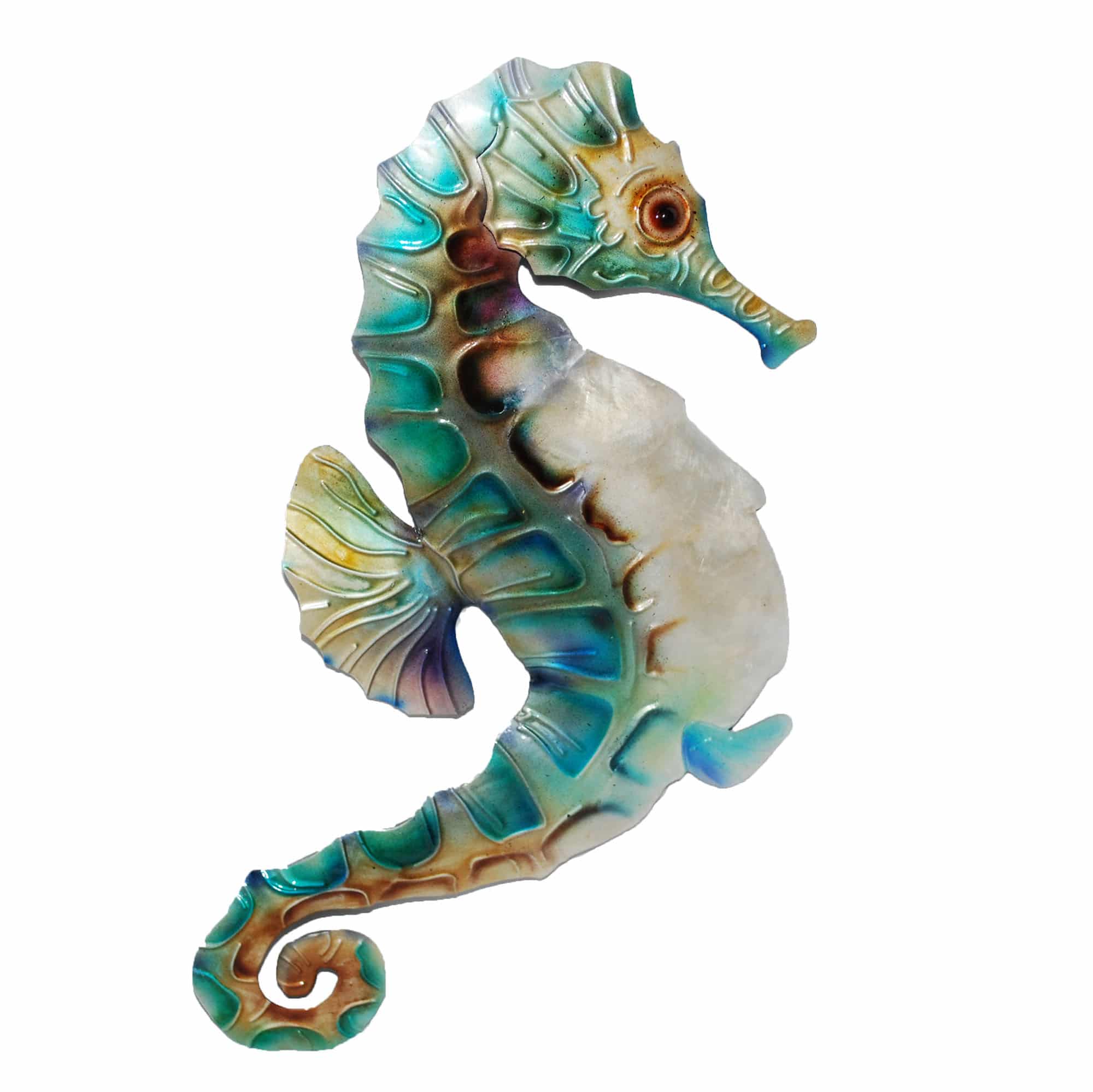 The seahorse has captured the minds and imaginations of people across all cultures for thousands of years. Seen as a symbol of good luck, strength and safety, this unique and beautiful animal is as charming as it is mysterious. The artist captures the beauty of the seahorse with a raised fine, high shine, hand-painted finish, and elegant mother of pearl chest and forefront. The basic frame of the wall seahorse is created using tin, which is powder coated as a black finish. Capiz is an oyster shell and the primary purpose of the oyster is as a source of food. However, the by-product, the shell, can be used for decoration. Due to it being a natural material, the natural colors of the capiz can come through as tans and browns.
The seahorse has captured the minds and imaginations of people across all cultures for thousands of years. Seen as a symbol of good luck, strength and safety, this unique and beautiful animal is as charming as it is mysterious. The artist captures the beauty of the seahorse with a raised fine, high shine, hand-painted finish, and elegant mother of pearl chest and forefront. The basic frame of the wall seahorse is created using tin, which is powder coated as a black finish. Capiz is an oyster shell and the primary purpose of the oyster is as a source of food. However, the by-product, the shell, can be used for decoration. Due to it being a natural material, the natural colors of the capiz can come through as tans and browns. -

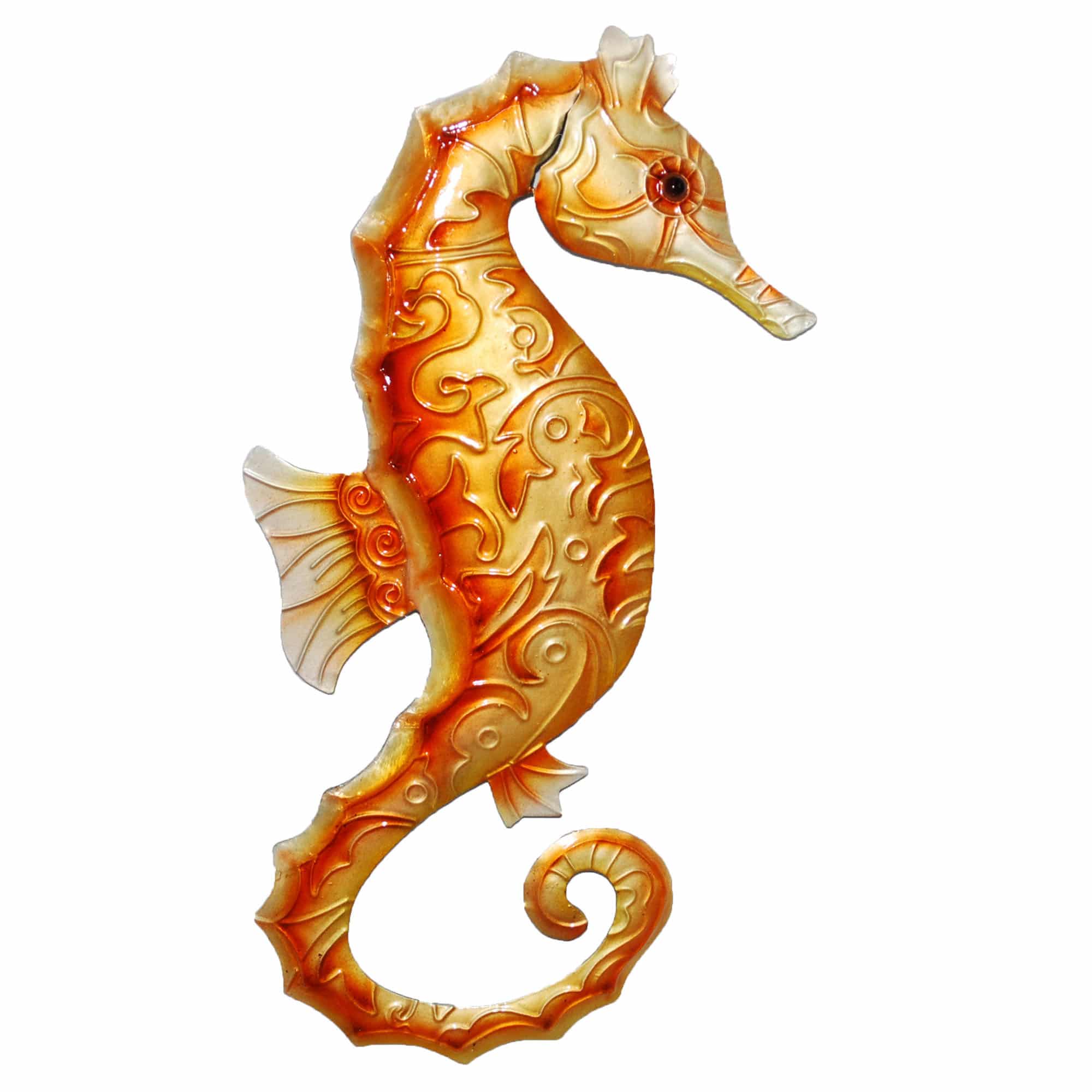 The seahorse has captured the minds and imaginations of people across all cultures for thousands of years. Seen as a symbol of good luck, strength and safety, this unique and beautiful animal is as charming as it is mysterious. The artist captures the beauty of the seahorse with a raised fine, high shine, hand-painted finish, and elegant mother of pearl chest and forefront. The basic frame of the wall seahorse is created using tin, which is powder coated as a black finish. Capiz is an oyster shell and the primary purpose of the oyster is as a source of food. However, the by-product, the shell, can be used for decoration. Due to it being a natural material, the natural colors of the capiz can come through as tans and browns.
The seahorse has captured the minds and imaginations of people across all cultures for thousands of years. Seen as a symbol of good luck, strength and safety, this unique and beautiful animal is as charming as it is mysterious. The artist captures the beauty of the seahorse with a raised fine, high shine, hand-painted finish, and elegant mother of pearl chest and forefront. The basic frame of the wall seahorse is created using tin, which is powder coated as a black finish. Capiz is an oyster shell and the primary purpose of the oyster is as a source of food. However, the by-product, the shell, can be used for decoration. Due to it being a natural material, the natural colors of the capiz can come through as tans and browns. -
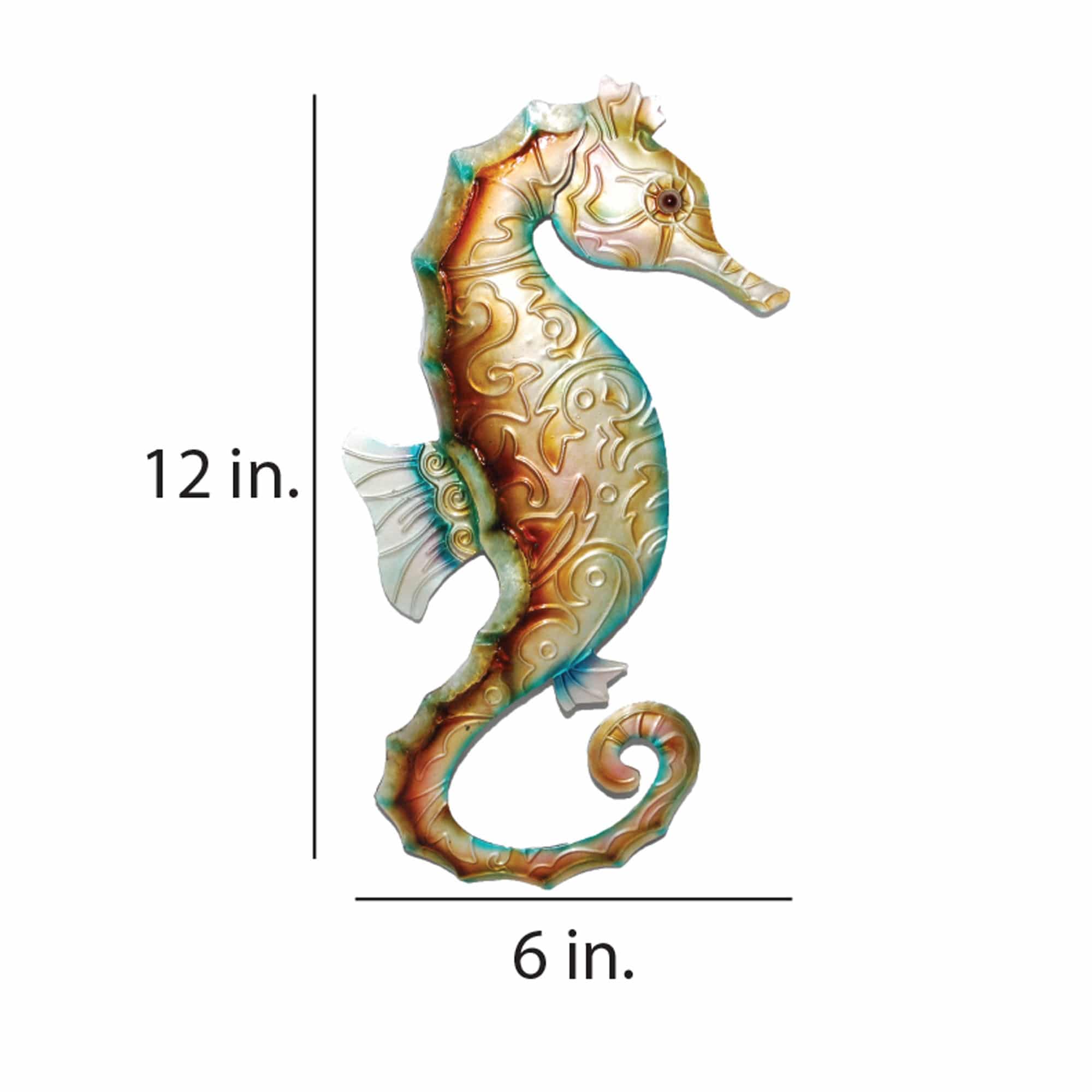
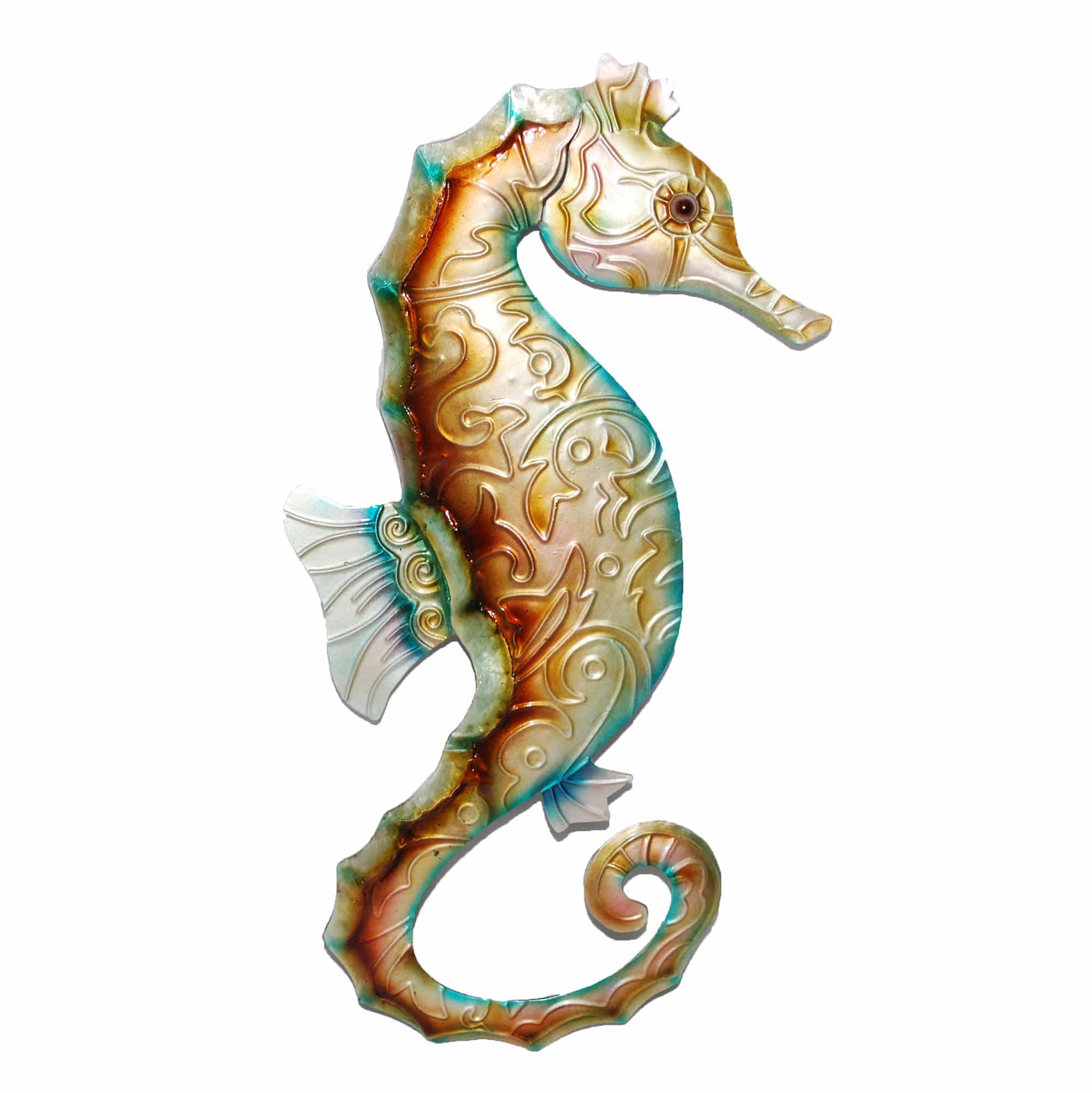 The seahorse has captured the minds and imaginations of people across all cultures for thousands of years. Seen as a symbol of good luck, strength and safety, this unique and beautiful animal is as charming as it is mysterious. The artist captures the beauty of the seahorse with a raised fine, high shine, hand-painted finish, and elegant mother of pearl chest and forefront. The basic frame of the wall seahorse is created using tin, which is powder coated as a black finish. Capiz is an oyster shell and the primary purpose of the oyster is as a source of food. However, the by-product, the shell, can be used for decoration. Due to it being a natural material, the natural colors of the capiz can come through as tans and browns.
The seahorse has captured the minds and imaginations of people across all cultures for thousands of years. Seen as a symbol of good luck, strength and safety, this unique and beautiful animal is as charming as it is mysterious. The artist captures the beauty of the seahorse with a raised fine, high shine, hand-painted finish, and elegant mother of pearl chest and forefront. The basic frame of the wall seahorse is created using tin, which is powder coated as a black finish. Capiz is an oyster shell and the primary purpose of the oyster is as a source of food. However, the by-product, the shell, can be used for decoration. Due to it being a natural material, the natural colors of the capiz can come through as tans and browns. -
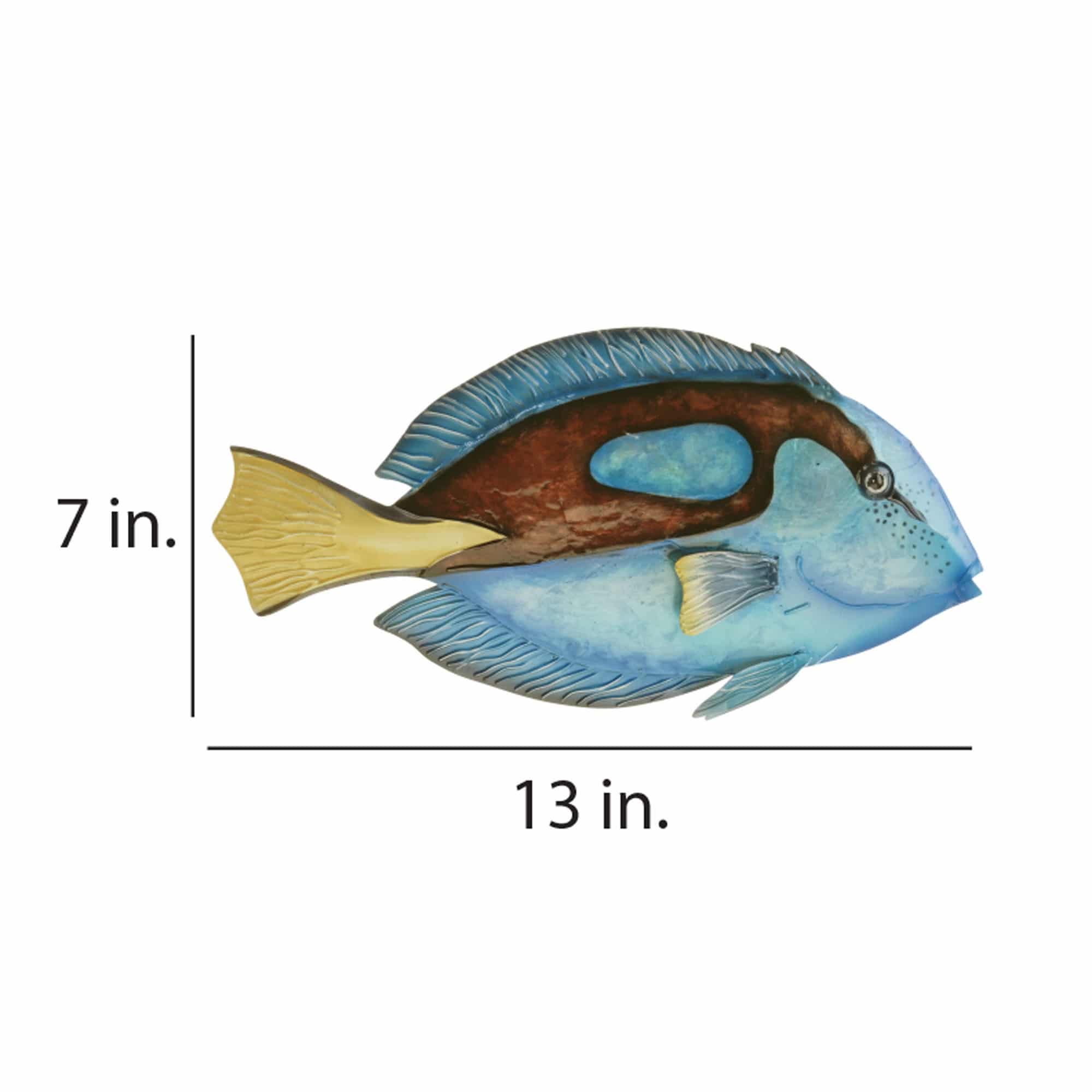
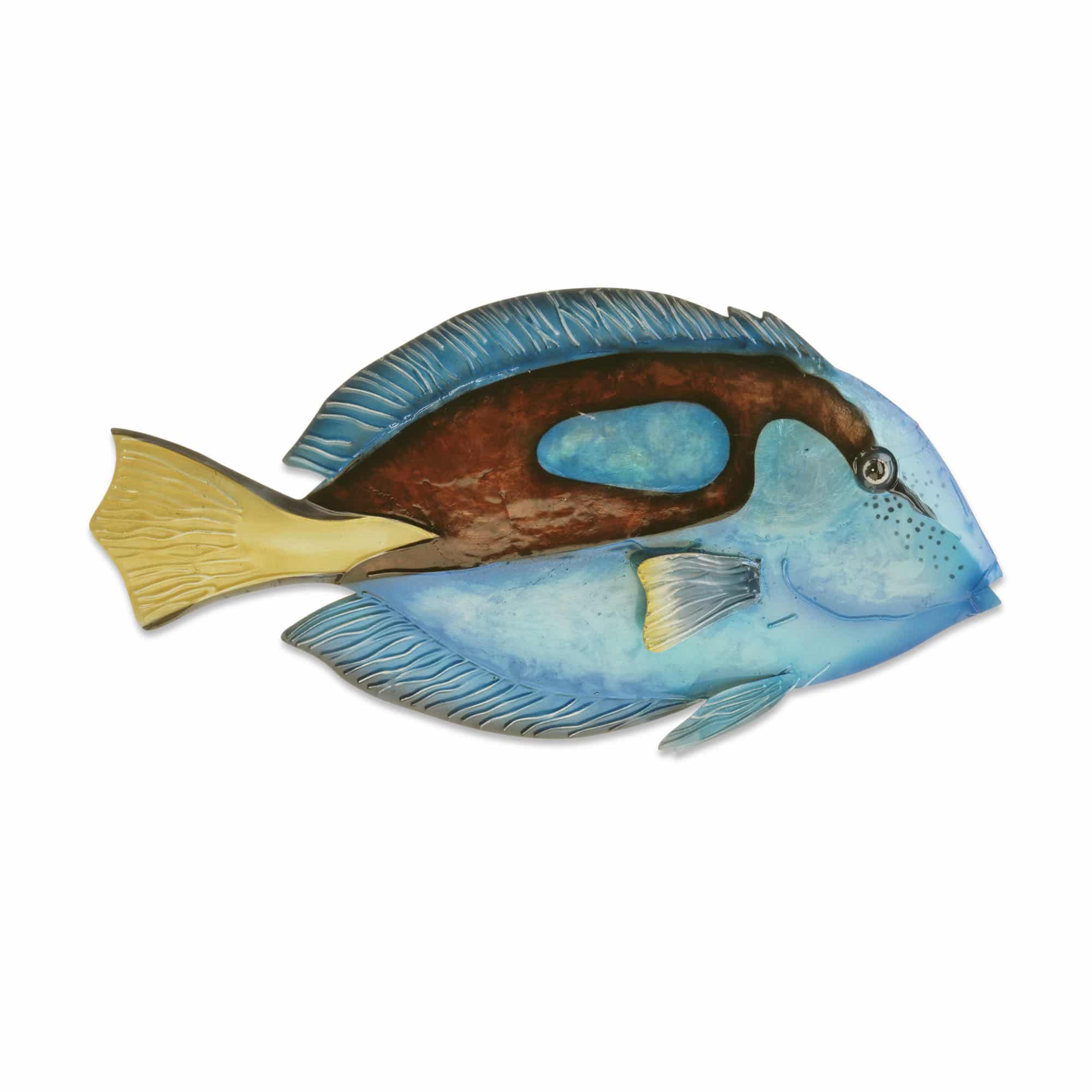 The Blue Tang is a member of a family of fish called durgeonfish. Covering a huge area, this animal can be fround from New York to Brazil. The word tang refers to sharp spines along each side which are said to resemble the scalpel of a surgeon. The artist captures the bright blues and stark blacks that make this species so recognizable and popular. The basic frame of the wall fish is created using tin, which is powder coated as a black finish. The frame is reinforced using wrought iron wire along the inner edge. Capiz is an oyster shell and the primary purpose of the oyster is as a source of food. However, the by-product, the shell, can be used for decoration.
The Blue Tang is a member of a family of fish called durgeonfish. Covering a huge area, this animal can be fround from New York to Brazil. The word tang refers to sharp spines along each side which are said to resemble the scalpel of a surgeon. The artist captures the bright blues and stark blacks that make this species so recognizable and popular. The basic frame of the wall fish is created using tin, which is powder coated as a black finish. The frame is reinforced using wrought iron wire along the inner edge. Capiz is an oyster shell and the primary purpose of the oyster is as a source of food. However, the by-product, the shell, can be used for decoration. -
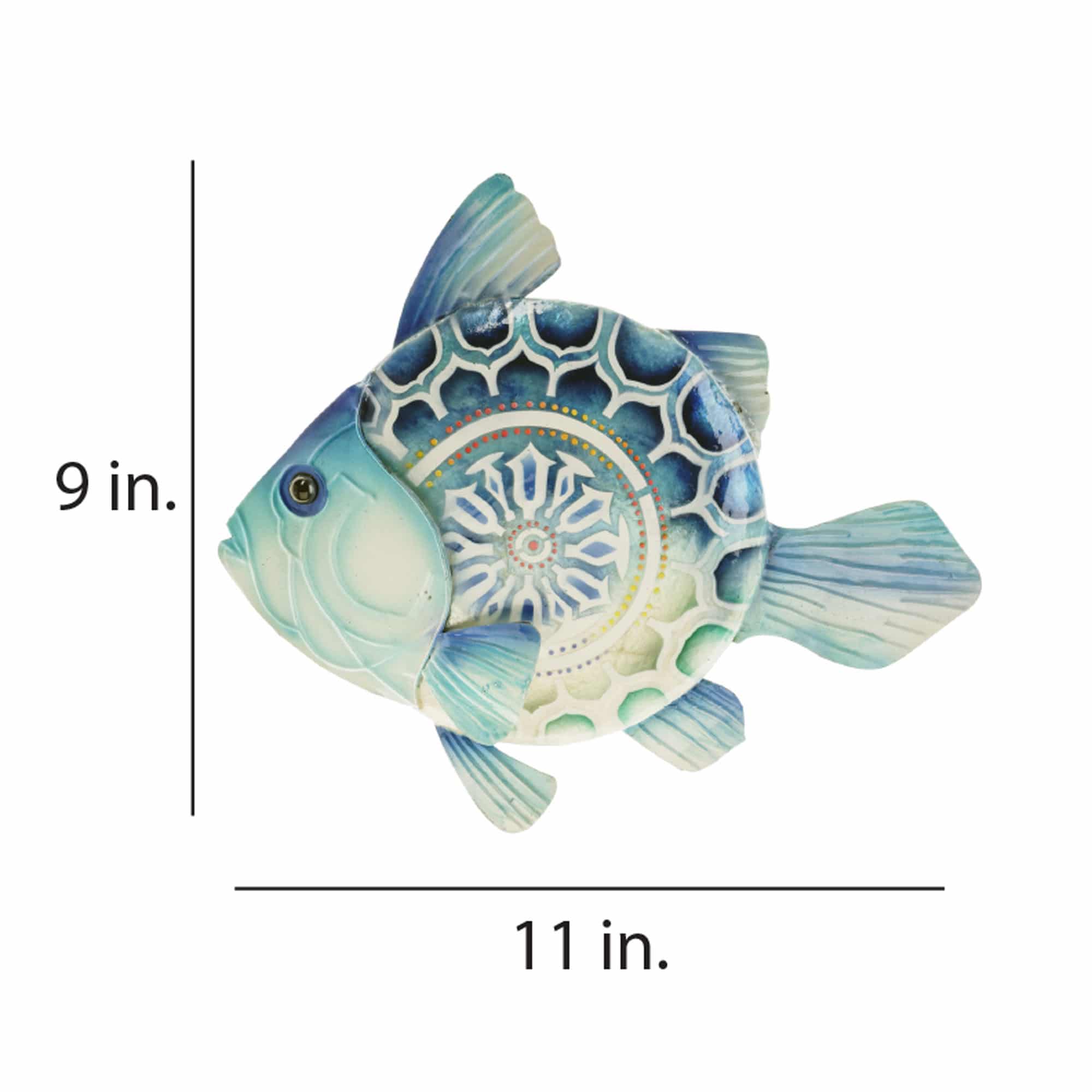
 This fish is an artist's interpretation of the blue sea bass. The rich blue tones are common not only on the fish, but also the water within which it resides. The spiky fines and the scaly skin are also captured by the artist. The center of the fish is most interesting as it is adorned with capiz shell, which is hand-painted in wavy lines, representing the movement of the ocean as well as the fish. This piece will bring in color and design to your space and a smile to your face. The basic frame of the wall fish is created using tin, which is powder coated as a black finish. The frame is reinforced using wrought iron wire along the inner edge. Capiz is an oyster shell and the primary purpose of the oyster is as a source of food. However, the by-product, the shell, can be used for decoration. Due to it being a natural material, the natural colors of the capiz can come through as tans and browns underneath the paint.
This fish is an artist's interpretation of the blue sea bass. The rich blue tones are common not only on the fish, but also the water within which it resides. The spiky fines and the scaly skin are also captured by the artist. The center of the fish is most interesting as it is adorned with capiz shell, which is hand-painted in wavy lines, representing the movement of the ocean as well as the fish. This piece will bring in color and design to your space and a smile to your face. The basic frame of the wall fish is created using tin, which is powder coated as a black finish. The frame is reinforced using wrought iron wire along the inner edge. Capiz is an oyster shell and the primary purpose of the oyster is as a source of food. However, the by-product, the shell, can be used for decoration. Due to it being a natural material, the natural colors of the capiz can come through as tans and browns underneath the paint. -
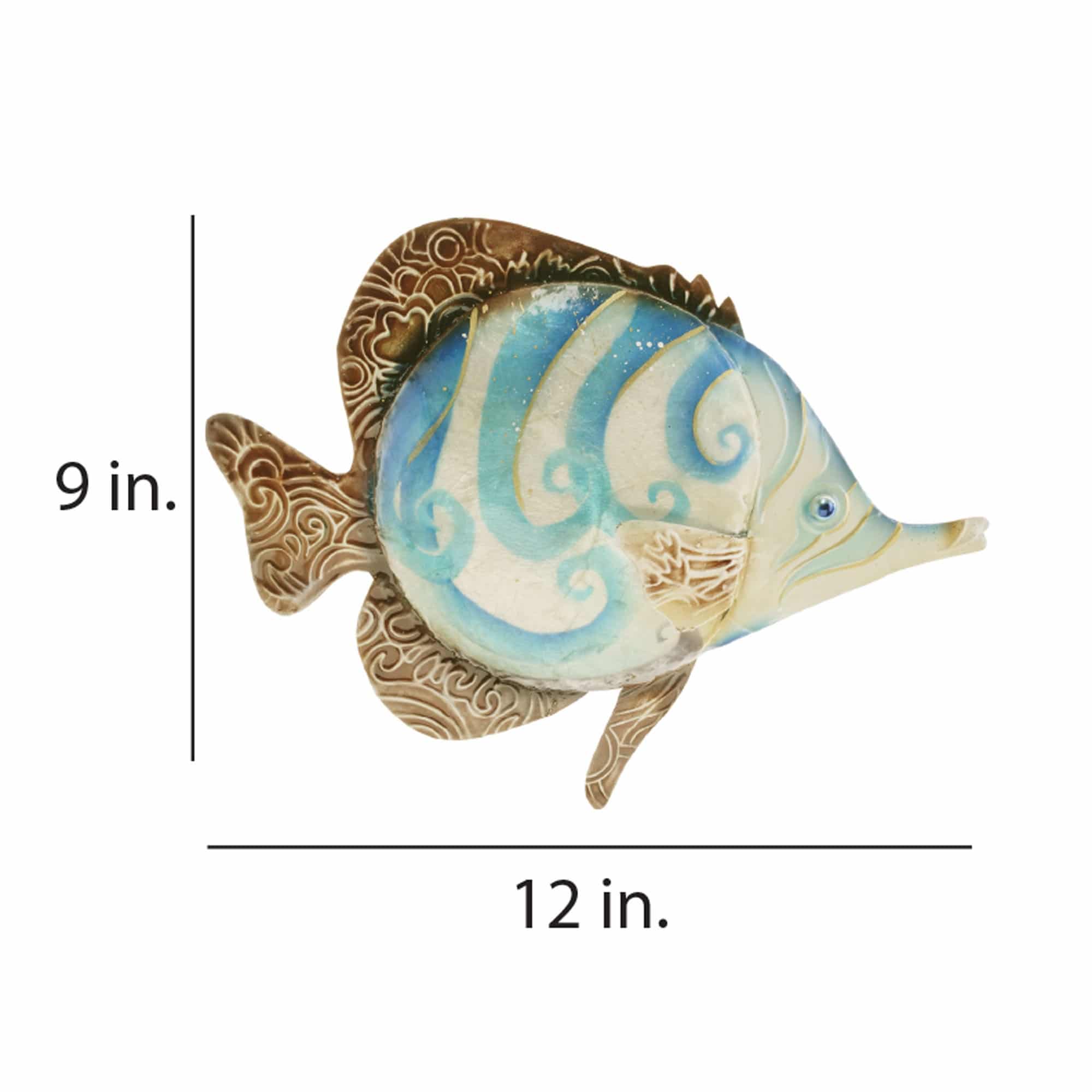
 This fish was inspired by the Copperband Butterfly Fish. Though the name is a mouthful, the artist did capture the strips, colors, broad fins, and the beak that this fish is known for. The blue and pearl swirls contrast with its deeper bronze fins. Those fins are further enhanced with a swirled design, creating a very complex piece. The results is a piece rich in design and color. The basic frame of the wall fish is created using tin, which is powder coated as a black finish. The frame is reinforced using wrought iron wire along the inner edge. Capiz is an oyster shell and the primary purpose of the oyster is as a source of food. However, the by-product, the shell, can be used for decoration. Due to it being a natural material, the natural colors of the capiz can come through as tans and browns underneath the paint.
This fish was inspired by the Copperband Butterfly Fish. Though the name is a mouthful, the artist did capture the strips, colors, broad fins, and the beak that this fish is known for. The blue and pearl swirls contrast with its deeper bronze fins. Those fins are further enhanced with a swirled design, creating a very complex piece. The results is a piece rich in design and color. The basic frame of the wall fish is created using tin, which is powder coated as a black finish. The frame is reinforced using wrought iron wire along the inner edge. Capiz is an oyster shell and the primary purpose of the oyster is as a source of food. However, the by-product, the shell, can be used for decoration. Due to it being a natural material, the natural colors of the capiz can come through as tans and browns underneath the paint. -
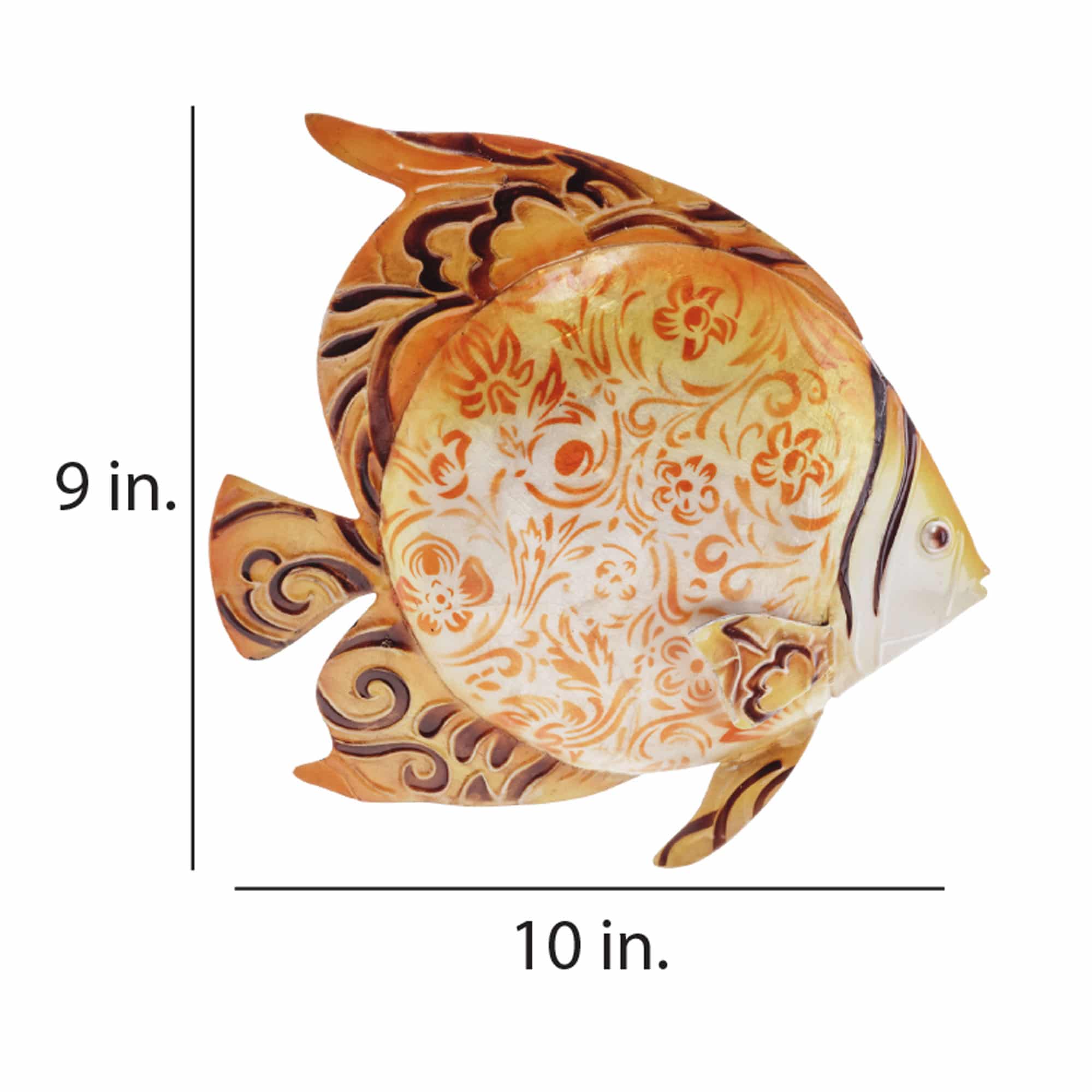
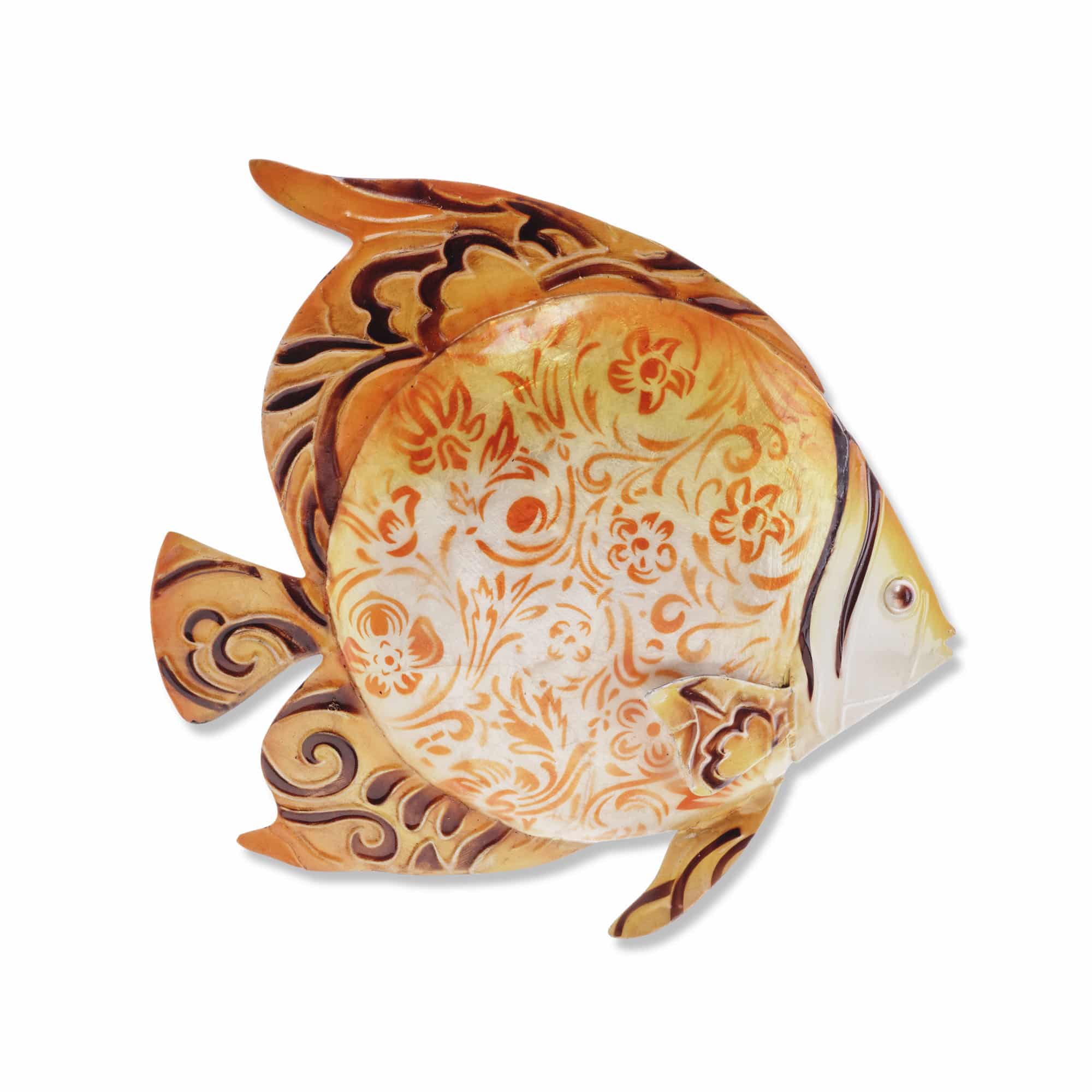 It's big. It's round and it's called an Opah. It looks like a goldfish that seriously outgrew its bowl. The Opah's bright orange is represented in this piece. Instead of spots, the artist took license and painted intricate floral patterns on top of capiz shells. The artist continues by pressing patterns into the tin both in the fins and the face of this magnificent fish. The basic frame of the wall fish is created using tin, which is powder coated as a black finish. The frame is reinforced using wrought iron wire along the inner edge. Capiz is an oyster shell and the primary purpose of the oyster is as a source of food. However, the by-product, the shell, can be used for decoration. Due to it being a natural material, the natural colors of the capiz can come through as tans and browns underneath the paint.
It's big. It's round and it's called an Opah. It looks like a goldfish that seriously outgrew its bowl. The Opah's bright orange is represented in this piece. Instead of spots, the artist took license and painted intricate floral patterns on top of capiz shells. The artist continues by pressing patterns into the tin both in the fins and the face of this magnificent fish. The basic frame of the wall fish is created using tin, which is powder coated as a black finish. The frame is reinforced using wrought iron wire along the inner edge. Capiz is an oyster shell and the primary purpose of the oyster is as a source of food. However, the by-product, the shell, can be used for decoration. Due to it being a natural material, the natural colors of the capiz can come through as tans and browns underneath the paint. -
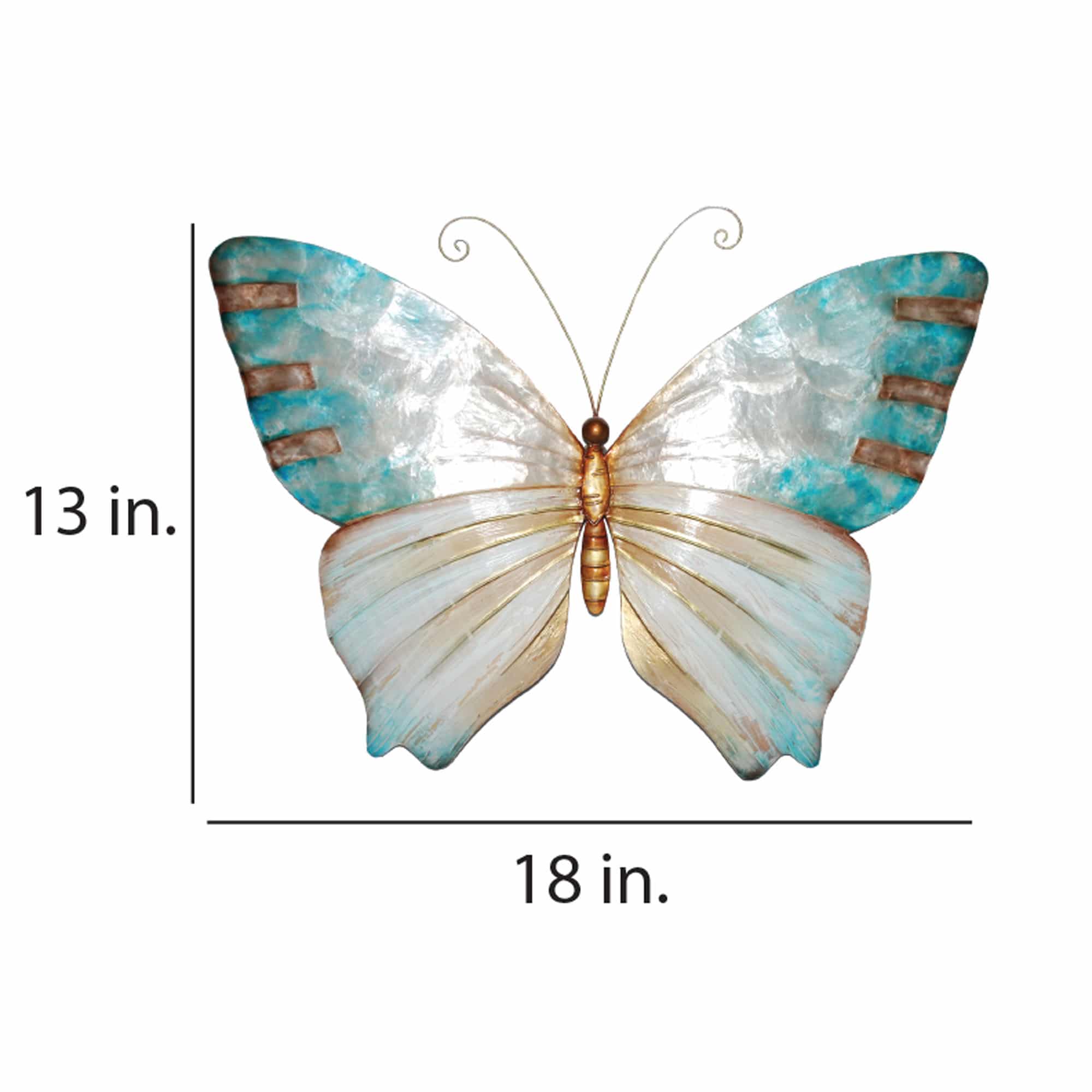
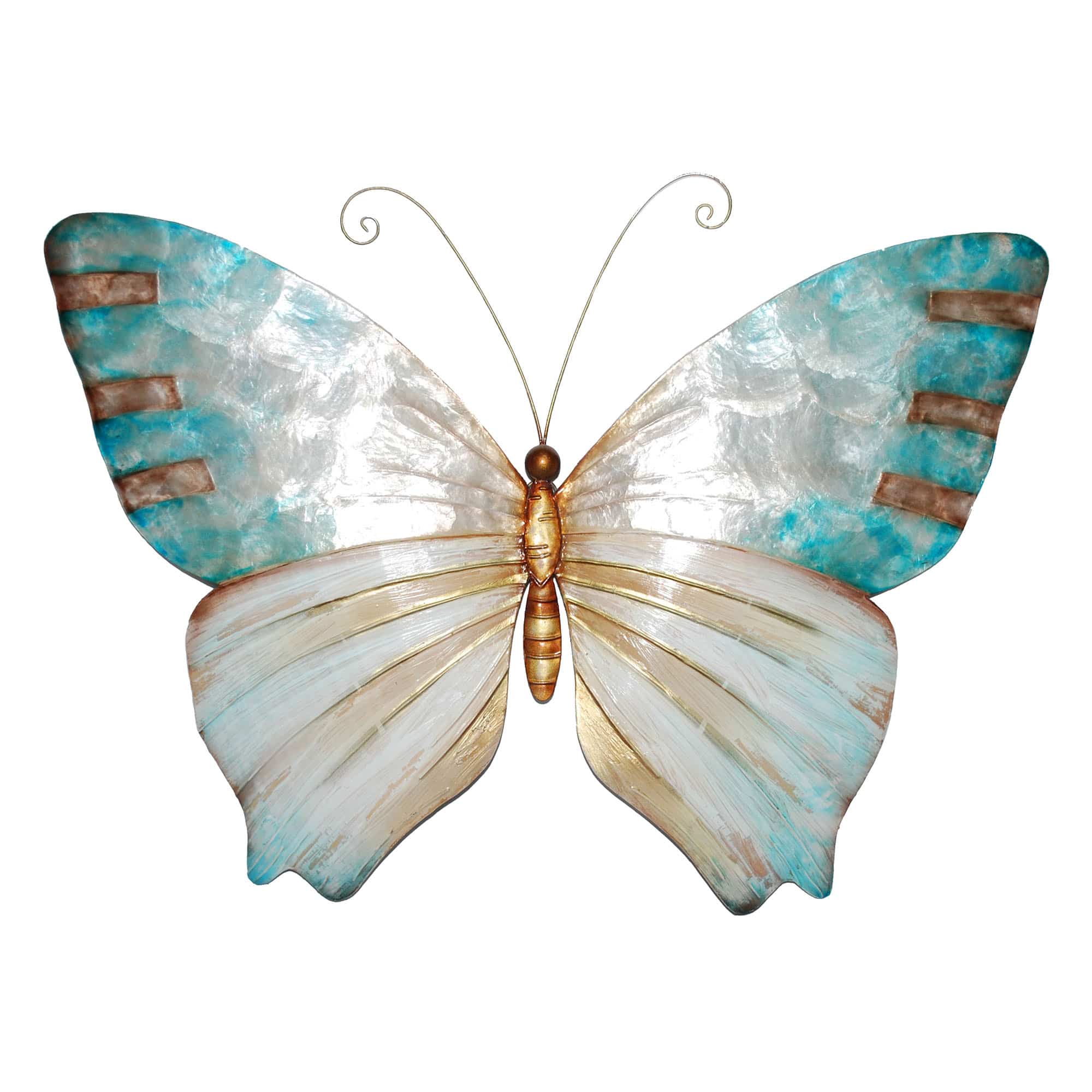
Soft aqua rises from the wine tips and casually blends into cool pearl tones along the top wings of this butterfly. Contrasting that aqua are warm, subtle golds and browns. A bright metallic central body brings these components together in an elegant and graceful form.
The basic frame of the butterfly is created using tin, which is powder-coated with a black finish and makes this piece safe to use outdoors. The edges of the frame are reinforced using thicker tin wire. The front of this piece is adorned in areas with capiz shell, an oyster native to the Philippines, before being hand-painted and sealed with a water-based sealant. The primary purpose of this oyster to provide a source of food, however, the shell is a sustainable by-product that can be used for decoration. The capiz shell subtly replicates the reflective qualities of butterflies in nature. The entire piece is lightweight and has an eyelet in the back allowing it to be hung using a finishing nail, command strip, or a push pin. Due to it being a natural material, the organic colors of capiz come through as tans and browns underneath the paint.
-
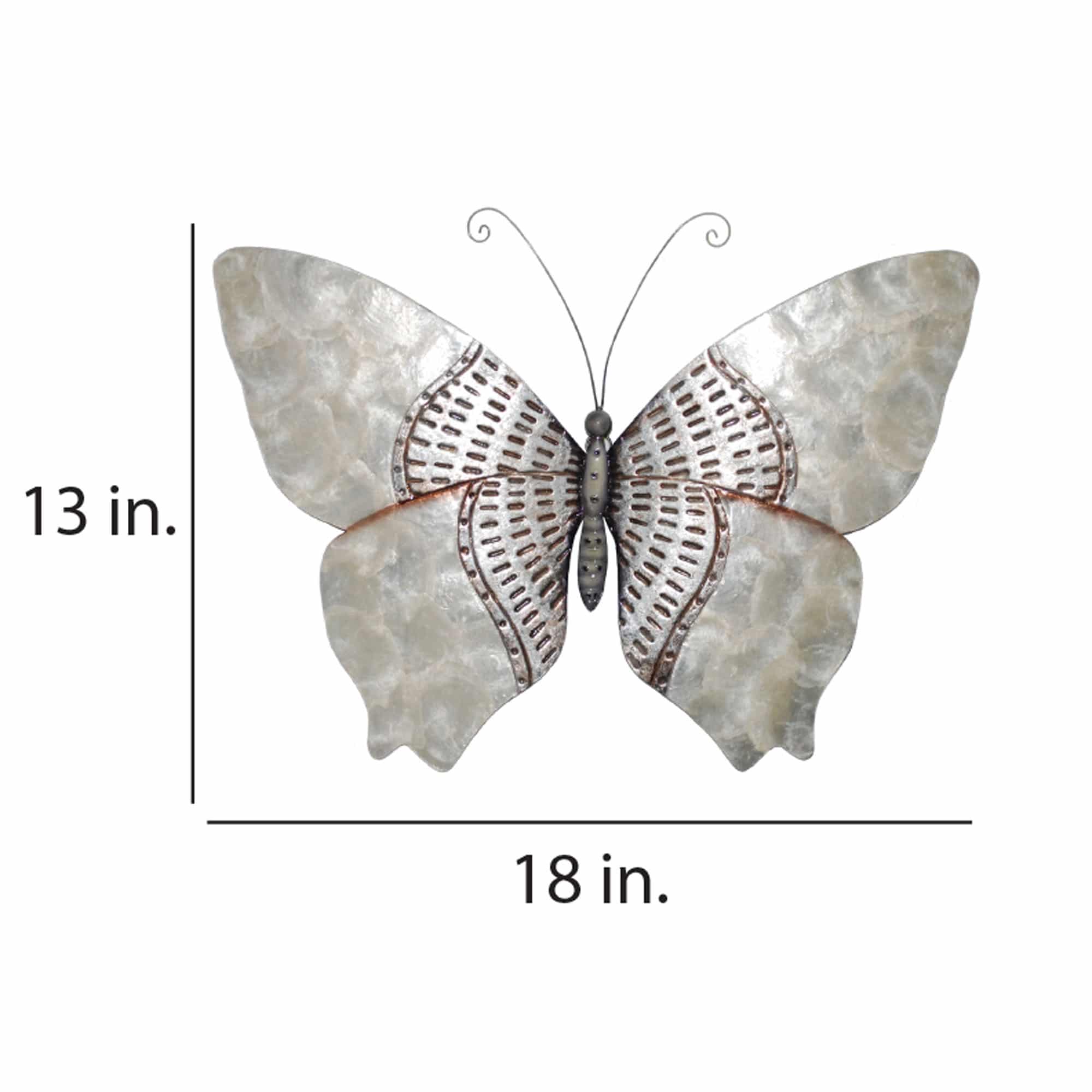
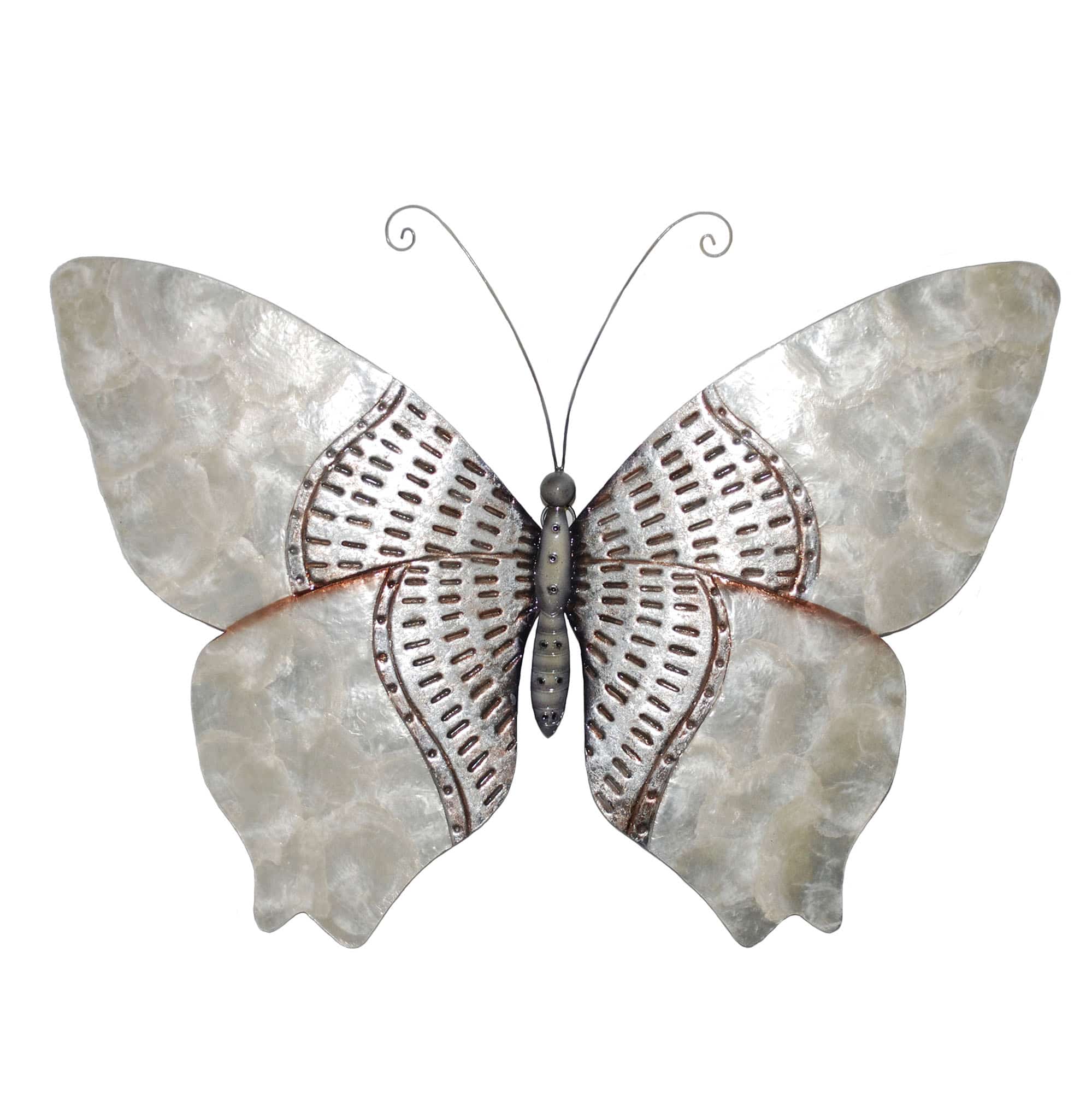
With an almost silvery shimmer, this capiz adorned butterfly features feathery lines of shell radiating from its central core. This is punctuated with strong dashed lines done in a rusty metal finish that also spread from its body. Cool, calm, and beautiful, this butterfly emanates sophistication.
The basic frame of the butterfly is created using tin, which is powder-coated with a black finish and makes this piece safe to use outdoors. The edges of the frame are reinforced using thicker tin wire. The front of this piece is adorned in areas with capiz shell, an oyster native to the Philippines, before being hand-painted and sealed with a water-based sealant. The primary purpose of this oyster to provide a source of food, however, the shell is a sustainable by-product that can be used for decoration. The capiz shell subtly replicates the reflective qualities of butterflies in nature. The entire piece is lightweight and has an eyelet in the back allowing it to be hung using a finishing nail, command strip, or a push pin. Due to it being a natural material, the organic colors of capiz come through as tans and browns underneath the paint.
-
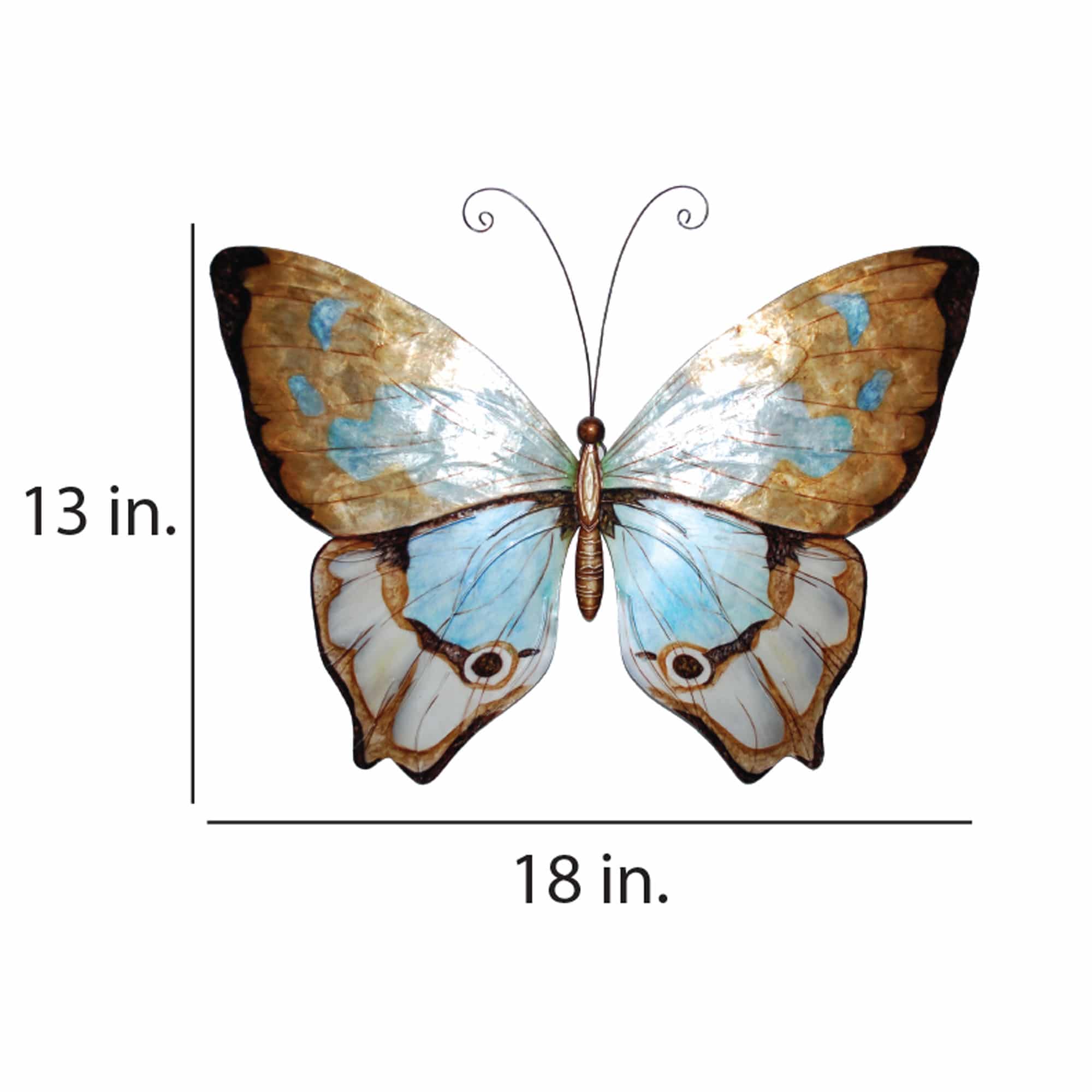
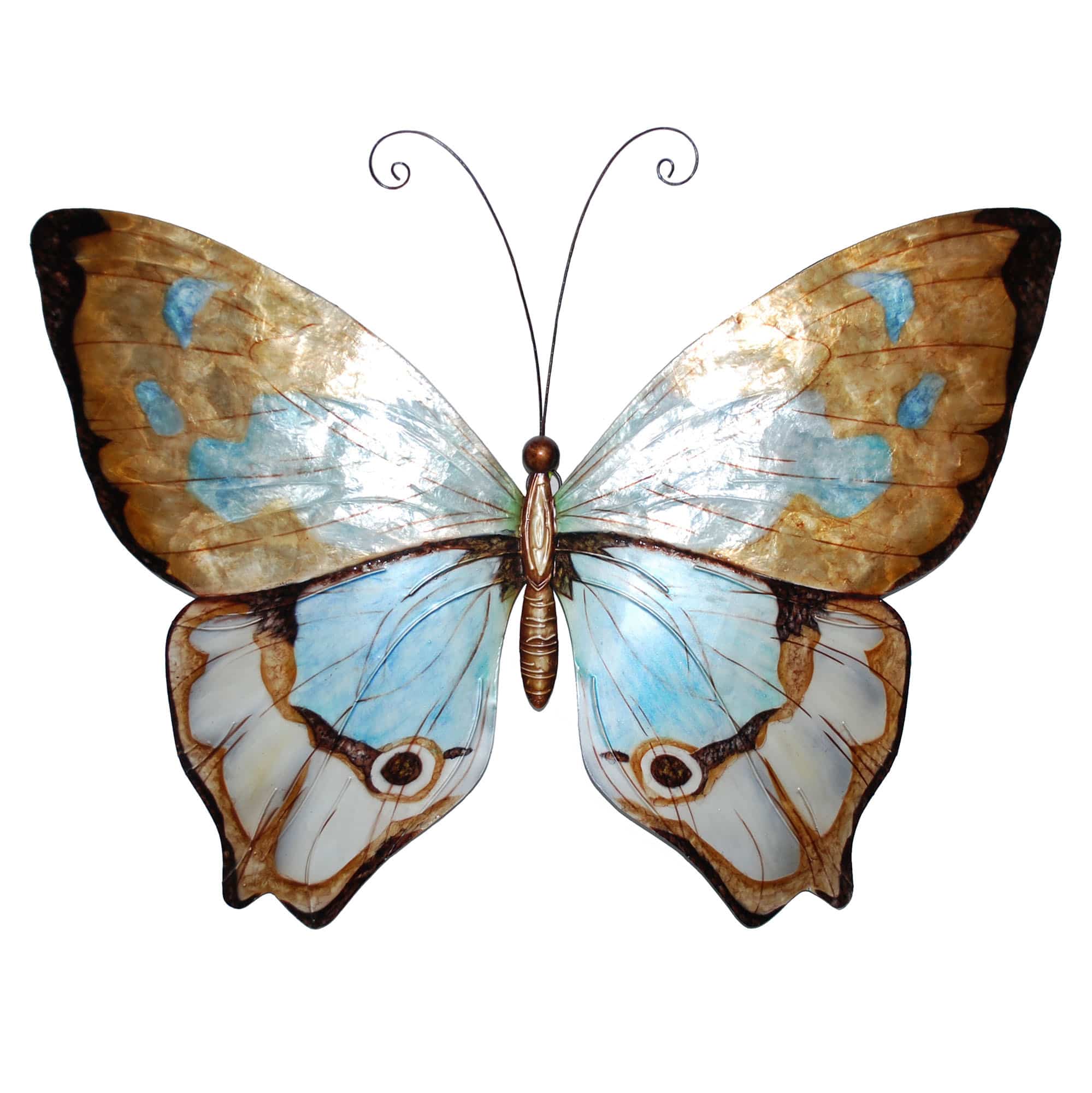
This butterfly features classic butterfly patterns with is mottled upper wings and its dotted lower section. The warm copper tones contrast with the contemporary blues to take this naturally feeling piece in a direction that works in both contemporary and traditional settings. Its neutral in tone while still exuding warmth.
The basic frame of the butterfly is created using tin, which is powder-coated with a black finish and makes this piece safe to use outdoors. The edges of the frame are reinforced using thicker tin wire. The front of this piece is adorned in areas with capiz shell, an oyster native to the Philippines, before being hand-painted and sealed with a water-based sealant. The primary purpose of this oyster to provide a source of food, however, the shell is a sustainable by-product that can be used for decoration. The capiz shell subtly replicates the reflective qualities of butterflies in nature. The entire piece is lightweight and has an eyelet in the back allowing it to be hung using a finishing nail, command strip, or a push pin. Due to it being a natural material, the organic colors of capiz come through as tans and browns underneath the paint.
-
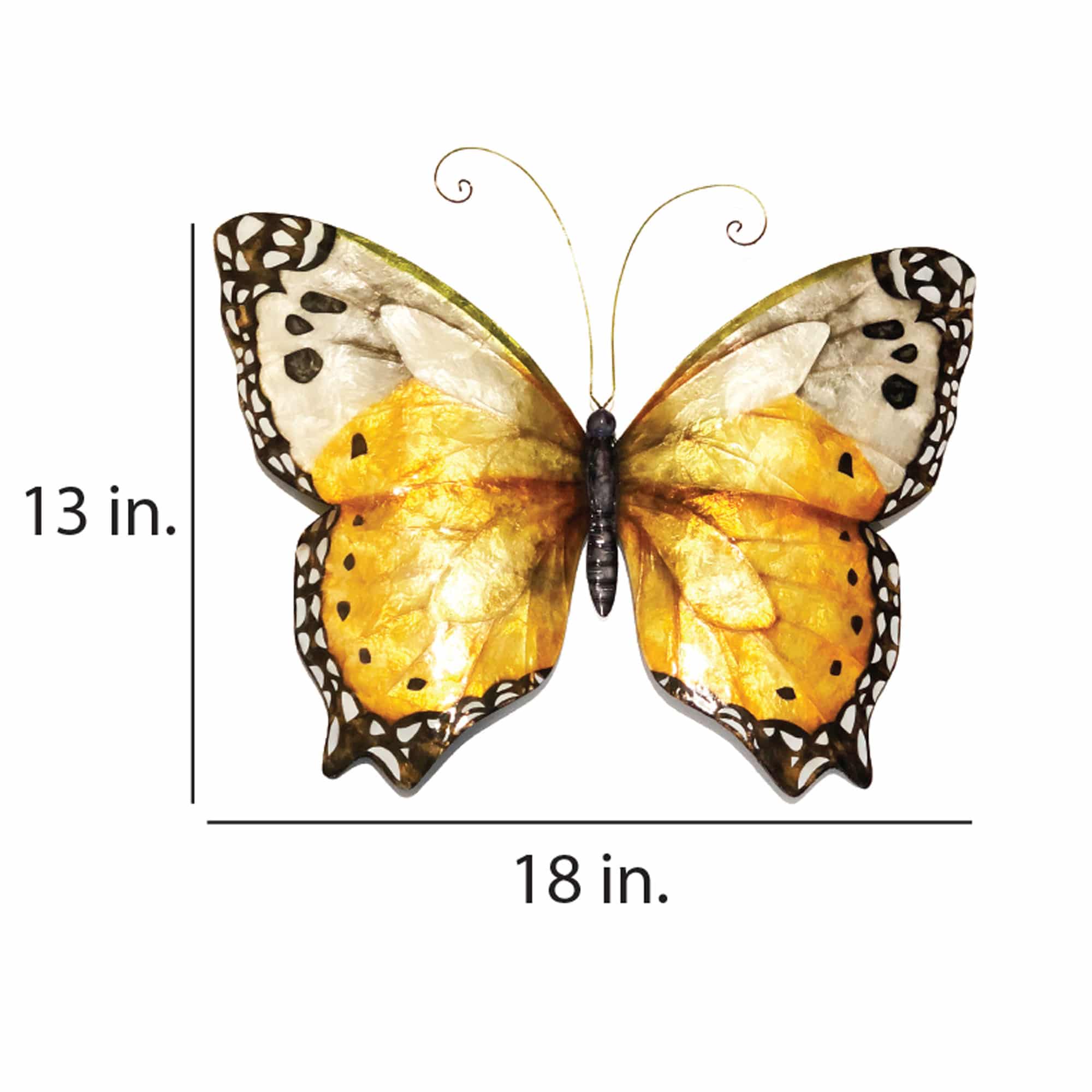
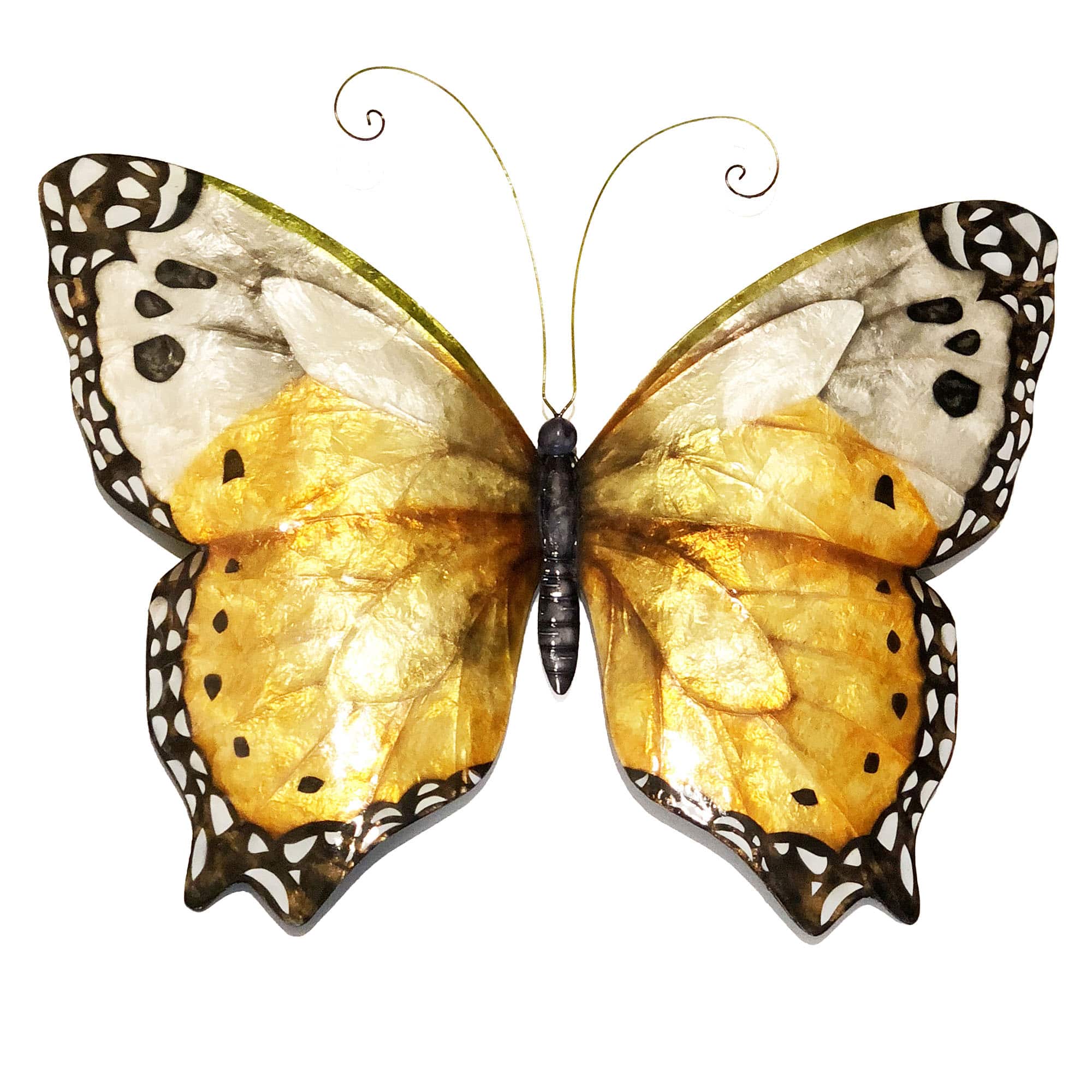
The monarch butterfly is one of the most recognizable butterflies in the world. Its bright orange makes it easily recognizable and it is frequently called the king of butterflies. With long migration patterns, monarchs go through several generations as they travel across the continent each year.
The basic frame of the butterfly is created using tin, which is powder-coated with a black finish and makes this piece safe to use outdoors. The edges of the frame are reinforced using thicker tin wire. The front of this piece is adorned in areas with capiz shell, an oyster native to the Philippines, before being hand-painted and sealed with a water-based sealant. The primary purpose of this oyster to provide a source of food, however, the shell is a sustainable by-product that can be used for decoration. The capiz shell subtly replicates the reflective qualities of butterflies in nature. The entire piece is lightweight and has an eyelet in the back allowing it to be hung using a finishing nail, command strip, or a push pin. Due to it being a natural material, the organic colors of capiz come through as tans and browns underneath the paint.
-
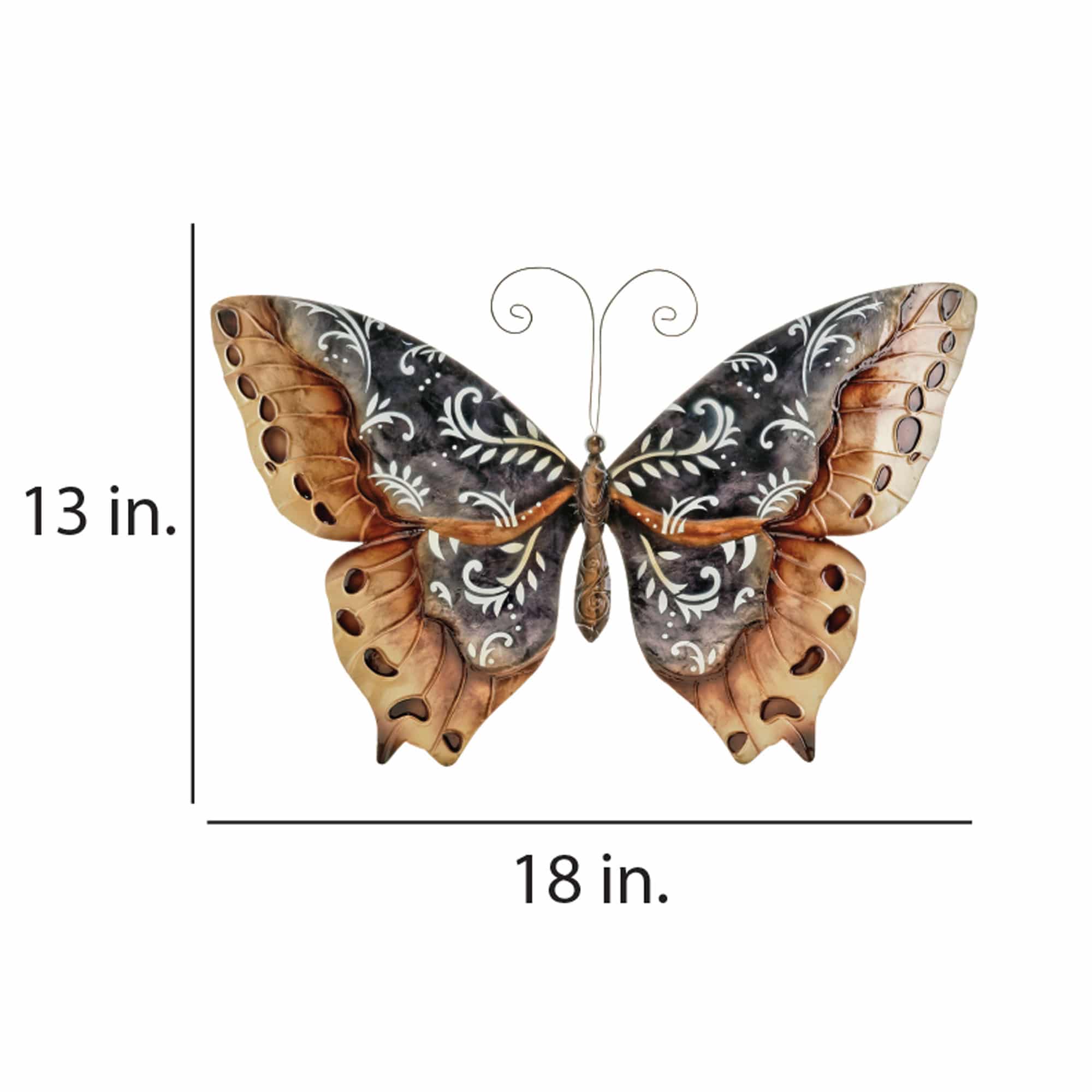

Bold copper sets next to deep metallics with a traditional scrolling leaf pattern. The combination provides a neutral, bold, traditional feel that will add strong access and emphasis to a space. The darker sections are further enhanced by an underlay of capiz shell which adds a subtle shell pattern as well as shimmer.
The basic frame of the butterfly is created using tin, which is powder-coated with a black finish and makes this piece safe to use outdoors. The edges of the frame are reinforced using thicker tin wire. The front of this piece is adorned in areas with capiz shell, an oyster native to the Philippines, before being hand-painted and sealed with a water-based sealant. The primary purpose of this oyster to provide a source of food, however, the shell is a sustainable by-product that can be used for decoration. The capiz shell subtly replicates the reflective qualities of butterflies in nature. The entire piece is lightweight and has an eyelet in the back allowing it to be hung using a finishing nail, command strip, or a push pin. Due to it being a natural material, the organic colors of capiz come through as tans and browns underneath the paint.



